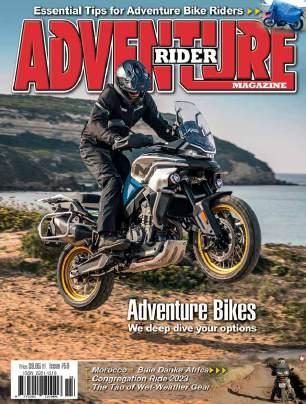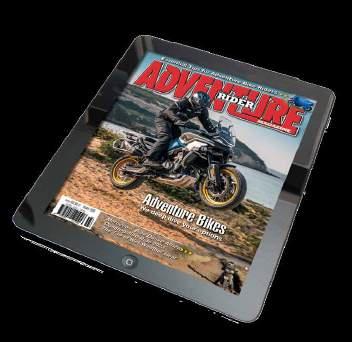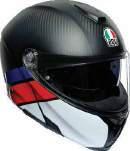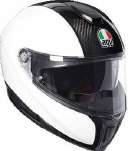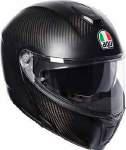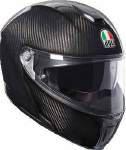
















Welcome to Edition 59 and one that offers an excellent exchange of views on adventure riding tips and adventure riding essentials between our Facebook subscribers/members and adventure motorcyclist and author Stephen Lambert.
Boris Mihailovic follows with an excellent coverage of 2023 adventure motorcycles. In the mix you will see two members of our community and their recent purchases.
The Our Community pages are sponsored by Cape York Motorcycle Tours and we are thrilled that they have won TripAdvisor’s People’s Choice Award for 2023. So well deserved. Adventure Magazine Subscriber Anita Eley will be joining Cape York in August 2024 along with author and adventurer Heather Ellis for a 7-day tour that we will feature.
As an industry partner, you will meet Sean Goldhawk – Marketing Manager of Yamaha Australia – and see his props out
there adventuring.
Along with the excellent advice offered in his edition, comes a ‘Street Smarts’ guide from Heather Ellis. A must read for those embarking on adventure motorcycling overseas.
Read on to find out why Graeme Sedgewick thanks Africa, how the Dakar Rally could become ‘green’, and how Boris responds to the rain and the concept of wet-weather gear.
Part 2 of Ready Jimbob answers if that whack of the tree branch ended the ride and we welcome a new writer Holly Fields with her take on Becoming Adventurous. Also, welcome Aron Berkery and his soujourn into the depths of Yengo and beyond. This story is also a commentary on a rider training experience; a topic that will be covered further in Edition 60.
Andy Strapz waxes lyrical on gear selection, and Sunny Motographer delights the senses with glorious photos of Morocco.
Might I recommend the 2023


Congregation Ride to Grey Gum Café. Everyone is welcome no matter what motorcycle you ride and even if, this year, you’re in an old ute. You can be as social as you like or just enjoy the atmosphere and band Saturday night and enjoy the warmth of the braziers. The food is great; the venue is licenced and there is no cost. This said, tips for the
“ Congregation Ride to Grey Gum Café. Everyone is welcome no matter what motorcycle you ride and even if, this year, you’re in an old ute. ”
band are more than welcome so think about this on Saturday evening. If you’d like to attend but would prefer not to ride alone, please come to our Facebook page and ask for rider support. https://www.facebook.com/ AdventureRiderMagazine
To gauge approximate numbers and to be considerate of the café, if you are going to attend, please email with your RSVP yourview@clemengermediasales.com.au

Left: A good reason to celebrate, the boys at Cape York Motorcycle Tours have won TripAdvisor’s People’s Choice Award for 2023.





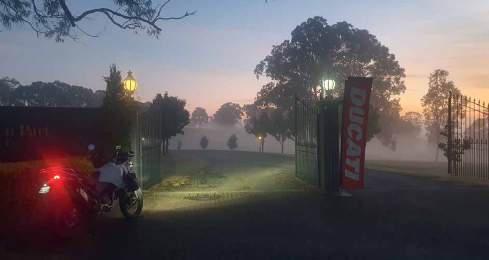


Adventure Rider Magazine is published bimonthly by Clemenger Media.
CEO Tony Clemenger
Contributors
Boris Mihailovic, Heather Ellis, Steve Lambert, Holly Fields, Graeme Sedgwick, Pablo Pillado AND others
(If you would like a chance to have your adventure in print = please email susan.plunkett@clemengermediasales.com.au
Thanks to Jordan Kunda, Louise Tingate and Sean Goldhawk (Yamaha).
Design
Danny Bourke Southern-bear@bigpond.com.au
Subscriptions
Phone: 1800 995 007
Website: www.advridermag.com.au
Copyright
Adventure Rider Magazine is owned by Clemenger Consulting –Clemenger Media Sales and published by Tony Clemenger. All material in Adventure Rider Magazine is copyright and no part may be reproduced or copied in any form or by any means (graphic, electronic or mechanical including information and retrieval systems) without written permission of the publisher. We welcome ALL contributions but reserve the right to accept or reject any material. While every effort has been made to ensure the accuracy of information, Clemenger will not accept responsibility for errors or omissions or for any consequences arising from reliance on information published. The opinions expressed in Adventure Rider Magazine are not necessarily the opinions of, or endorsed by, the publisher unless otherwise stated.
© Copyright Clemenger Consulting, 2023
Articles
All articles submitted for publication become the property of the publisher. Editors reserve the right to adjust any article to conform with the magazine format.
L1 397 Chapel Street South Yarra 3141 P: +61 1800 995 007 tony.clemenger@clemengermediasales.com.au www.clemengermediasales.com.au

Official lubricant partner
Like to add your own responses? Send to yourview@clemengermediasales.com.au:
Five tips (gained from experience) you would give a new rider about adventure riding?
Carry a Personal Beacon Locator and let family know where you heading out to.
KD Suvarna
Learn road riding: 90% of your time will be on roads getting to where you want to be. Boys on scramblers know zip about the dangers of the road user not equipped to handle bikes coming past them in groups.
George Jones

1: Dirt is not the same as the asphalt, treat with diligence and care, you too will be one with the dirt, unless you like “dirt” then eat “dirt” and laugh it off.
2: Practice doesn’t have to be tedious, stand up eyes up stay up, get familiar with the bike moving underneath you and it will eventually wont only be when your falling.
3: Check your gear, double check your gear, triple your gear, get that pump because you don’t want to hand pump up your tires but check your gear to make sure your not carrying too much.
4: Talk to people, it helps you when your in trouble and you might learn a thing or two about the trip, a piece of equipment or about your bike.
5: Rubbers are important! Not just the jiggy jiggy kind either, tyres can make all the difference, don’t use a Road tire if your going Toby price Dakar style.
(Bonus) 6: Have fun! Stay upright (most of the time), laugh when you fall, get back up and keep on keeping on!
Phea-jae Gage

You can do it
Noone who matters cares what you ride
Don’t waste your $$$ , time and energy with top shelf gear and stuff the first time. Get whatever you can afford and enjoy using it.
Ride to your skill level, not the guy in front of you.
Take the extra pair of undies. You will need them.
Glen Baker
Relax your arms.
Loose arms is super important, as well as the usual “keep your head up and your eyes where you want to go”. Target fixation is a big problem with new riders, and so is being tense. Relaxed arms helps prevent exhaustion, and you ride a whole lot better when relaxed in the upper body especially.
Midori Conure
Look at the weather forcast if it looks good take what every time and gear you have and get out there. A pack of noodles and a cheap tent is all you need on a good night
Dawn Kamprad
1. Buy the smallest bike your ego will allow
2. Buy the best protective gear you budget will allow.
3. Take a few professional skills courses.
4. Find some buddies to ride with who know more than you do.
5. Put in as many hours as you can on different ride surfaces.
BONUS TIP - Buy Adventure Rider Magazine Pippa Carron



Fine Line Rider Training and Aussie Bike or Hike have combined to produce a course called Intro to Adventure Ride”, designed for the new dirt-rider. Exploring the roads less travelled can be quiet daunting for a new or novice rider, and it’s important for new riders to be aware that although there are many “Adventure” riding groups and companies out there, most are not used to catering to or dealing with new riders. It’s possible you could end up committing yourself to a day of riding way beyond your skill level or comfort zone and the results are often disastrous.
If you’re not new to this motorcycle thing, you’ve been to Walcha, or you’ve heard of the place, and always planned to go. This is your chance.
Walcha is a mecca for motorcyclists, being at the crossroads of some of the best roads in Australia.
The annual Walcha Motorcycle Rally provides the perfect opportunity for you to ride roads like the Oxley Highway and Thunderbolts Way, and see firsthand why riders rave about them. Whether you ride a cruiser, adventure bike, sports bike, or postie bike, the weekend of the Walcha motorcycle rally will have something for you.
WHEN: Friday and Saturday, 17and 18 November, 2023.
Fine Line Rider Training is a company that specialises in training novice riders, and Aussie Bike or Hike specialises in guiding adventurers on motorcycles all over the world.
This two-day ride will start and finish at the rider training facility in Taree, travel back-roads, both dirt and tar (no single line enduro trails) and over the Dingo Tops and Gloucester Tops regions. It will visit Ellenborough Falls with overnight motel accommodation at Gloucester, with a great meal, and a good night/s rest in a comfy bed awaits.
This is not just a “riding course” or a “tour”. It’s a bit of both. this ride is a combination of both. Our instructors and guides will show you the dangers of crossing causeways and other obstacles as well as assisting you across, and working on all the skills you need to be a better adventure rider.
WHEN: Saturday the 21st -Sunday the 22nd of October.
For further details and to book go to: www.aussiebikeorhike.com, or www.finelineridertraining.com.au
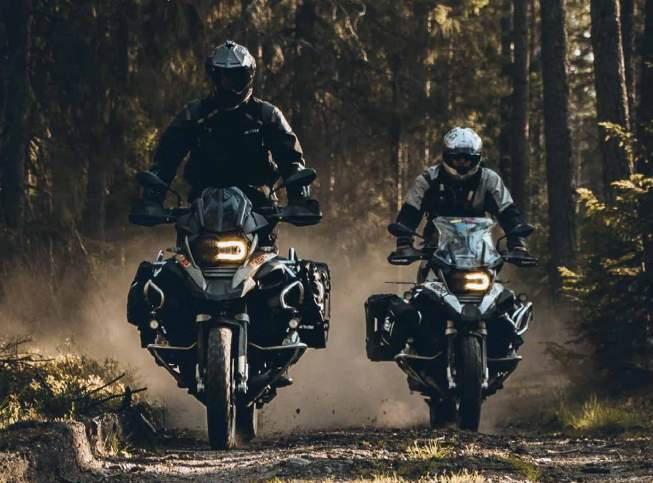
Flip-up helmets are an acquired taste. You either like them or you hate them. But if you’re keen to try one, then you might as well try one of the lightest and best-appointed on the market.
The German-made Schuberth E1 is a first-rate adventure helmet designed for versatility, functionality, and safety. It’s a combination flip-up and dual-sport helmet, offering the protectiveness and sound and wind insulation of full-face headgear with the flexibility and freedom of a moveable chin guard. To cap it off, the E1 incorporates standard features from adventure helmets to maximize off-road performance and all-weather riding.

You’ll get the build quality and attention to detail you expect from Schuberth, plus thoughtful design elements like a distortion-proof external shield and a drop-down sun visor to reduce glare.
These helmets are ECE certified, and this meets the highest safety standards in the world. Safety features include
RIDEADV’S WOMEN’S VICTORIAN ADVENTURE RIDE IN MERRIJIG
RideADV and Yamaha are proud to announce the Victorian Women’s Ride of what will be the 3rd in the Women’s Adventure Ride series for 2023.
Women-riders from all over Australia will be there for a ride to remember!
The ride starts and finishes in Merrijig, with both days’routes suitable for any bike and any skill level.
Lead riders and Sweep riders at the rear will ensure everyone stays together and doesn’t get lost, and there will be support vehicles and a full crew on hand to help out if needed.
You will need a bike that can do 120km on one tank of fuel, so that’s almost all of them.
Your accommodation will be by pub, motel, or camping, if that’s what you’re into.
an adjustable peak, a micro-ratchet fastener, shock-absorbing lining, and a heavyduty chin-strap.
This focus on safety doesn’t come at the expense of comfort, and the E1 is suitable for enduro, touring, and adventure riding, and stays secure and comfortable over long periods both on and off-road.
One of the key aspects of this revolutionary adventure helmet is
the removable face shield, letting off-road riders wear goggles if they choose.
The E1 also features a top-notch ventilation system, which includes an adjustable chin vent that keeps the shield from fogging and a crownvent that helps circulate air through the helmet.
The chin-vent has a removable, washable foam filter that keeps off-road dirt out of your mouth and eyes.
The E1 adventure helmet comes in sizes from XS to XXXL. In addition to being moisture-wicking, the lining is antimicrobial and removable for easy washing. These helmets come in a wide range of colours and patterns to suit any style.
Don’t waste time deciding between a dual-sports helmet and an adventure helmet. With a Schuberth E1, you get both.
Go to mig.bike to check them out – there are great deals to be had right now.

Lots of great info and tips will be offered if you’re new to this, like:
v Pre-ride bike-inspection tips
v Bike set-up
v Info on Adventure bike tyres; different types, tubes versus tubeless
v Suspension set-up
v Riding tips
v Luggage, packing tips and tricks
v GPS, how to understand and use them.
v Riding gear, jackets and safety gear
v How to change a tyre
v What tools you might need
v Plus much more
WHEN: 11 and 12 November, 2023
Contact: info@rideadv.com.au.

In the market for a new jacket? Want something that has become THE go-to jacket for all sorts of riding? You need to check out the Held Carese 2. It truly is like a hamburger with all the trimmings.
The outside is all DuPont® Cordura 500D, while the lining is made from 3D air mesh panels to promote air circulation, and it also has a COOLMAX® breathable mesh inner-lining.
And of course, removable GORE-TEX® 3-layer technology is part of the inner-liner as well, which detaches and can be used as an over-jacket.
The features list is pretty solid, as well – waterproof external pockets, an internal phone pocket, waist belt, lovely soft collar, and a full-length back
SC-Project has been making the finest pipes on the planet since…well, since SC-Project started making pipes. It’s pipes are standard on all Aprilia performance bikes, and they supply MotoGP racers like Aleix Espargaro with exhausts.
And now you can fit the world’s best pipes and mufflers to your
protector which can be integrated into the jacket lining.
You also get air-vent zippers in the front, back and on the arms, a map or document pocket, and magnetic closure pockets.
The protection offered by the Carese II is second to none.
It has exclusive EN 1621-1 CE-approved Held cloverleaf SAS-TEC® shoulder and elbow protectors, an optional EN 1621-2 back protector, and there’s a connecting zip if you want some pants to go with it.
And right now, it’s a bargain because it’s 25 per cent off at www.mig.bike.
This is a no-compromise on quality and looks exhaust.
A titanium body enriched by laser marking to create a mud effect that, together with the carbon end-cap, screams “Adventure!” But it’s also available in the elegant Matte Black Edition, if you don’t like yelling.
It’s a much sleeker and lighter option compared to the bulky and heavy sheet-steel OEM mufflers.


The SC-Project R&D Department has developed an internal pre-chamber muffler with double output to optimise
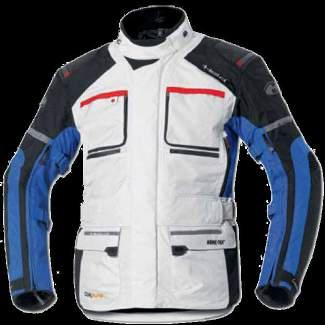
performance, reduce weight and give an unmistakable sound, even in the Euro4 approved version.
All the titanium and AISI 304 stainless steel parts are Tig-welded and the insert bushings are machined from solid alloy by CNC machines and guarantee impeccable couplings.
These pipes are everything you’ve ever wanted to be as a person, ie.
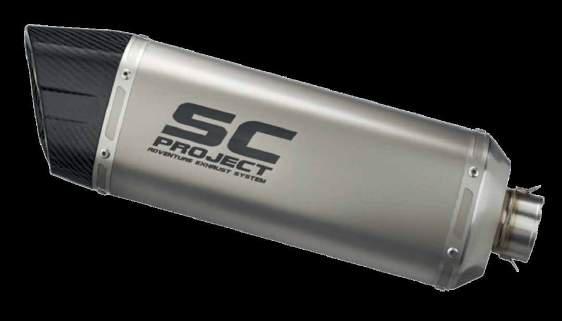
Thanks to Martyn Blake for his shot of Troy Gorden on the hat head sand track. (left) and James Millar from onedaytech.blogspot. com (right) for posting these great pics on our Facebook page. Keep posting your adventure riding photos on our site and each issue we will pick a couple to print in the magazine.


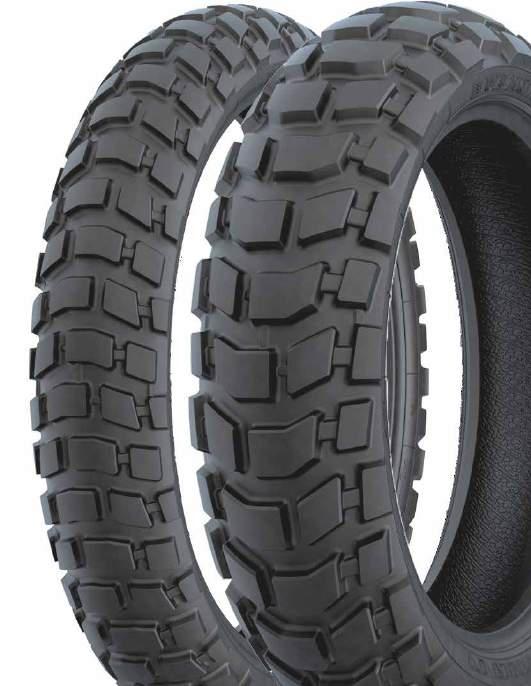



14th and 15th
ROAD, NSW
The Grey Gum International Café is now licenced so you can enjoy a range of cold beers
Campfires are allowed (depending on local restrictions).
You can purchase firewood for $25 from a local Putty Road business if you organise this with the café ahead of time. However, the café allows you to go forage for timber also and this is, of course, free.
The camping is also free and there will be a great band on Saturday night – the café has a fully-loaded stage with a great sound system.
MC Boris Mihailovic will take the microphone from 2pm Saturday 14th for competitions/games.
There are toilets and you can splurge $5 for a lovely hot shower.
Sunday is a free day.
Please note the Yengo Trail Loop is closed (and there are cameras along the trail so be warned if you try and sneak in). You can, however, ride the Howes Trail, which is about 30 minutes north of Grey Gum Café. This can be a challenging trail ride (and more so after storm damage)
(from the tap or in a can), pre-mixed spirits, or a Hunter Valley glass of wine.
so if you head there, ensure you are with a group. On behalf of Adventure Rider Magazine, we look forward to welcoming you, and we hope you have a safe and enjoyable ride.
Visitors claim the best burgers and steak sandwiches ever! All day breakfast. Vegetarian options.
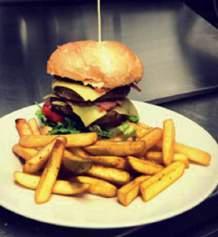

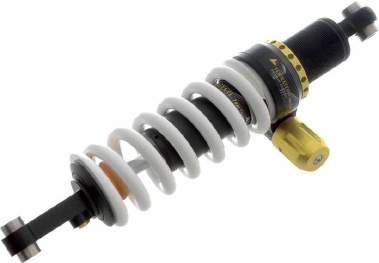


Dirk von Zitzewitz
Touratech ambassador
„Precision
You can focus on your journey while Touratech protects you and your bike on the road.
30 years of product development and thousands of miles testing will enrich your experience as a rider.
More than one million panniers produced in the Black Forest, Germany. Decades of heavy usage on the roughest tracks of the planet.
You can rely on that. Experience counts. Get your gear here!
BUILT FOR ALL ROADS. BUILT FOR NO ROADS.
FEATURING TERRAIN-TESTED SUSPENSION, SWITCHABLE ABS, DUAL-PURPOSE TYRES AND TRIPPER NAVIGATION. THE HIMALAYAN IS BORN OUT OF DECADES OF RIDING EXPERIENCE IN SOME OF THE HARSHEST TERRAIN ON EARTH. CHOOSE FROM A WIDE RANGE OF COLOURS.
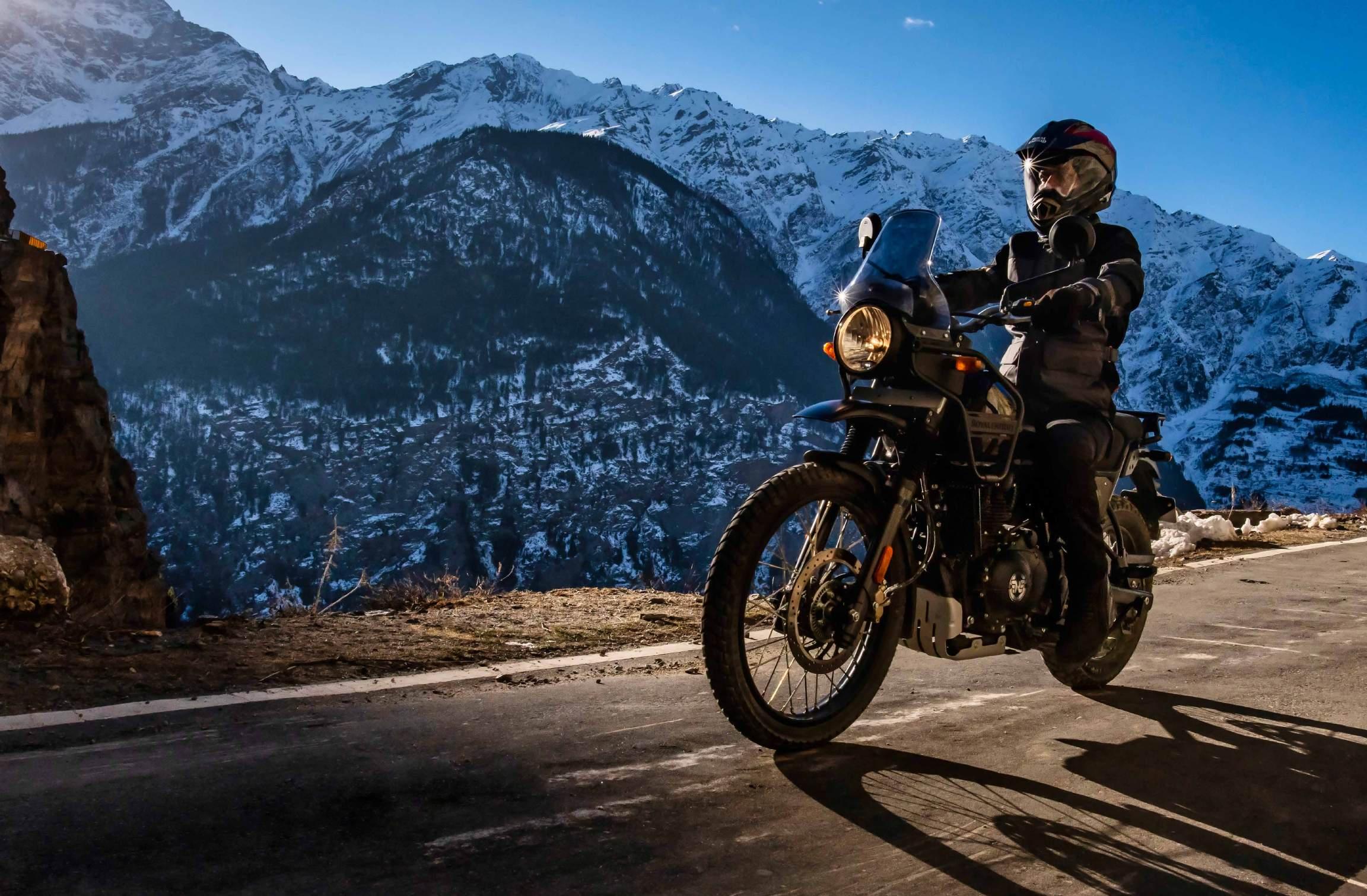
FROM $8,390 RRP INC GST



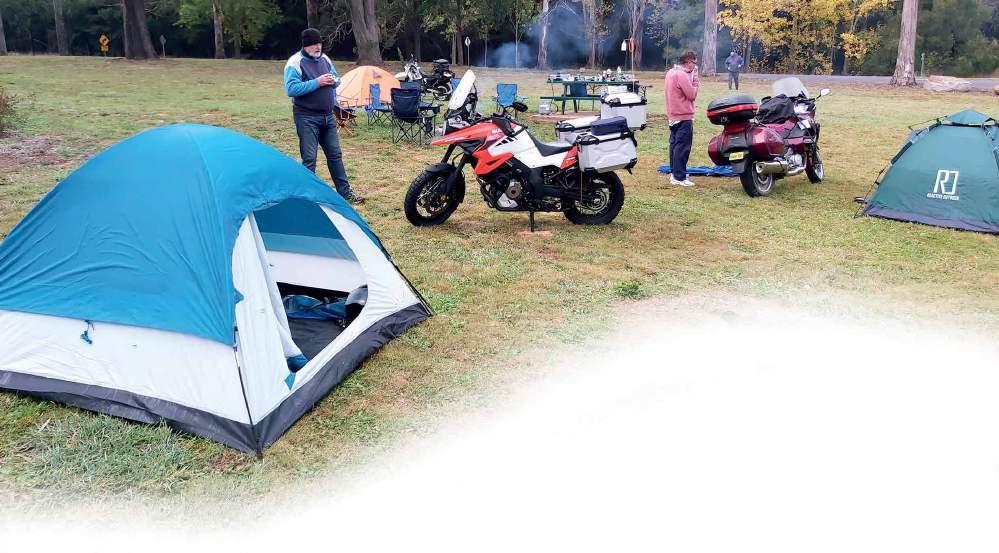
The first assumption is that you are an experienced bike rider on and off the black top. Secondly you are conversant with all aspects of your ride. It is extremely important to set up your motor bike for the event or events that you are going on. Don’t assume anything, especially tyres. My bike does 15,000 km rear, 30,000 km front, so make the correct decision before you leave and book new tyres ahead. If they are replacing tyres, then get them to replace seals and slap some grease into your wheel bearings. I still run original wheel bearings after 237,479 km on my ride.
There are two types of adventure riding which I will detail as follows:
The glamping holiday
Example 17,382 km in 62 days around Australia by two Harley Riders. What do you carry for this trip. Credit Card, toothbrush, mobile phone, Riding apparel for all conditions, water and snacks.
The adventure holidays
You still have a similar itinerary, but you choose to camp along the way under the stars. This is my choice of travelling and have been doing it for 50 years so this is a rough list of must haves. First rule is that if the item does not have more than one use don’t take it. Secondly if it has taken up space for a few trips and has not been used you don’t need it.
1. A 2 - 3-person dome tent with front fly plus a cheap ground sheet. This gives you room to put your bed on one side and bags on the other. The small fly is a place to put things out of the weather like cooking items, boots etc. You can erect this tent without using tent pegs etc as your bags and bed will keep it secure. If you require to put up the fly just use a few pegs.

2. The bed that works for me is the air bed, sleeping bag, polar fleece blanket, a roll out sunshade or flip one as a thermal blanket under the air bed and a blow-up pillow. With this set up you can usually roll up all the items into a bag.
3. Other items. A fused 12v female outlet in your pannier for air blower, phone charger etc. I use two small tripod chairs one to sit on the other to place a hard top on for a table. I use a piece of wood that I put across my rack to support my bags. Reason for this is to make sure that your number plate is visible when on the road. Single burner stove and spare gas
Top: Small dome tent protects from the weather but will fold down into a small packet to help with storage.
bottle, cutlery and crockery for two just in case a friend turns up. Toilet paper and small fold up shovel. Small hammer for tent pegs and a hook to remove them, a bent tent peg does the trick. Bike cover. Deep frypan that has more than 1use. It can be used to boil water, cook and wash the dishes. Basic tools that you can access whilst on the road. Lighting is very simple these days with a huge range available. Pick what suits you but always remember to pack spare batteries. Small vertical Esky to carry your supplies in for the day.
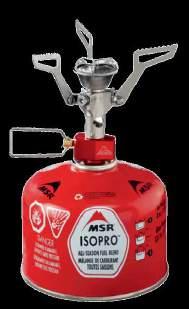
Top right: A deep Frypan will have more than one uses.
Right: Single camp cookers come in many shapes and sizes.
If you arrange your day so that you pass through a town or roadhouse a few hours prior to you pulling over for the night you can grab what you need for dinner and breakfast. If you get a six pack, they will give you

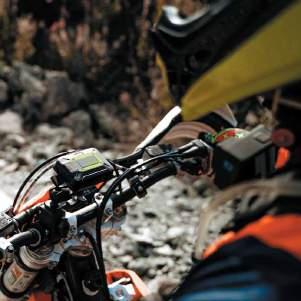
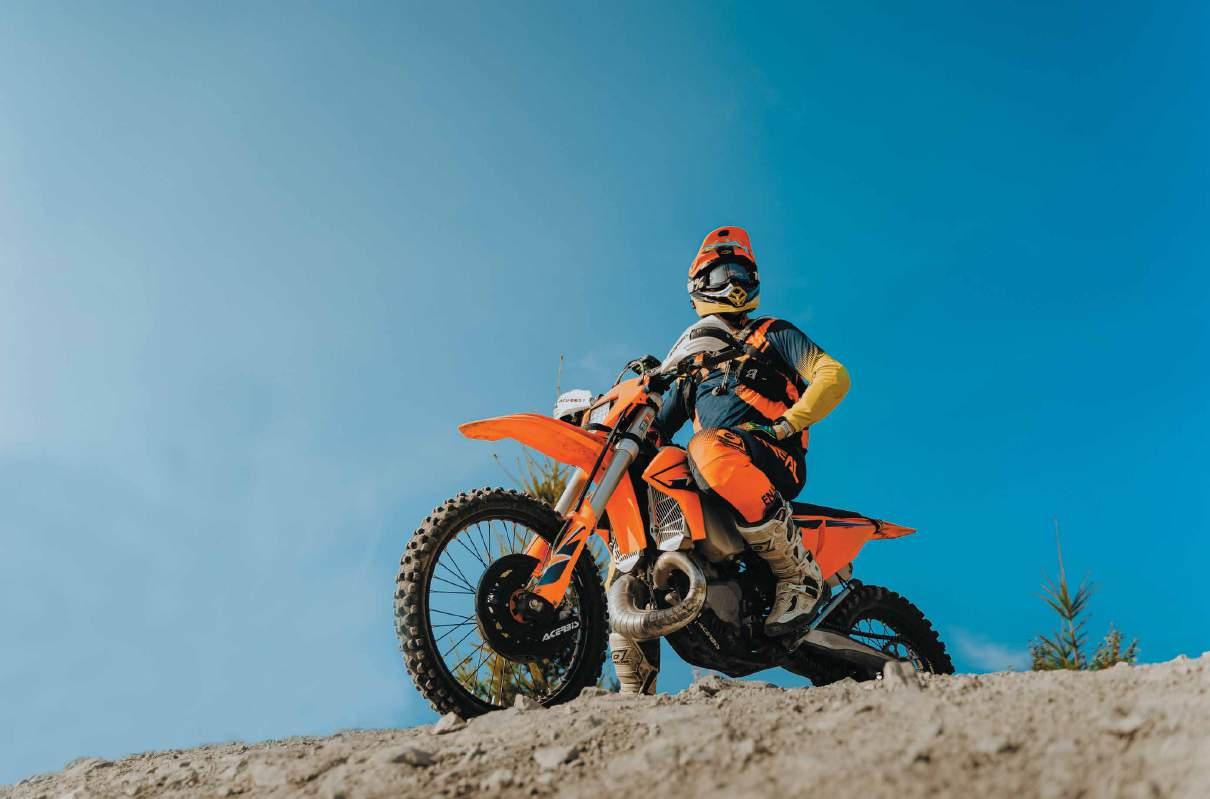

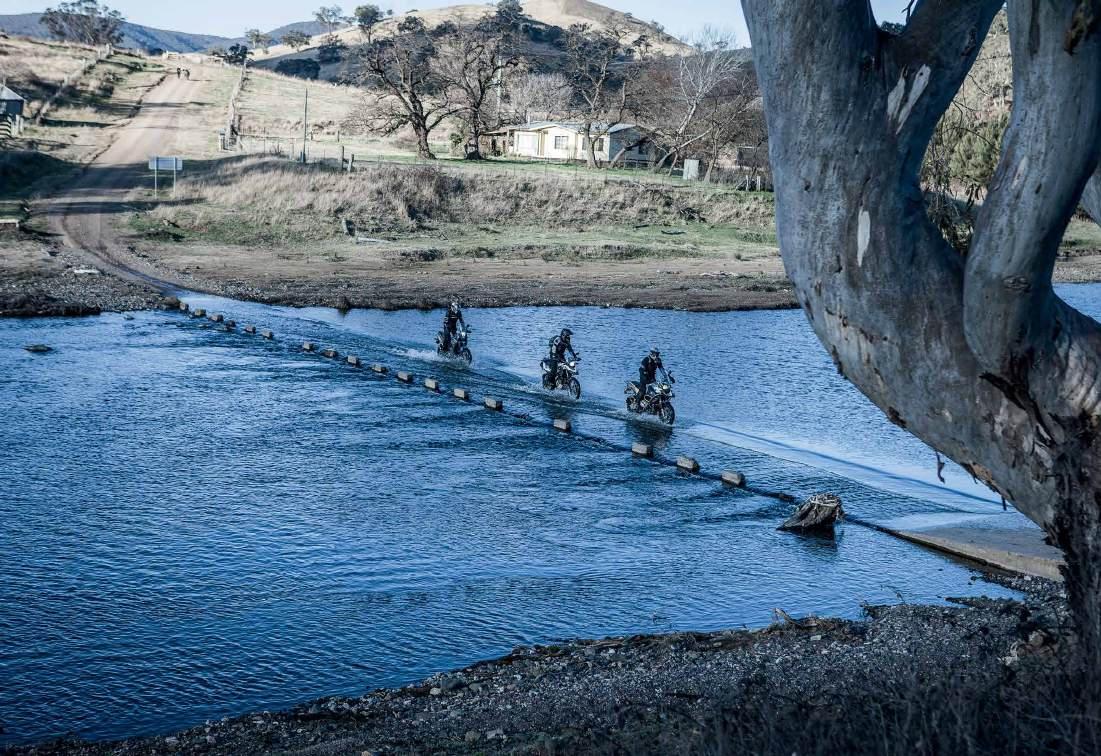
a mixer of your choice. The golden rule for me is to park up an hour or so short from another town or roadhouse. It just helps in the morning if you want to ablute or have a shower. Lunch, I carry usually tin food and biscuits e.g., tuna, beans etc.
Clothes are bulky so don’t go overboard. My rule is only pack for 7 days as on the 7th you can pull into a caravan park and spoil yourself and do the weekly wash plus have a break. Whilst you are doing the laundry check out all the tourist
brochures that live there and plan your next few days in relation to what to see and do. Remember the golden rule, you are here now so best to see it now. Why, well most probably you will not be here again. Tourist Information Centres are a huge source of information and are extremely helpful.
Have seen this many times as I travelled in groups. Example, Perth to Mt Isa then onto Cairns with a group. I am conversant with where they want to go so eventually rode them into the Daintree area. Next day suggested Cooktown but was knocked back as it was a dead end, and they will see it next time. Next time never arrived.

So far looks straightforward, and it is if you do not rush things. Packing up is simple. First thing is to bag and tag.
Left: A 5 litre container of fuel could be the difference between making it to the next service station or not.
Right: A PLB personal locator beacon is always a must have particularly if you travel alone.
It is easier to pack bags on your bike instead of loose items. My panniers are for tools at the bottom in tool rolls, shared weight each side. Followed by my personnel bag one side and first aid kit the other. My water is carried in small bottles, and I fit them in where possible, usually one each side in the panniers. Next is the board on the bike rack followed by a bag usually full of my clothes. On top goes the tent. On the pillion seat goes the bag with the vertical Esky, plus bits and pieces


Above: You don’t always have to eat canned food while traveling. A good BBQ cooked meal at night can make your next day’s ride all that much better.
the back bag on the rack. You can fit the ground sheet, airbed and sleeping gear in it for a mid day snooze. So that’s it but will require fine tuning as you go but that is what it’s all about. If you need something, go to the local Op Shops as they often have a huge range of gear for the traveler.
The only other area to be addressed is the off-road adventure rider. Same as the above but you can reduce weight by using hiking gear from any hiking shop. Also, you can set up a PLB personal locator beacon for your trip as there are a huge range available.
This is easy to obtain on the road; just keep your prescriptions up to date. Keep them in their blister packs. If they are loose in a bottle, pack it with cotton wool. If they rub through vibration you finish up with powder. If they are in glass, put them in plastic. No glass on the trip.
Lost? Look for signs you know If you are in a strange town and can’t find where you are going, the easy option is to follow the Maccas sign as they are easy to locate. Pull up have a coffee, use the toilet, grab some condiments, and re assess the situation. All good. Ride safe and look after other riders.
Just a few more observations to help you that I have learnt along the way. 1. One of the most important things that you do prior to packing up in the morning is to start up your bike and run it to operating temperature. This can be done whilst you are packing up. Reason being is that it is a huge job to strip your gear off when your bike won’t start. Happened to me once and all it was a
u like the phone charger which fits into a pocket in the bag. Loaf of bread sits on top of the Esky which all gets zipped up. I have always used several types of straps to put it all together as Ocky straps take up the slack as things settle and the ratchets can be tightened as you go. Theses days there are Rok straps that do both things. Bike cover rolls up and is placed behind my wind screen. Also, it can be used as a small tent when hung off
I pack rice and pasta sachets plus tins of beans, tuna etc. When heading through the last town, I pick up some meat to add to my assortment of goods. I do kebabs which can be stripped down to cook up with some rice. Steak and vegetables are another easy option and there is huge range of single meal options these days in the shops.

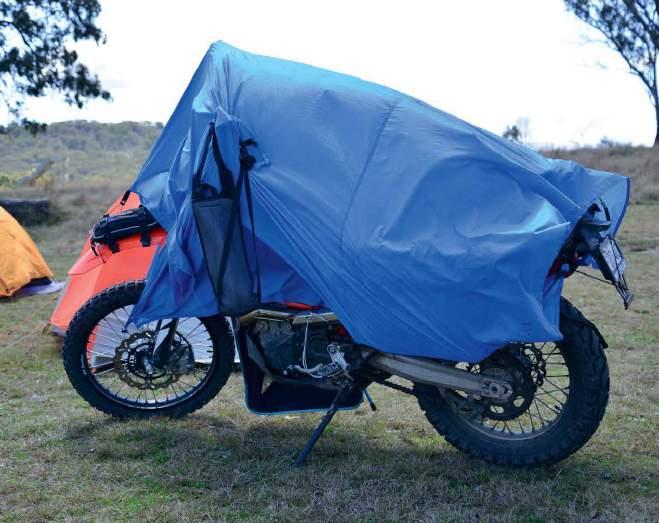
loose battery connection. But had to strip all my gear off the bike.
2. It is very handy to have things packed in bags and in sequence. You should be able to park up late in the dark under a tree and set up successfully. Know where things are like first item ground sheet, next tent, then sleeping gear, blower for mattress. From here you can set up the kitchen and arrange a meal or snack. Don’t forget a good beanie, knitted gloves and a scarf for bedtimes. If it’s cold don’t get changed, just hit the sack in your riding gear. Guaranteed to keep warm. Make sure that you do some basic stretching exercises before you go to bed as you will feel a lot better in the morning. Mainly hamstrings, lower back, shoulders and arms.
3. Fuel up when you can as you can’t rely on the next fuel stop being open. This is important. Fill up when you arrive in a town if you plan staying for the night. First thing in the morning does not work as everyone seems to fuel up at this time. Another consideration if you are in remote areas looking for fuel on a Saturday afternoon or Sunday you may have to make a phone call to open the bowser. Then a $50 minimum amount may apply. I once had to wait for someone else in a car to turn up to open the bowser. Carried a 5lt fuel plastic container since then if going to semi remote places. Also carry octane booster as my bike
runs on 98 octane and some places don’t have it.
4. You are loaded up as if you have a pillion passenger so make allowance especially with cross winds. Park your bike with the wind on your right-hand side to avoid your bike being blown over in high wind areas. Have seen this happen several times. Also be aware of parking up for the evening. You find an area where you can pull off under a tree and find a sidetrack. Go for a walk down the track to check it
Left: A bike cover can double as a wet weather fly if you get cought out sleeping under the stars. Below: A camp fire is a good place to meet new people, share a beer and stories rather than spending the night alone.
out. It may be downhill, sandy and a dead end. Also, the further you go off the track you will find more toilet paper. Not a good place to park up.
5. When you are parking in a multi use camping area on the side of the road that is crammed full of tourists go for the fireplace and table surrounded by bollards. Just ride in through the bollards and set up. If someone has the fire going well that is a bonus. If you get cold just find the biggest fire and go for a walk and talk with cuppa or cold beer from your Esky. Remember that there is still a culture around motor cyclists. They will not come to you. I have had to introduce myself several times in remote areas to the travelling fraternity as they will not come out of their caravans.
So that’s about sufficient information to get you on the road with a safe load. Basic items can be picked up in Big W, K Mart etc for around $25 per item i.e. tent, sleeping bag, ground, sheet, polar fleece, cooking and cutlery items, gas stove. For the rest check out Supercheap, Bunnings etc, for straps, 12v gear, lights, bike covers, first aid kits etc. So, ride safe and keep things simple and have fun.


What more could you ask for when you’re sitting around the fire in the middle of nowhere! A big comfy chair which fits into a small bag? Done! Somewhere to rest your arms? Done! Somewhere to put your drink? Done!
It even has the “flying saucer” feet stopping it from sinking too deep into the sand, and a cushioned headrest in case you fall asleep !
This little gem weighs 1.8 kg and fits into its bag which, when fully packed, measures 52cm long x 16cm high x 11cm deep. It even has a carry strap! Will carry up to 150kg !
RSP $139
SKU 4887
Available only through Rocky Creek Designs
Tel: 02 6689 5703 www.rockycreekdesigns.com.au

10% discount available to readers of Adventure Rider Magazine starting August 31st 2023 and ending October 15 2023 by using the code ADVRIDER10
This programmable, portable air compressor keeps your tires inflated and allows you to change your tire pressure on the fly. For motorcycles, mountain bikes, UTVs, ATVs and automobiles. Handheld for simple user experience, featuring a Li-ion battery with cooling fan, ruggedized trachea, programmable PSI pressure settings, and an LED light. Can also be used as a USB phone charger.
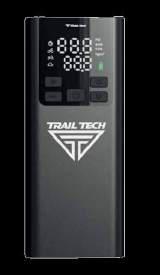

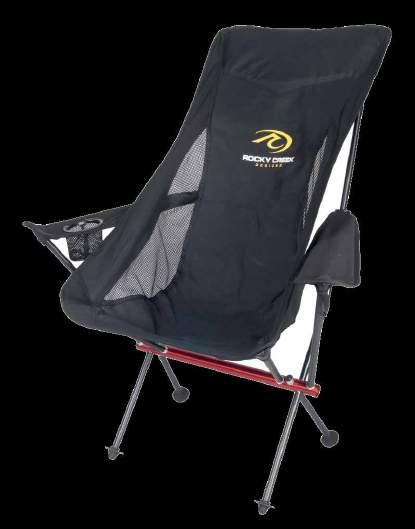

Portable Air Compressor / Tire Inflator / Trail Pump
R 2-year Warranty
R 5000mAh Battery
R Programmable Pressure
Regular price: $169.95

The new Pro series tool kit are now available from Motohansa. These new tool kits are professional quality tools with lifetime guarantee. These quality kits give you all the tools required for routine servicing, front & rear wheel removal, spark plug removal & adjustment of levers, handlebars and more. Invaluable for the serious rider and the home service guy.
R Size when rolled Up: 340mm x 100mm
R Size when opened: 340mm x 450mm
Regular price: $329.00
R Virtually indestructible- Made from reinforced Zytel
R Excellent visibility- SAE spec convex lens
R Easy to fold, remove, or swap between bikes
R Guaranteed against breakage
Regular price: $43.00

Tel: 0459 801 008
www.adventureonstore.com.au
10% discount available to readers of Adventure Rider Magazine by using the code ADVMAG
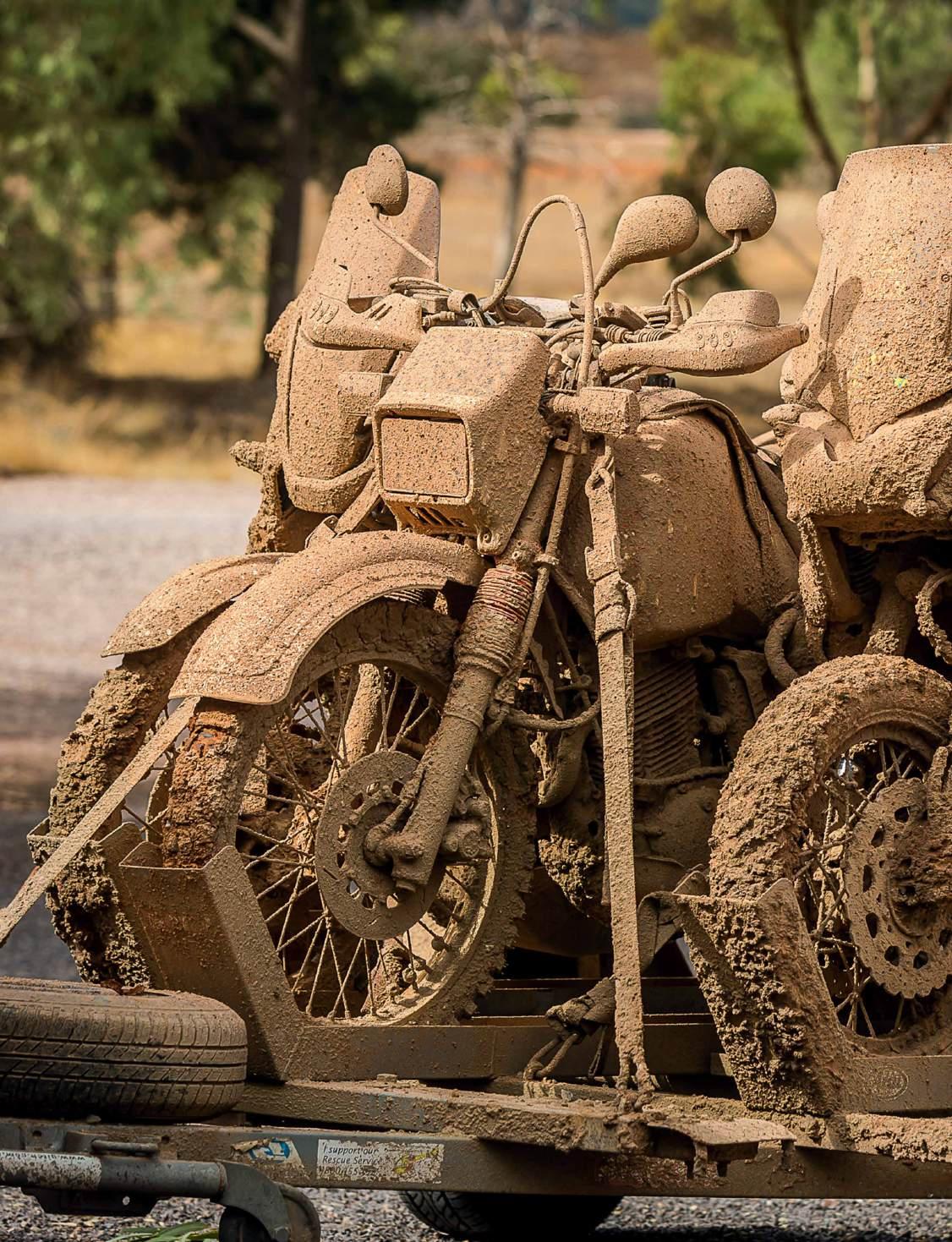
Which Adventure bike is the right Adventure bike for you? And don’t say “the red one!” even though it’s probably faster.
Words bY borIs mIHaILovIC
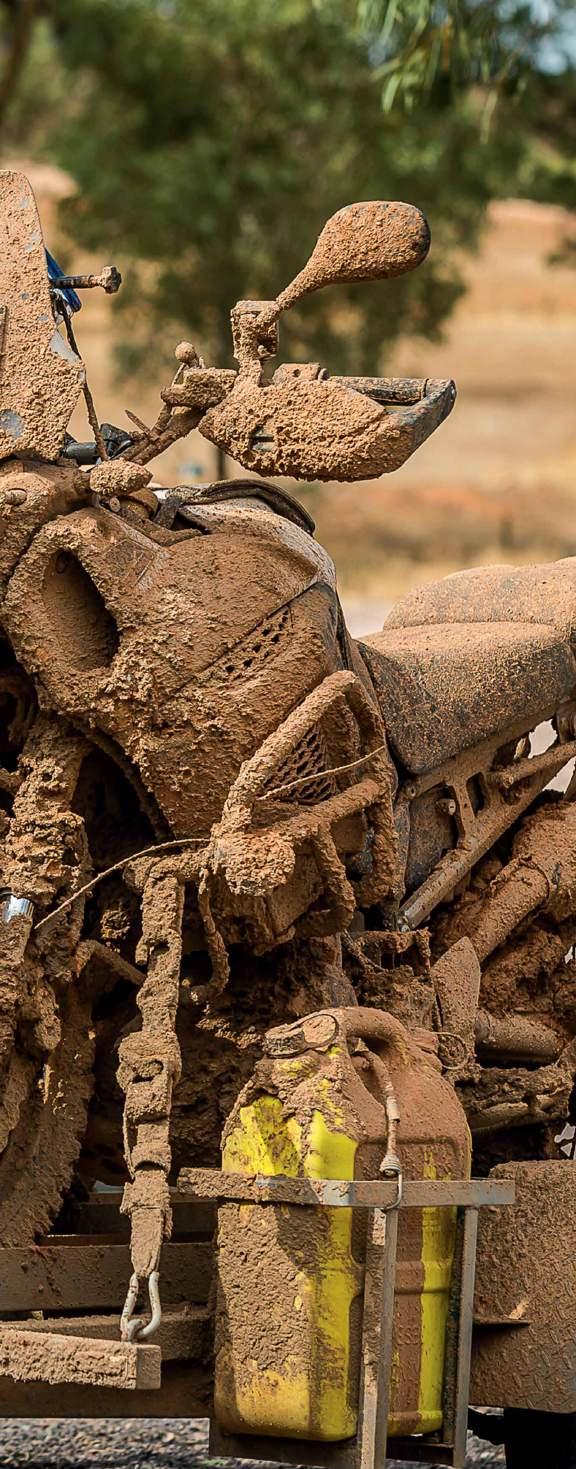
Once upon a time – and what a great way that has always been to start a story – a man sat upon whatever bike he had available, and rode off in search of adventure. And adventure was almost always encountered in one form or another due to several variables, the most salient being suddenly riding your bike down a road utterly unsuited to that bike.
Yet, you rode on, because of adventure.
There are thousands of faded old photographs in albums of seemingly unhinged men riding Katanas, XS1100s, or GPZs across creeks, through knee-deep mud, and up rock-strewn hills on their way to some motorcycle rally. I know this because I was one of them.
What choice was there back in the 70s and 80s? Your road bike was just a bike, and you took it, successfully or otherwise, to wherever the hell it is you wished to go that weekend.
The trip was as adventurous as you wished to make it – and often far more adventurous than you ever imagined – and some of those trips were the greatest rides I have ever been on.
Things are very different in 2023. Imagine taking a Panigale, loaded to gunwales with camping gear and an angry girlfriend, down 20km of rutted fire-trail today.
That’s right. It would not happen. And let’s leave aside that maybe it should.
Let’s focus instead on an entire class of bike, the sales of which indicate several things.
The first is that draconian policing has forced many riders off the sealed roads and onto dirt tracks.
The second is Australia is a big country and offers places to go and things to see which
can only be accessed by unsealed roads.
And thirdly, almost all of the current Adventure bikes make superb sealed-road tourers, and even scratchers, while also being able to hare off down a fire-trail should the whim take you.
But which one is right for you?
The answer to that is multilayered.
Everything depends on how much off-road stuff you want to do, how hard that off-road stuff is, and how adept you are at riding the dirt.
You will certainly get better at it the more you do it, but honking off into the Gardens of Stone or Amazon Ridge on a fully-loaded Multistrada or GSA on your first Adventure ride, will not end well for anyone but the buzzards.
Most newly-minted Adventure riders will ease their way into the game on well-graded fire-trails, and steer away from the aforementioned Enduro rides, because bleeding out alone in the wilderness means that while you’ve reached Peak Adventure, you’ve basically failed because you won’t be able to tell anyone about how glorious it all was.
I would suggest you choose an Adventure bike based on your level of dirt-riding expertise, and also on how much and what kind of dirt you plan to ride.
And you might also want to consider that picking up a full-loaded GSA when its fallen over, is several orders of magnitude harder than picking up a similarly-loaded Ténéré. But the former is certainly faster and more comfortable on bitumen roads.
So much to consider, huh?
Anyway, we are very much spoiled for choice in terms of Adventure bikes, as you shall see…
u
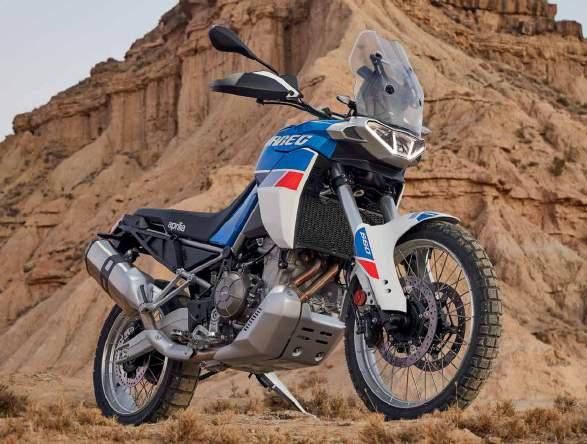
This is the marque that invented the entire Adventure bike segment as we now know it. And as such, its range – especially at the top-end – is the gold standard. Anyone who has ever ridden a big GS will tell you
The Noale factory, which rightfully prides itself on making some of the finest sportsbikes in the world, recently entered the booming Adventure bike market with its Tuareg 660.
It’s a mid-sized upright twin, so it’s light and heavily dirt-focused with proper spoked wheels (21-inch front, 18-inch rear), and it comes loaded with top-shelf electronics with four ride modes. It’s agile, pushes hard, and is a hoot to ride on bitumen as well as being super-capable on dirt in the right hands.
Power: 80hp (58.8kW) at 9250rpm
Torque: 70Nm at 6500rpm
Dry weight: 187kg
Seat height: 860mm
Fuel capacity: 18litres
it is not only a staggeringly fast and capable road-bike and long-distance tourer, it’s also capable of amazing feats in the dirt. BMW has enlarged its Adventure range in recent years, and now offers something for everyone who has even the slightest notion of heading off the beaten track. The Germans are very pleased to offer you six different bikes you can ride off cliffs – and several different variants of each one. The mind boggles. But if you want to “own” a category, this is how it’s done.
– which includes the R 1250 GS Rallye, R 1250 GS Rallye X, the R 1250 GS Triple Black, R 1250 GS Trophy, and R 1250 GS Trophy X
This is the variant that is more road-focused when stood beside the R 1250 GSA, and as a road-bike, it’s one of the best you can buy. It can tour, scratch, commute (all with a passenger), and some people even race them. And all of this is done with a degree of electronic sophistication and an equipment-level that is truly awe-inspiring. There really are too many features to write about. But if you want to occupy a few hours, go to your local BMW dealer and ask the salesman to show you everything this thing can do inside the dash via the super-computers that run it all.

This is the flagship. The benchmark. If none of the “lesser” GSs fry your adventure eggs, the Adventure will make you an omelette out of those bastards you will certainly struggle to eat. There are, of course, five variants of the GSA, which mirror the normal GS variants. The GSA is so loaded with technology and sophistication, there’s simply no room to list all the stuff. And the list of available accessories is just as vast. Just understand, this is a big bike. It carries 30-litres of fuel. Fully panniered and top-boxed, it has the roadpresence of a truck. It’s vastness can make it handful in rough stuff, but it is a superbly mannered tourer, and if you know what you’re doing, you could ride around the world on it.

Torque: 92Nm

Power: 95hp (70kW)
Wet weight: 233kg
Need something a little more agile? Step this way and behold the 750GS (and its three variants). Offering a narrower, slightly lighter, and much lower seat-height, this might be an option for people not blessed with long, supermodel legs. It’s not all that much down on performance from the 850, and still comes with all the standard BMW extras that elevates the brand above its competitors.

AT A GLANCE
Power: 77hp (70kW)
Torque: 83Nm
Wet weight: 227kg
Seat height: 815mm (or 770mm)
Fuel capacity: 15litres

pAN AMERICA
Power: 150hp (112kW)
Torque: 127Nm
Wet weight: 258kg
Seat height: 850mm
Fuel capacity: 21litres
If you’ve wandered away from the hugeness of the 1250GS and GSA, wondering just how a normal person can deal with a bike so big, BMW can offer you a much smaller variant – the more road-focused GS (in three variations), and the more dirt-aimed GSA (also in three variations). Once again, BMW loads these up with heaps of sophisticated tech, rider aids, and offers you some welcome goodies, like heated handlebar grips and a rack, as standard equipment. These are ableenough adventure bikes, beautifully well-balanced and very user-friendly, but they can be a little breathless in terms of performance if you try to push hard on the road.
Seat height: 860mm
Fuel capacity: 15litres
And yes, of course, there is a small GS, because BMW covers every possible base, for every conceivable rider who wants to go adventuring. The baby GS is as well-appointed as its bigger siblings in terms of heated grips and a rack – which makes it a very clever commuter. It’s light, it’s got impeccable manners, and it is genuinely a lot of fun to ride, precisely because it is so compact.

AT A GLANCE
Power: 34hp (25kW)
Torque: 28Nm
Wet weight: 175kg
Seat height: 835mm
Fuel capacity: 11.5litres
Milwaukee understood it’s traditional Big-Twin engine would not cut it if it ever decided to try its hand at the Adventure market. So, when it’s new and far more modern 1250cc Revolution Max engine debuted not long ago, the Pan America Adventure bike was born. And for a first-attempt at a market dominated by the Europeans, it was not too bad. The Pan America is a far more able road-bike than it is a dirt bike, but then so are many of the big Adventure bikes. It doesn’t have all the bells, whistles, and overall electronic sophistication of its competition (apart from the automatic ride-height device, which is very cool), but it has a very unique style and way of doing the Adventure thing. And it’s also the fastest point-to-point Harley ever built.
The Chinese are not coming. They’re here. And their Adventure offering is not to be sneezed at despite its very attractive price. There are two offerings. One in the mid-rage – the 650MT, and four 800cc
variants – the 800MT Sport, the 800MT Touring, the 800MT Touring Limited Edition, and the 800MT Explore. You are getting quite a lot of bike for what you end up paying. Sure, you’re not getting the bang, the glitz, or the glamour of
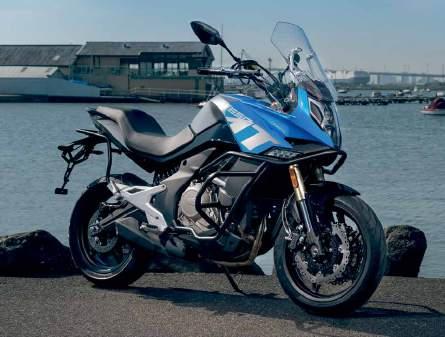
650MT
Power: 56 (41.7kW)
Torque: 62Nm
Wet weight: 213kg
Seat height: 800mm
Fuel capacity: 18litres
The Bologna factory decided it was going to take the Adventure market seriously. It initially (and still does) offered the world an Adventure version of its V2 Panigale superbike and called it the Multistrada. Then, feeling this was somehow inadequate, took its new, faster, and more powerful superbike, the V4 Panigale,
the Triumphs, the Ducatis, the Beemers, and the KTMs (though Rotax builds the engines for both), or the rock-solid reliability of the Japanese, but nor are you getting the breathless, blancmange, Royal Enfield effort.

800MT
Power: 95hp (70kW)
Torque: 77Nm
and made that into an Adventure bike, which is one of the most brilliant and capable on-road tourers on earth. And of course, the world needs a Panigale with dirt-tyres and longer-travel suspension. There are three variants of the V4 – the base Multistrada, the Pikes Peak, and the Rally (more dirt-oriented). And there are two
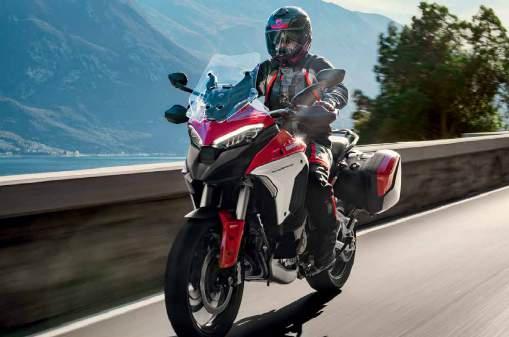
MulTISTRADA V4
Power: 170hp (125kW)
Torque: 125Nm
Dry weight: 215kg (Pikes Peak 214kg, Rally 227kg)
Seat height: Anywhere from 810mm to 875mm
Fuel capacity: 22litres (30litres for the Rally)
Wet weight: 225kg
Seat height: 825mm
Fuel capacity: 19litres
iterations of the V2 Multistrada, the base model and the fancier-painted and carbon-fibred S.
Ducati also recently debuted the far more sensible (in some circles), dirt-aimed, and altogether gorgeous Desert X for people who can’t wrap their heads around a 170hp dirt-bike.

MulTISTRADA V2
Power: 113hp (83kW)
Torque: 96Nm
Dry weight: 202kg
Seat height: 830mm
Fuel capacity: 20litres
It’s always been an intriguing company, which is now owned by KTM. But it’s been owned by BMW, Cagiva, and MV Agusta. And yes, it also makes sewing machines, but the two businesses have long been separated and the bikes are now made in Italy. Huskies have a great reputation for being amazing dirt-bikes, and when the factory decided to venture into the Adventure bike market, it stood to reason its offering would be more dirt-oriented. And so, the Norden 901 Expedition was born. And it’s quite the achievement, boasting state-of-the-art equipment, and great performance, even though unkind souls have said it’s rather munted-looking. u

Power: 103hp (77kW)
Torque: 100Nm
Dry weight: 214.5kg
Power:
110hp (82kW)
Torque: 92Nm
Dry weight: 202kg
Seat height: 845mm875mm
Fuel capacity: 21litres
Seat height: 875mm-895mm
Fuel capacity: 19litres
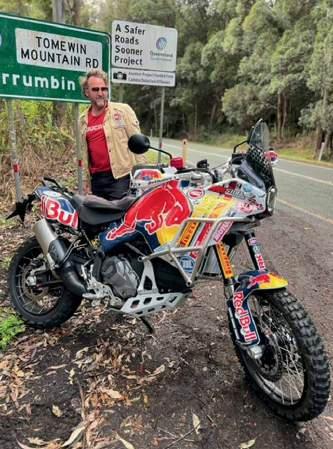








Big Red, as is its wont, has three altogether excellent and well-thought-out offerings in this market segment. All can boast of
Honda’s renowned build-quality and reliability, and the Africa Twin even comes, if you choose that option, with Dual Clutch Transmission (DCT), so you can
To my eye, one of the best-looking big Adventure tourers, the Africa Twin is loaded with electronics (think cornering ABS, Apple Carplay and Android Auto, and a bunch more goodies). Honda is a serious player in this niche, and the competition it has is steep. But the Africa Twin – and there are several variants, depending on whether you’re more focused on dirt or road – is a brilliantly capable all-road option.

AT A GLANCE Power: 101hp (75kW) Torque: 105Nm
248kg
leave the “What bloody gear should I be in?” conundrum to the bike. And it’s cleverer than you in that regard.
Not to be left behind in the mid-size class, Honda resurrected its legendary Transalp, which first appeared in 1986. It’s brand new on the market, but it’s absolutely a worthy player. It comes with Honda’s Smartphone Voice Control System (presumably so you can yell at people you’ve called because you’re lost and out of water), a slipper-assist clutch, Pro-Link suspension, and five ride modes. It’s wheel-size also points to its dirtorientation – that 21-inch front is always a giveaway. It’s the same engine as in the new CB750 Hornet, just with a more tour-orientated tune. And the seat is comfier for both rider and pillion than a more dirt-focussed one.

AT A GLANCE
(67.5kW)
75Nm
Cleverly targeted people for whom Adventure is maybe ordering a new Thai dish, this little and well-appointed 500 may well be just the thing for people intimidated by the gargantuan-seeming big Adventure bikes, and still a little nervous at the mid-sized jiggers. The CB500X is certainly more road-oriented than it is dirt, but its relative light-weight, strong, torquey donk, and sheer rideability, may be just the thing if you’re starting to look at fire-trails with a longing glance. You’ll find it a gentle but capable companion no matter what the surface. Unless it’s really bad. Then you’ll fall off.
As the second-oldest motorcycle manufacturer, Moto Guzzi is a relative late-comer to the Adventure niche. It only has one offering, with three
208kg
850mm
16.9litres
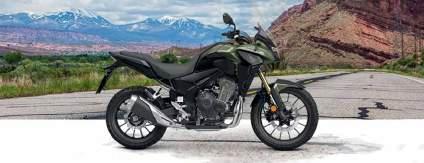
AT A GLANCE
Power: 47hp (35kW)
Torque: 42.9Nm
variations (mainly to do with the paint-job), and it really is a somewhat of a bit player in this market. Still, it has managed to build a very good-looking Adventure bike, which is very enjoyable
AT A GLANCE
It is the most unique engine-configuration of any motorcycle. A transverse V-twin is instantly identifiable as Moto Guzzi. You get the impression it only built this bike so it has something to offer this segment, and it’s fair to say the V85TT would be excellent to bang around the gentle back-roads and tracks of Europe. The villages are all close by. How much trouble could you get into? There couldn’t possibly be any wolves left in Europe, right? Crossing Mongolia is a different matter altogether. Still, it’s a very pretty bike, with a wonderfully torquey engine.
Wet weight: 199kg
Seat height: 830mm
Fuel capacity: 17.5litres
to ride, handles the bitumen beautifully, is relatively well-appointed, but might not be the horse of choice for taming the Tanami Track.
Power: 76hp (56.6kW)
Torque: 80Nm
Wet weight: 229kg
Seat height: 830mm
Fuel capacity: 22.7litres u


There is only one offering, with three variants, from the Green Team, which really is rather remiss in addressing the Adventure market. That said, the KLR is a much-beloved and long-time mainstay of riders who don’t need or want the latest bells and whistles, and prefer a bike that is only equipped with ABS, but is rugged, reliable, and made by Kawasaki, and Kawasaki alone. And while the KLR is a good thing, it really could do with a serious upgrade if it’s to compete in this segment. It’s down on power, and it’s not all that light for the horses it’s making.
The Austrian marque’s Adventure offerings all come under the tag “Travel” –which is catching a plane to Paris for most people. KTM’s customers think smashing through the Gobi Desert at 160 while sucking pebbles to keep your mouth
KTM 1290
KlR650, KlR650S & KlR650 ADVENTuRE
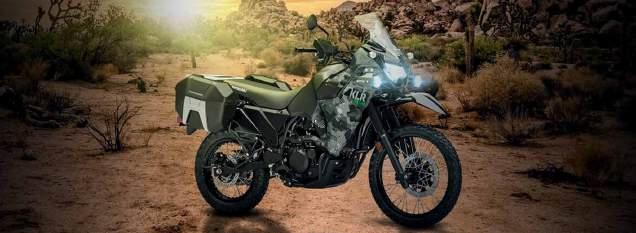
Power: 39hp (28.5kW)
Torque: 51.5Nm
Wet weight: 210kg (222kg
moist, is travel. There’s a reason why KTM wins so many legendary Dakar races, and it’s the same reason it told those two Hollywood muppets, Boorman and McGregor, it was not interested in supplying them with bikes for their misnamed “The Long Way Round –
The S is the more road-oriented one. The R is the King-Daddy monster you can summit Everest on. Both offer pro-level performance, top-notch rider aids, and a level of both on- and off-road cred no other brand equals. Big, powerful, but beautifully balanced and immensely satisfying to ride fast, this is where you should be looking if you’re after a bike with hairier balls than King Kong. The beast’s numbers do not lie.
AT A GLANCE
Power: 160hp (119kW)
Torque: 138Nm
Dry weight: 220kg (R is 221kg)
Seat height: 849/869mm (R is 880mm)
Fuel capacity: 23litres
You’re not to be blamed for running away in fear from the big stuff. Lots do. If you want your dragons a bit smaller, and even more wickedly capable in the rough stuff, while also providing brilliant smoothroad performance and handling, KTM is pleased to offer you scaled-down versions of their Godzilla-level bikes. And for most people, these are more than enough. Same deal – the R is the dirtier girl.
Power: 103hp (77kW)
Torque: 100Nm
Dry weight: 200kg
Seat height: 880mm (R is 860-840mm)
Fuel capacity: 20litres
for the Adventure)
Seat height: 870mm
Fuel capacity: 23litres
Against All Odds” TV series. It builds race bikes – but you don’t have to race them. KTM will forgive you. You want your Adventure bike to come with fangs and the ability to climb trees? The Big Orange Ogres await.
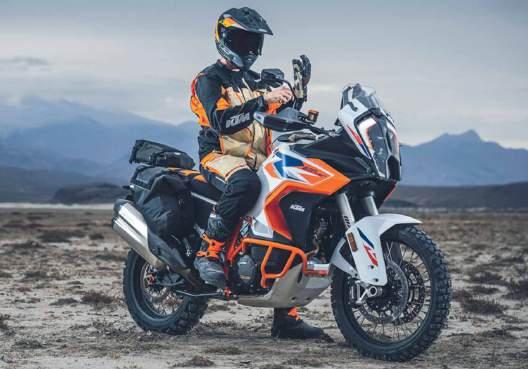

Yeah, maybe pick hill to climb rather than a mountain. KTM’s baby Adventure bikes are every bit as hard-edged as their bigger brothers, and more than a match for bigger-capacity competitors. They’re light, powerful, well-appointed, and offer a derangement-level of fun when you throw them into the scenery. They’re just not as scary-brilliant fast and powerful. Which is not a bad thing for some people. The SW comes with spoked wheels, so it’s a little more dirt-focussed, but not all that much.

Power: 42hp (32kW)
Torque: 37Nm
Dry weight: 161kg
Seat height: 855mm
Fuel capacity: 14.5litres
India makes and sells more Royal Enfields than there are stars in the sky. They are very affordable, hence the appeal, but they’re not in the same class as their
It sure does look the part, doesn’t it? In a quaint, almost vintage way, it looks rugged and capable, and ready to bear you through the Hindu Kush at what you will find is a very sedate pace. That 450cc longstoke-twin engine is not going to set the performance world on fire…or even boil water. To its credit, the factory is constantly improving the build-quality, but to be honest, they are light-years away from what the very demanding Adventure market is chasing.
Few marques carry the cachet of MV Agusta. This storied brand has built some of the most beautiful bikes ever made, and still does. It states it builds “Art” rather than actual bikes, and there’s certainly a case for that position. But Art is not always the best choice for hammering across the Levant with your sleeping bag strapped to the back. These are far more road-biased than dirt-friendly. MV’s are gorgeous, and very desirable, but like all supermodels, sometimes difficult to live with. And its adventure bike range is three paint-and-assorted-bling variations on one model. You have the 800 Lusso SCS, the 800 Rosso, and the 800RC SCS.

800RC SCS (it’s the prettiest)
Power: 110hp (81kW)
Torque: 84Nm
adventurous competition. They make a lot of sense if you’re touring the sub-continent, because it seems everyone, from the youngest child to the most venerable village elder, can repair one with a rock,
Power: 24hp
(17.8kW)
Torque: 32Nm
Wet weight: 191kg
Seat height: 800mm
Fuel capacity: 15litres u
Dry weight: 199kg
Seat height: 830mm
Fuel capacity: 21.5litres
but despite a slightly better-built export version that ends up here, you are very much getting what you pay for with its one and only Adventure model, the Himalyan.

The Hamamatsu factory builds the legendary V-Strom. It used to only ever come in one size – Large. Sold its head off anyway. Owners were like cultists.
But they knew they’d bought one of the greatest all-round motorcycles on earth. A competent rider could and would shame sportsbike riders on this giant dirt-bike. It’s handling, reliability and
The former is more road-oriented, the latter is more about the dirt. It comes with a bigger front-wheel, wider ’bars, steel foot-pegs, long-travel suspension, and a bash-plate, so you can get a bit serious.
Both are serious long-distance tourers, super-comfy for both rider and pillion, have the capacity to carry vast loads, and have a reputation for being bulletproof and utterly reliable. Ride one off a cliff, spend a week or so healing up, then start it up, and ride back out. And they’re loaded with tech like Hill Hold Control and Slope Control.
AT A GLANCE Power: 106hp (79kW)
Torque: 100Nm
Wet weight: 252kg
Seat height: 880mm
Fuel capacity: 20litres

A touch smaller than the hugely capable 800, the 650XT is more of a soft-roader than a true off-roader. Sure, you can throw it down a fire-trail or two, and it won’t scare you. But try something more challenging, and it will be out of its comfort zone. It comes in two versions – Learner Approved and de-restricted, but it’s unlikely the Highway Patrol could pick the difference. Agile, and very easy to ride and live with, it’s also a great commuter bike. And find me another 650 that carries 20-litres of fuel.
It’s for people who think the 650 is far too big and powerful. And they have a point. Drop this twenty times on a rough road, and you’ll still be able to get it upright on the twentieth time. Let’s see you do that with a bigger bike. For some riders, weight is more important than power – and the smallest V-Strom is not all that powerful. But the baby Strom is well-equipped, comes with good ground-clearance and a 19-inch front wheel, and looks like it’s serious about all sorts of dirty things, but it’s really just a great little commuter bike which you can essay some easy dirt roads on during the weekend. Don’t ask too much of it, and you won’t be disappointed. You want a harder-edged Adventure bike, you’ll need to pick something else. But this is such great value, it’s hard to walk past.
integrity are the stuff of legend. And all for a brilliant price. In terms of value for money, the V-Strom range is hard to beat. Suzuki now offers them in four capacities.
A very strong contender in this mid-size class. All the cred and reliability of its big brother, but just a little easier to conquer difficult mountains on. More dirt-oriented (that’s the ‘DE’ appellation), it’s basically a shrunken version of the 1050 – and that’s a very good thing. It’s far less intimidating to take on the dirt, but still offers great performance and comfort levels for both on and off-road journeys.
AT A GLANCE Power: 83hp (62kW)
Torque: 78Nm
Wet weight: 230kg
Seat height: 855mm
Fuel capacity: 20litres
AT A GLANCE Power: 70hp (52kW)
Torque: 62Nm
Wet weight: 216kg
Seat height: 835mm
Fuel capacity: 20litres
AT A GLANCE Power: 26hp (19.5kW)
Torque: 22.2Nm
Wet weight: 167kg
Seat height: 835mm (or 805mm with an accessory fitted)
Fuel capacity: 12litres

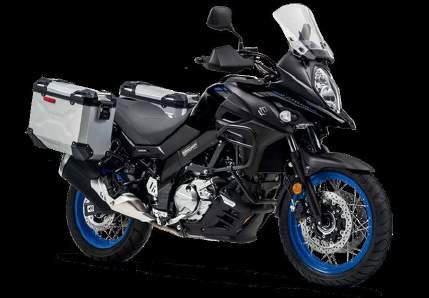

The British are all about the tiger, which they hunted to almost extinction when they ruled India. Perhaps in honour of the Raj, the Hinckley factory has named its
extensive range of Adventure bikes after the big, striped cat. And like the Poms of WWII, they have the Germans firmly in their sites. With a now established reputation for build-quality, reliability,
At the top end, Triumph’s new Tiger 1200, is quite a brilliant package. Slimmer and more agile than the BMW, it still offers serious on- and off-road performance, while delivering great ergonomics, and some high-end electronics. This is a very competitive niche, and Triumph knows full-well it has to bring its A-game, which is why it has completely re-invented its flagship Tiger last year.

Power: 148hp (110kW)
Torque: 130Nm
Wet weight: 249kg (261kg for the Explorer)
Seat height: 875-895mm (adjustable)
Fuel capacity: 20litres (30litres for the Explorer)
performance, and good-looks, there’s a lot to consider from the gravy-flavoured island full of soccer hooligans.
Both of these come with a Pro variant. The Rally is more about the dirt (and the Rally Pro is a little more tricked out with more engine maps and heated seats), while the GT is the magwheeled road-friendlier version. In its case, the GT Pro gets electronic suspension. Both make outstanding Adventure bikes, and Triumph gives nothing away to its competition in terms of handling or performance. The bikes are all beautifully finished and look very much top-shelf.

AT A GLANCE
Power: 94hp (70kW)
Torque: 87Nm
Wet weight: 196kg (198 for the GT)
Seat height: 860-880 (adjustable) (820-840mm for the GT)
Fuel capacity: 20litres

It’s fair to say this is a road-bike with vague pretensions of dirty ability. So, it’s an Adventure bike, but I don’t imagine it will be long for the Triumph range given there’s a bunch of models with 50cc more bang sitting right alongside it. Still, if you’re scared by a 900, then consider this 850. It is a fair bit cheaper. There is also a Tiger 660 Sport, but it’s pretty much purely a road bike with no pretensions of any dirt ability at all, so its details are not included.
There are only three Adventure bikes on offer here (and one is just a more extreme version of the other) – but there really
Power:
84hp (62.5kW)
Torque: 82Nm
Dry weight: 192kg
Seat height: 820-840mm
Fuel capacity: 20litres

don’t need to be anymore. With a reputation for build-quality, reliability, sheer performance, and engineering integrity, Yamaha has some very big guns in its
This big parallel-twin 1200 is more of a bitumen weapon than a serious off-roader, as dictated by its 19-inch front-wheel. But that’s not all that keep it from winning Dakar. It’s just a touch too heavy for really gnarly stuff. But it’s hardly alone there. It pulls like it’s carved from the bedrock of torque itself, and is stunningly comfortable for rider and pillion – so a serious long-distance tourer. It’s also got a unified brake system and electronic suspension. The fact it’s a big parallel twin where both cylinders fire closely together, means it’s not only physically narrow, but it hooks up very easily on the gas. And it has some mean grunt. But she’s a big girl, and she does take someone who knows how to dance to make her shine.
Until very recently, this was THE bike to buy if you wanted a killer that could deal with some of the hardest dirt, while also being able to sit on 140km/h all day on the sealed bits. It came with no rider modes, was pure and simple, and did everything it was designed to do superbly well. It was extremely well-priced (and still is), more rugged than a 60-yearold prize-fighter, and a byword for reliability. It also has its cultist followers, who were overjoyed to see the Ténéré resurrected a few years ago.
But if the normal Ténéré isn’t juicing your Adventure glands, consider the World Raid version. Dual side-mounted fuel tanks, top-spec suspension, a flat arse-busting rally seat – because you don’t spend a lot of time sitting down when you’re blasting across Saudi Arabia at 160km/h – and more serious off-road cred than most of the competition. It’s five grand more than the standard Ténéré, but one cannot put a price on credibility, can one?

Power:
112hp (83.5kW)
Torque: 117Nm
Wet weight: 257kg
Seat height: 846mm
Fuel capacity: 23litres
arsenal. “Ténéré” is the Tuareg name for “desert”, and Yamaha’s Adventure offerings can and do conquer those rocky and sandy bustards.


Power: 73hp (54kW)
Torque: 68Nm
Wet weight: 205kg (World Raid is 220kg)



Seat height: 880mm
(World Raid is 890mm)
Fuel capacity: 16litres (World raid is 23litres)



Portable, Security & Stylish:
Portable device with high grade alloy construction and piercing alarm make KNX-6 a markedly effective way to protect your bike. Simple pushdown locking system comes in five stylish finishes.

ALARMED CHAIN


10mm hexagon hardened steel chain with protectice sleeve.150cm in length. Suitable for the Kovix Ground Anchor.


ALARMED BRADED CABLE
Kovix Alarmed Braded Steel Cable
110cm. 24mm strong thick plastic coated steel cable.

Brake lever lock with Zinc alloy protected alarm module (with alarm light).

“For 15 days a year the world is watching the Dakar and we cannot forget that it is an enormous privilege to be there.” The sustainable and supportive Dakar Rally of Iván Merichal.
Words: Pablo Pillado - spain
Photos: Pablo Pillado, https://ivandakar.com/
The Spaniard Iván Merichal, Catalan by birth and Galician by adoption, will face the toughest race in the motorbike world in a way that respects the environment. We spoke with the protagonist of this challenge.
The sustainable Dakar:
We want to know how a great project such as being present at the

Dakar Rally is articulated, minimizing its environmental impact and the formula does not seem complex:
“The combustion of our engines generates CO2 and I have proposed that my Dakar does not have that negative impact”.
Known as the carbon footprint, Iván has done the numbers to find out what it translates into:
“We know the impact that the
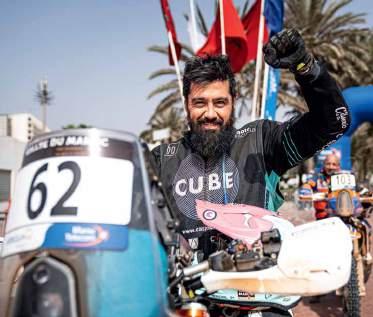
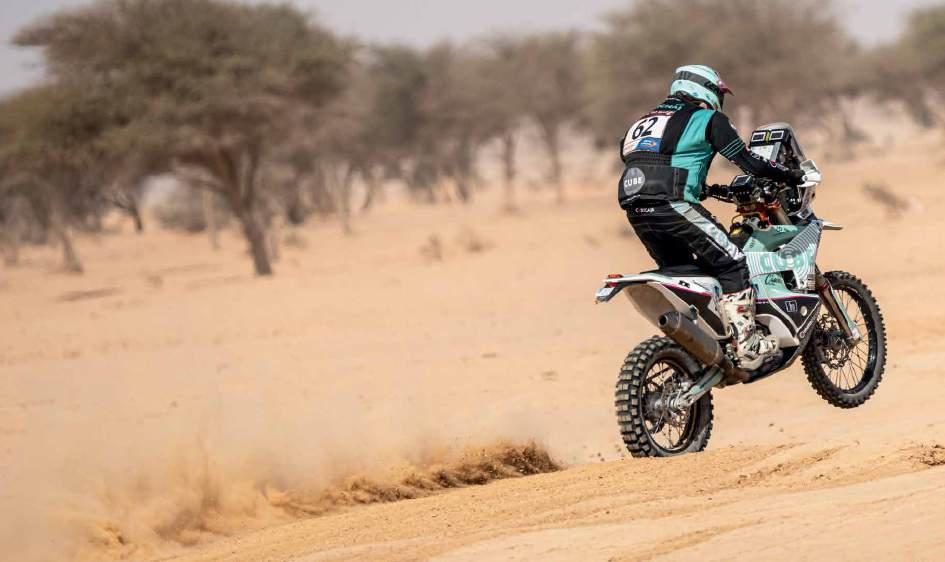
Dakar project will have on the environment. It is calculated at 7.3 tons of CO2, including training, flights, van trips and the boat trip of the motorcycle to Saudi Arabia. I have included everything”.
He explains how he will manage to make it sustainable
“I will do it by planting trees. I have created a virtual forest, but with real trees, in which I invite everyone who participates in my project to plant a little tree. I do this through a platform that guarantees the traceability and transparency of the process and thus eliminates the carbon footprint that my Dakar project will generate.”
In this way, Iván takes advantage of the photosynthesis of plants by absorbing carbon dioxide -CO2- to compensate for what is generated by his project. Fantastic!
It seems that Iván had it clear from the beginning. His Dakar project, in addition to being sustainable, had to be supportive:
“I collaborate with the Enki foundation to

help them finance the purchase of material. Enki works to reintegrate people with functional diversity, doing a very important task with people who have spinal cord injuries, which unfortunately is closely linked to motorcycling. They offer themselves as a point of support to all these people, showing them that there is also a happy life after an event like this and they convey it through sport with wheels, so this passion also unites us.”
Iván makes an enormous effort to finance his Dakar project, and we have been fascinated by his determination to take advantage of his presence in a rally as high-profile as the Dakar, to contribute his grain of sand:
“For 15 days a year the world is watching the Dakar and we cannot forget that it is an enormous privilege to be there. For me it is a moral obligation to do things that have a positive impact on my environment while I fight for many brands and people
to get involved. That is to say, I cannot alone, but I have to return this help in some way and for me it is this: in my direct environment through Enki and to the environment with the planting of trees.”
He concludes by breaking a spear in favor of the motor world: “Motor sport is no stranger to environmental sensitivity. Above being a pilot, I am a lover of nature and although today it is not possible to do a Dakar on a motorcycle with a noncombustion engine, we can do things and this is my small contribution…I will be the first to carry out a sustainable Dakar on a motorcycle and I hope that from here, many more people will be encouraged.” We can all plant a tree in Iván Merichal’s forest. Are you up for it?: www.treedom.net/ es/user/ivanmerichal/event/dakar2024-ivan-merichal



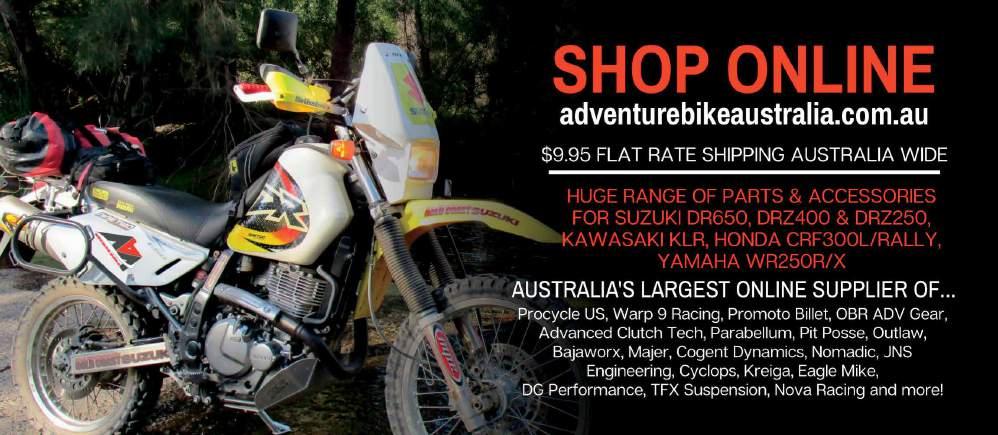
Wet-weather gear is the bane of every motorcyclist’s existence.
Words: boris mihailovic

Wretched, uncomfortable, invariably dishonest, and ultimately useless – it is the Curse Eternal.
And it is exclusively our curse. And thus must we come to terms with it. For only then can we find peace and harmony.
I have owned many different types of wet-weather gear. Actually, I have owned ALL the wet-weather gear – some of it multiple times. Much of it is still out there, flapping on barbed-wire fences, refusing to decompose in table-drains, and strangling dolphins in the Great Barrier Reef. Peace and harmony eluded me.
But I’m a stubborn and cussed creature. I persisted in the search for wet-weather gear that did not fill my heart with black hatred.
I walked the wrong path for many years. Such wet-weather gear did not exist. I wanted it to exist and I sought it because I felt it must exist somewhere, but it was not anywhere because it did not exist.
Certainly, wet-weather gear has
improved since I first started looking back in 1978. But it has peaked. It is perhaps less wretched. It is marginally more comfortable. But it’s still dishonest and ultimately useless.
“ I’m a stubborn and cussed creature. I persisted in the search for wet-weather gear that did not fill my heart with black hatred. ”
But after 3.5-million kilometres and almost half-a-century of riding, I have accepted the Tao of it. And I am at peace. And this is crucial. One must accept and understand the Tao of Wet-Weather Gear if one is to refrain from dreadful depredations and find harmony.
Tao is a fancy Bat Empire word

which means “The Way”. To Chinese philosophers, Tao is the absolute principle underlying the universe. It is the Yin and the Yang that brings harmony to the natural order of all creation.
Even wet-weather gear, the Curse Eternal.
So let us walk together upon the Tao of Wet-Weather Gear in the hope that you too shall find peace and harmony with the Curse Eternal…
THE ACCEPTANCE
There is no such thing as “waterproof” motorcycle gear. Shut up. There isn’t. I know what it says on the label. I know what you paid for it. The label lies and you’ve been had.
For something to be waterproof it must never let in any moisture at all ever, ever, ever. The only way this is possible is if there is a perfect air-tight seal between the water and the thing being protected from the water. In this case, that’s you. On your motorcycle. Belting through the rain at 120km/h.
Sometimes for many hours.
See the problem? You are not sealed inside your wet weather gear. You can’t be. Water will drip down your neck. It will flow down the sleeves and into your gloves. It will seep into your boots. It will find its way into the seams. It’s what wind and water does. Given time, it will level mountains. You haven’t got a chance and neither does your wet-weather gear.
You will get wet.
This may not happen in the first hour if your wet-weather gear is good. It may not happen in the second hour if your wet-weather gear is great. It may not even happen in the fourth hour if you’ve spent three-months’ wages on gear made by aliens, and which is rated “five-star superb” by everyone who allegedly knows these things.
But it will happen. You ride in the rain long enough and hard enough and you’re going to get wet.
Now I’m sure there are some champions reading this going: “Yeah nah, that’s bullshit. My gear is totally waterproof.”
Really? OK. I know you’re an idiot, and I’m going to prove it to you, and then you’ll know you’re an idiot as well, and we can move on towards harmony.
Here’s what you need to do for me…
Put on all your totally waterproof wet-weather gear. Now go and jump into a pool. Note how your conviction is almost immediately destroyed as water floods everything.
If your gear was totally waterproof, you would not be wet when you climbed out of the pool, would you? And yet, you are. Accept and find peace in this.
The following scenarios are carved in stone upon the road-forged soul of every motorcycle rider. You know these are all self-evident truths. And you know the rules that come with these truths should never be broken, because if they are broken, then terrible things will happen. Your mindset is everything. Have the right mindset.
Scenario One: You’re going on a ride and it is raining heavily before you leave. You put on your wet-weather gear and head off into the rain. Understand you can now not take off this gear until you have reached your destination. Not even if it stops raining. Especially if it stops raining. You must wear that wet-weather gear

until you arrive – and I don’t care how dank, manky, slimy, and fetid you begin to feel inside that gear.
Rot and pong, you bastard! But do not think to take your gear off. Because if you do, it will rain again. And then you will have to stop and put on your wet wet-weather gear by the side of the road – and this will only bring shame and suffering upon you, your family, and any friends you might have with you, who have every right to kill you with a rock when the inevitable shame and suffering begins.
Scenario Two: You’re riding along and ahead of you there are rain clouds. You begin the Pull-Over-Or-Continue Discussion in your head.
If Pull-Over wins, you stop by the side of the road, search for your wet-weather gear in all your gear, unroll it, note that it stinks of rotting death since the last time you wore it, then begin putting it on by the side of the road.
You dickhead.
The best-case scenario is that you will

get a cramp or two struggling into stinking gear that is either too big or too small, realise you need a piss after it’s on, then do it all again.
The worst-case scenario is you’ll catch your foot in the pants – and it’s always the foot and the pants – fall into your bike, which will then fall onto the road and be hit by a car, which will then burst into flames and hit a tree, which will then cause a bushfire that will devastate a million acres and kill 26 people and 1300 cows. But you’ll miss all of that because you would have tumbled into a ditch, broken your pelvis and your phone, and will only regain consciousness in the Careflight helicopter some hours later.
If Continue wins, then you’ll ride on until it starts to sprinkle, and you’ll say to yourself: “It’ll stop. I don’t have far to go. It’s not raining that hard”. And you’ll ride on. If you’re smart.
If you do stop, and only an idiot would, a new horror presents itself. You now have to put your wet-weather gear on over your already damp riding gear. u
The chances of the worst-case scenario outlined above now increase exponentially.
Wet-weather gear hates being slid on over leather like a stripper hates you trying to put your finger in her bum when she’s dancing. It, like the stripper, will punish you.
Ride on, fool. Ride on.
You have decided to continue and now it’s lashing down. All your problems and doubts are now as dust. There is no more doubt or debate. Only clarity of thought and purpose remains.
You are now wet, and the laws of physics dictate that you can only get so wet. This is known as Peak Wet. Once you have reached Peak Wet, you are at peace because you cannot get any wetter. This is it. This is as bad as it gets. And since you are not made of sugar. It’s not that bad, is it?
It is certainly better than lying in a ditch with a broken pelvis while a family burns to death in a car 50-metres away, isn’t it?
Pease and harmony, baby. Peace and harmony.
There are two variants to the above scenarios.
The first variant is that you’re alone. Putting wet-weather gear on alone is extremely hazardous. Bugger-all of us are double-jointed contortionists. Most of us are fat pigs who struggle to get off a couch without groaning. Getting into your wet-weather gear without help is much harder than cooking polenta, commutative algebra, and understanding teenagers, put together.
It’s possible you may die. It’s probable you will be maimed. And it’s highly likely you’ll hurt yourself or damage your bike in some way. It is impossible you will emerge unscathed.
The second variant is you are with friends. Now some of these friends will have wet-weather gear. Some will only have wet-weather pants. Some will have nothing – and they will be the ones who will hate you as you hop around, puffing and panting, and trying to get your boots through the legs of wet-weather strides that fit you two years ago when you last put them on. There have been a few pies under the bridge since then, huh?
Your other mates may well help you get dressed, as you will help them get their wet-weather gear on. All that beaut Brothers of the Handlebars shit – and then some of you will realise your keys are still
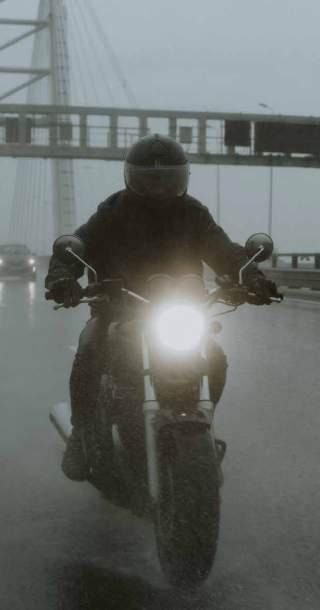
“ Then some of you will realise your keys are still in your riding pants pocket and you have to get undressed to get them. ”

in your riding pants pocket and you have to get undressed to get them, or ask one of your mates to put his hand down your pants to get them.
Either way, the bloke with no wet-weather gear now hates you with a passion so vast, you’re only alive because there are too many witnesses.
But understand this, that once you’re all dressed and back on the road, do not take any of that stuff off until you get to your destination. You have already wasted a good hour of the no-wet-weather-gear bloke’s life, had your mate grope your dick looking for your keys, knocked your bike over, and torn a hole in your wet-weather pants when your boot went through them because you’re a fat, unco-ordinated knob. Stopping again to take all that shit off is just not on.
And the no-wet-weather gear bloke is soaking wet anyway, and he doesn’t want to prolong that because you’re an inconsiderate, see-my-beaut-gear kinda bastard.
So, ride on, bastard. Ride on.
In riding on, and not putting it on, you will be travelling upon the Tao of the Wet-Weather Gear. You will know peace and you will be in harmonious synchronicity with the universe.
Of course, you may continue to own wet-weather gear. And you may certainly continue to seek better versions of it as you travel through life. You must never lose hope.
I have no issue with that. All of that builds character, and hope is all we have when all else is lost.
But until you accept the Tao of WetWeather Gear, you will know no peace.

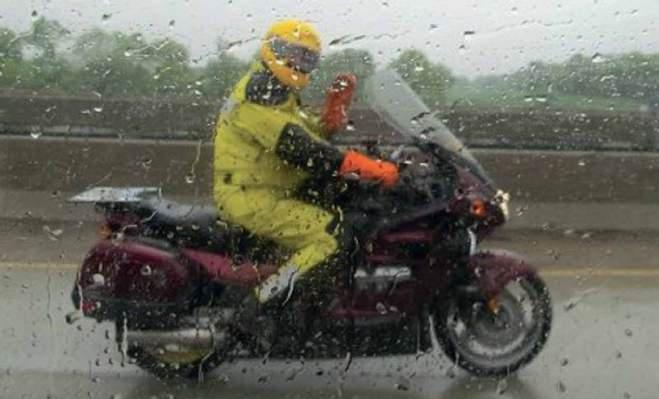

Name: Sean Goldhawk (YAMAHA)
Bike(s): Ténéré 700
Best ride ever and why:
Around Zanzibar on an XR250R. Despite being a communist state, the feeling of freedom was off the chart.
How would you define ‘adventure riding’?
A ride where the route is more important than the destination.
Strangest or most unusual thing you have seen when adventure riding: Man burning hair off a dog with a blowtorch in Vietnam.
Something a non-bike rider has said or asked you about your adventure riding or bike? Where are you going? When I get there, I’ll let you know.
The most interesting person you have met on an adventure ride?
Too many to mention but probably Abdul who invited us into his mud hut to meet the family. He was equally interested in us and our shoes. Happy is the man who has nothing. But I gave him my shoes anyway. Your favourite piece of gear and why?
Just got a Garmin GPS and it’s changed the game. Got lost a lot before, which was never a bad thing…
Hatchet or saw?
I carry neither but based on what I use at home – saw.
Your most embarrassing adventure ride moment?
Explaining the best line through a technical section then showing how it’s done and spearing off into the bush. You think you’d hear the end of it but no…
What have you learned most about yourself through adventure riding?
Adventure riding is the best way to see the world and meet cool people. What is top of your bucket list?
Madagascar, cos I reckon it would be like Zanzibar on steroids.
Anything you would like to add? When life goes tits up, at least you have your bike.



Main: A lesson in disguise. Note the pelican case tied to the back of my TT600 before being disguised in the old and dodgy plastic jerry.
Below: Photo: Mama Roche - famous amongst travellers to Africa. Her campsite in Nairobi, Kenya was also popular with motorcycle travellers.
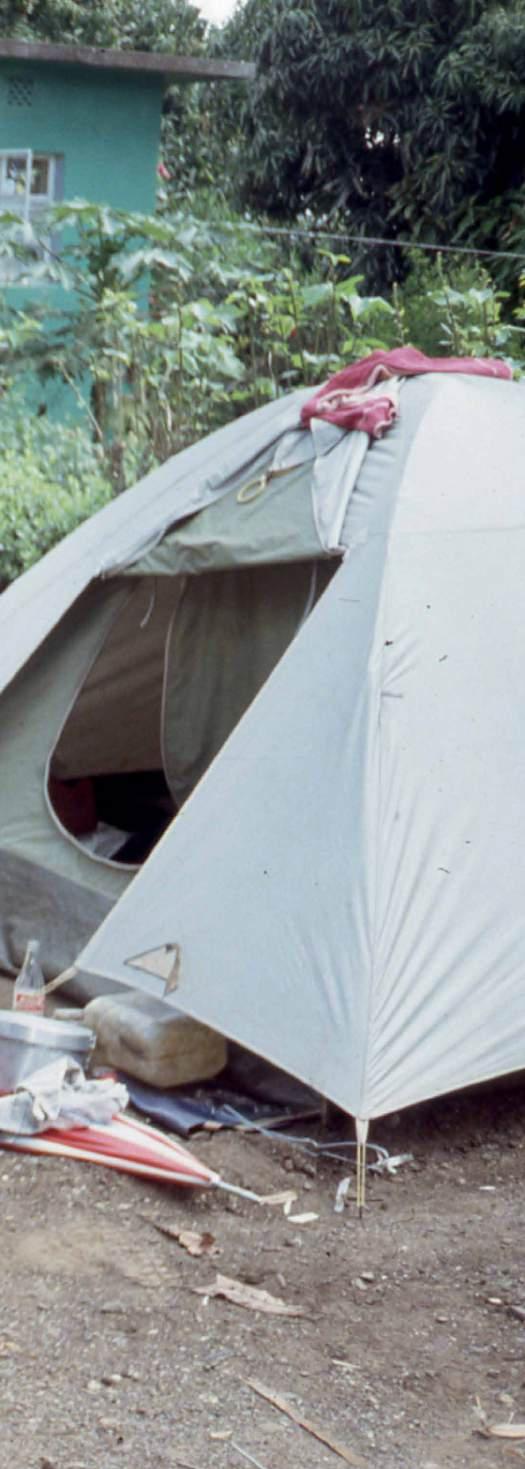
There is a scene in the Nicholas Cage movie, Lord of War, where the plane loaded with weapons is purposely left on the runway in some African country so that all evidence of illegal arms dealing is gone by the time the Feds arrive. The locals soon move in and the plane and all its contents are stripped bare overnight right down to the enormous wheels, which are rolled away as the sun rises. If you haven’t seen the movie, it’s a classic and one of my favourites, but it also reminds me so much of my travels in Africa on my Yamaha TT600 in the mid 1990s. I don’t think much has changed, in fact with the exponential population growth and associated poverty, I imagine security is even more of an issue. The moral of the story here is that you NEVER leave your bike and your gear unattended. Otherwise, that memorable scene from Lord of War will be your motorcycle.
With this in mind, security is relatively simple when adventuring overseas as well as in some places, here at home too, and revolves around outwitting the thieves. If you turned the tables and you were the one living hand to mouth where tomorrow is too far away instead of the rich westerner who obviously has a stash of cash plus stuff that can be sold for said cash, you would do the same. So here are my tips on motorcycle (and equipment) security:
At hotels in developing countries, it is acceptable for you to bring your motorcycle into your hotel room. This is where easily detachable panniers come in handy. If you need to navigate a few stairs and a narrow corridor, the staff will usually be happy to help. If it is not possible to get your bike into your room, there is the reception area or if you’re going very ‘local’ there is usually a night watchman so just pay them some money and security is guaranteed. Of course, carry a decent sized bike lock and lock your bike to something like a pole
“ The moral of the story here is that you NEVER leave your bike and your gear unattended. ”
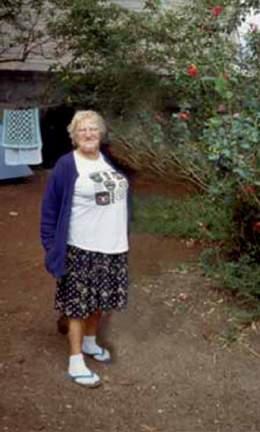
if possible. Also unpack your bike and bring all your gear with you. Having someone watch your bike is not just to stop it from being stolen, but things like mirrors, nuts and bolts and anything else that can be removed, have value too. This is why I just love that plane dismantling scene in Lord of War; it reminds me so much of my travels in Africa.
If you need to park your motorcycle on the street while visiting a local market, just ask one of the nearby street-sellers to watch your bike and hand over a few notes. While it sounds like a lot of trust is being placed in this person, that is their patch and there is a sense of honour in you asking them to watch your bike. If you’ve pulled up at a local café for lunch, sit where you can see your motorcycle. Don’t assume that because it is daylight, nimble fingers with sharp knifes won’t do a quick slash and grab.
And that highlights another important security tip: secure all equipment inside something lockable. The only other woman I met travelling Africa back in the mid 1990s, was a girl from Japan. Today, there are hundreds, if not thousands of women travelling the world by motorcycle and many are doing it alone. Our paths crossed in Kenya. I was heading north and she south. Not only was her bike top-heavy with all her gear piled on the back of the seat and rear mud guard,

but the whole lot was held together with a few bungy straps and a bungy net (see photo). There would be nothing left for the thieves as most would have bounced off from the corrugated and pot-holed roads. But after making a few adjustments as well as some bike security advice, it was a vast improvement. So padlocks are a must, but go for a quality set that all have the same key otherwise your life will quickly become rather complicated. Technology has come a long way since the 1990s. Today we are constantly surrounded by global positioning system signals from satellites so even in the most remote places you can hide a GPS tracker on your motorcycle and track via your smartphone. Your bike is probably more likely to be stolen in Australia – even from your shed - than while on the road in developing countries, so it’s a good idea to put a GPS tracker on all your bikes… just for peace of mind.
This might be a little difficult if you have a new BMW GS1200 and matching hightech riding gear that looks every bit its $2000 price tag. But do try and tone it down even a little. With my Yamaha TT600
Top: Secure your valuables: With my Yamaha TT600 in northern Kenya. Padlock everything, ideally with the same key.
Right: How not to pack your motorcycle: As well as being top heavy and unsecured for Africa’s rough dirt roads, Japanesse motorcycle traveller Kaoru’s gear would also be an easy target for thieves.
and its rusty pannier frame, leather panniers that dust sticks to like glue, a faded Gearsack and discoloured Acerbis 21 litre plastic fuel tank, it was not too difficult for me. When my ‘flashy’ Gore-Tex bike jacket was stolen early in my travels, my only option was to buy a faded navyblue trench coat from a local market. It toned things down dramatically as I suddenly morphed into a hobo. It must have convinced the locals as I was no longer seen as ‘business’ but a ‘poor starving traveller’ in need of a meal.
Back in the 90s there were no ATMs or smartphones with associated tap and go. I expect, if you get off the beaten track today, little has changed. So back then,
cash was king and I always carried some US cash in small denominations to account for rapid inflation in some countries and changed only what was needed for the day. While my passport was always on me, other valuables and important documents like my carnet de passage were stored in a pelican case (a water, dust and smash-proof lockable case made of plastic resin). I disguised my pelican case inside an old plastic 10 litre petrol container. I cut the bottom out of it, slipped it over the pelican case and then sewed a hessian bag around the container (see photo), which was then discretely locked to the bike’s pannier frame. As petrol containers are in themselves of value in some developing countries, to further deter the thieves, I put a piece of plastic bag under the

screw cap indicating that the cap was broken and the container would leak. Any potential thief would go for my actual 10 litre spare petrol container, instead of the dodgy one. This would also deter any rebel soldiers at checkpoints in places like DRC (formerly Zaire). Anything with padlocks on it would attract immediate attention with hostile demands for it to be opened aided by the pointing of an AK47.
My US dollars were hidden in various spots on the bike and inside a leather belt. The shell of the TTs small battery (which was irrelevant in Africa, as it’s only needed for its indicators), stored more cash in a rugged zip-lock bag. Then there was the false bottom on my toolbox welded to the front of the engine crash bars. Unfortunately, French francs (needed in central and west African countries), while artistic, are very thin and delicate and when the zip-lock bag leaked, the francs almost disintegrated. While I was never held at gun point with demands to hand over my money, the idea behind having several hiding spots, was that I could reveal only one, hand over the cash, and hopefully the thieves would
Our Adventure riding guided tours are all about experiencing Tasmania and combining it with the simple joy of motorcycling. We will have you winding through endless corners, up and over hills and mountains in the morning and then cruising wide-open sweepers beside the ocean in the afternoon. But simply having great motorcycling roads doesn’t make a memorable tour. We combine riding with the fantastic local foods and premium accommodation Tasmania is so famous for.
go their merry way satisfied.
Often at border crossings there would be demands to pay some made-up fee from the officials. My ploy was to always whip out a travellers cheque saying I had no cash. They would refuse, I would wait an hour or two (I was always behind in writing my journal) and then I was allowed through with never a payment made. I don’t think travellers cheques exist these days but back then I could always report it stolen and have it replaced. I never paid these ‘imaginary fees’ as it would just make the situation far much worse for those travellers coming behind me.
Another personal security and anti-theft tactic, which I would not recommend unless you happen to find a dead death adder, is to skin a snake and place it strategically across the front handlebars of your bike. This is where I carried my tent. I came across the dead death adder, one of the world’s most poisonous snakes, while staying with a zoologist in the Ituri Rainforest near Epulu, DRC. Superstition runs high in some of the more remote places you may find yourself and snakes,
even dead ones, are to be avoided at all costs. Along with the snakeskin, I also had a panga (machette), which I hoped further added to my aura of strength and indestructability. In northern Kenya, I bought the panga from a local Samburu man and when I placed it under the straps that secured my tent across the handlebars, he’d nodded his approval.
‘Your enemies will see the panga and know you will fight them,’ he’d said. ‘No, I won’t be fighting anyone. But hopefully they will see it and leave me alone,’ I replied with a nervous laugh.
I will never forget his words that followed. ‘You do not have to fight. You just need to show you can fight. Strength also comes from here,’ he’d said and lightly touched my head with his index finger. You are a strong woman, but you must stand tall like a man. Nobody will attack you if you are strong. Never show fear. If you do, then you will be lost.’
His words inspired me to stand my ground on the only time I really feared for my life in Africa. I was in a remote part u

Unguided Motorbike hire available for those who would prefer to find their own way in this motorcycling paradise.
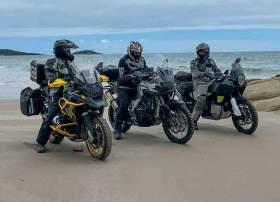


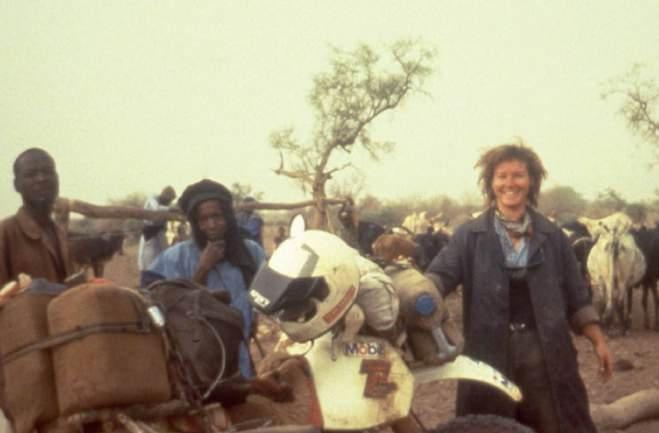
of Uganda staying at a local hotel and preparing to leave the next morning, when my ‘street smarts’ kicked into action as the situation was about to change dramatically and was likely to end with me being fed to the crocodiles in nearby Lake Albert.
This extract from my book Ubuntu: One Woman’s Motorcycle Odyssey Across Africa (Black Inc. 2016) details that moment:
Since arriving at the hotel, I’d felt a growing sense of uneasiness and was now distinctly aware of my vulnerability. I quickly finished refitting the tube after repairing the puncture. Then as I packed the bike, the four men who’d helped me the previous night stood watching from where they stood in front of the two exits from the courtyard. Earlier, women casually wandered in and out of this enclosed area. Now they were gone. And the older of the men, who I guessed was about forty, had moments before yelled at the children and they were gone too. My hands shook nervously as I packed away my tools. I looked up and the four men moved a little closer. My panga was strapped to the tent that lay across the top of the handlebars. I removed it and placed it next to my bike and thought of James from South Horr and his words about showing strength.
‘You did not pay for the tea,’ said the older man, who I assumed was the hotel manager.
‘I’m sorry. My mistake. Is this enough?’ I asked and handed him 500 shillings
(about twenty cents) from the small change pouch attached to my belt. Without a word, he took the money.
‘Why did you chase the kids away?’ I asked, holding the tin of pepper spray in my shaking hand, grateful Martin, the German motorcycle traveller I’d met in Kampala, had given it to me.
‘Too many around,’ he said bluntly and I noticed he was wearing the watch I’d given to Kennedy, the young boy who I’d chatted to earlier that morning.
Another of the four men, the tallest, moved to stand next to the oldest. Both glared at me with piercing black eyes. I stood my ground, leaving no doubt that I was fully aware of their intentions. Surely, they would not. But hidden on me and my motorcycle was US$2300 dollars (half was in cash the other half in travellers cheques) and they knew it. They knew that in order to travel, I must carry some money and whatever I carried was more than they would earn in four or five years.
As I finished packing the bike, one of my gloves fell under it. I stood and stared at it. The oldest man took a step closer and was only a few metres away. No one moved. The other three looked tense as though preparing to pounce and I stood ready to turn into a wild cat. I played out my defence. I’d squirt the pepper spray directly into their eyes. I’d dive for the panga and run for the exit at the back of the courtyard. Time stood still. But just as quickly as the men had surrounded me, the mood changed and they moved away. It was as though for an instant they were possessed by some dark
Left: Don’t Be Too Flashy: The ‘hobo look’ can help deter thieves who are quick to recognise the cashedup traveller. Note the pelican case is safely disguised in the plastic jerry. Can you pick which one?
Below: Buy the book: Signed copies of Heather’s first book, Ubuntu: One Woman’s Motorcycle Odyssey Across Africa are available from www.heather-ellis.com
force. These men would have been about twenty during the bloody years of Amin and Obote. What atrocities had they seen? What massacres were they part of? For a moment they were back in that savage time. But with peace came compassion as well as rules and police. I was thankful their spirit was still true and I did not meet with a terrible, unspeakable end.
I wheeled the TT through the foyer and the men, who seconds before I was certain were my enemies, now helped push it down the low steps. As I quickly prepared to leave, Kennedy appeared beside me.
‘Sorry about the watch,’ I said and put my hand on his shoulder. He shrugged his acceptance that adults always overpower children.
‘That man, he is bad man,’ he said looking down and kicking the dirt with his bare feet.
In my relief to be away from the hotel, I rode off in a trail of dust, opening the throttle to let the TT roar with all its power.


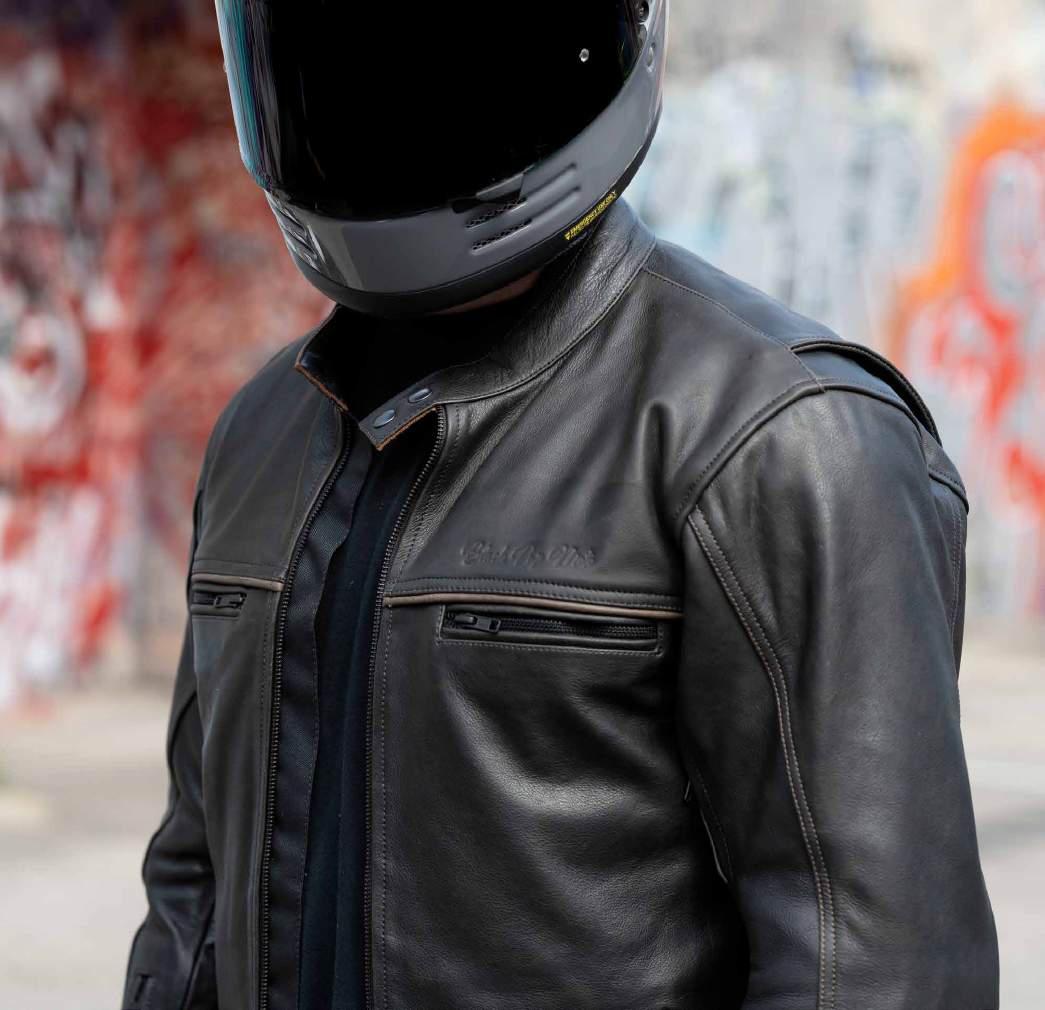




Name: Jordan Kunda
(Cape York Motorcycle Adventures)
Bike(s): KTM exc500, GASGAS 350, CFMOTO 800
Best ride ever and why:
I’d have to say the telegraph track is my all-time favourite ride. I just love everything about it, from the sand, the crystal-clear creeks, the big berms and all of the obstacles in between.
How would you define ‘adventure riding’: Adventure riding to me has always been about exploring new ground. going somewhere you haven’t been before and seeing the amazing country that we call home.
Strangest or most unusual thing you have seen when adventure riding:
A good mate of mine Jeremy and I found ourselves in a situation where we had to drain oil out of an abandoned jeep to keep one of our bikes going on one of our night missions to retrieve a bike in the middle of nowhere. Some might say that’s a bit unusual…
Something a non-bike rider has said or asked you about your adventure riding or bike:

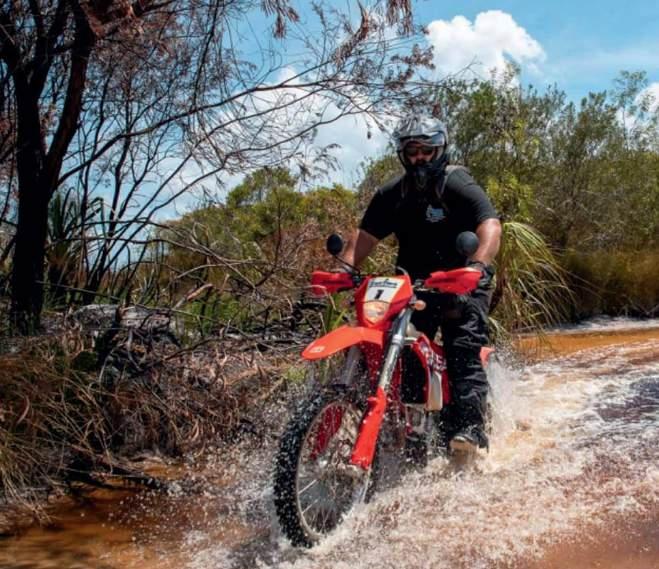
Nearly every week I’ll have someone ask me if my arse gets sore. A lot of people that I meet up the cape ask about how we get our bikes through all of the water crossings as well.

The most interesting person you have met on an adventure ride:
I meet ALOT of interesting people while I’m riding. It’s one of my favourite things about my job, but one that comes to mind would have to be Craig Lowndes, just a great guy, really down to earth and easy to have a conversation with.
Your favourite piece of gear and why: I spend a lot of time inside my helmet. I’d have to say that’s my favourite because I’ve fitted it out with a Cardo freecom 4. Being able to play music while I ride makes it that much better.
Hatchet or saw:
Saw for sure, hatchets are too much work LOL
Your most embarrassing adventure ride moment:
Uhh… going over the hangers down Gunshot with an audience of 30-40 people… not my finest moment. What have you learned most about yourself through adventure riding: There’s a lot that I’ve learned about myself
riding a bike. A lot of it is realising how capable I am of working out any problem that comes up, knowing that you’re far from camp and need to work it out with what’s in your backpack or bumbag. I learnt that I really enjoy a little bit of chaos.
What is top of your bucket list: I’ve never really sat down and thought about my bucket list. All i know is i want
to travel the world and experience as much of it as I can.
Anything you would like to add: Growing up with my mum and dad starting the business and building it into what it is today, and starting to take on a role as one of the guides with a team of great people and great riders has taught me a lot, and I can’t wait to keep riding!







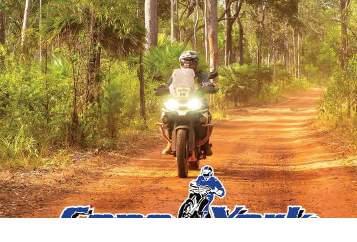





Words & PICtures bY Graeme sedGWICK




Mick McDonald has led his fair share of global motorcycle adventure tours since 2007 when the self-confessed long distance truck driver of 25 years found himself the accidental founder of a niche motorcycle travel enterprise he never imagined. His dream to ride a motor bike from London to Vladivostok with mates morphed into a charity ride to raise money for the cause of an inspirational woman, Cathy Mclean, whose passion for travel and life suffered acutely from the debilitating motor neurone disease Friedreich’s Ataxia. This is a rare inherited disease that causes nervous system damage and movement problems, that usually begins in childhood and leads to impaired muscle coordination (ataxia) that worsens over time.
Mick has organised expeditions through flung places such as South America, Russia, the historical Silk Road deep into Mongolia, and was the first tour operator to ride the spiritual wasteland’s of the Road of Bones and more through central Asia and Africa.
Before the terrible personal realisation of becoming too creaky to walk or climb aboard my transport method of choice, and why I was so delighted to be able to adventure through South Africa and Namibia alongside others participating in Mick’s final tour as a Leader for the accidental enterprise he nurtured –Compass Expeditions.
So it was, off to South Africa and the capital of Western Cape Province and the city seaport that is Cape Town; a destination that demands attention and curiosity. Robben Island, an intriguing World Heritage listed site is a short Ferry ride offshore from the Cape. Robben delivers an indelible lesson into mankind, and definitely the Island’s most famous inmate Nelson Mandela, was the South African freedom fighter incarcerated here for eighteen of his twenty-seven years in custody.
Day One: Departing Cape Town and days of 26-degree cloudless blue skies turned into an utterly saturating affair thanks to an unusual rain event that drowned and immediately blurred the spectacular fullness of what is one of these parts most iconic coastal roads, Chapman’s Peak Drive. A serpentine affair around False Bay via Simonstown and Rooi Els that’s been remarkably attached to huge rock faces that draw deep down into the Atlantic and Indian Oceans before Cape L’Argulhas the southern-most point of the African continent.
We came to the small, majestic seaside village of Arniston, a settlement known by South Africans as ‘Waenhuiskrans’ – meaning ‘wagon house cliff’ which refers to the size of one of the village’s biggest tourist attractions. A huge cavern in the cliffs that hug the shoreline. As for Arniston’s name? It came about due to an u


unfortunate miscalculation that saw the troopship HMS Arniston steering bow first into Agulhas Reef.
The rain was a drowning baptism that unfolded into an epic ‘motor-bike-rider’s dream adventure. It was a ride that travelled some 3500Km comprising 1575kms of pavement and 1925kms of dirt dancing, ranging predominately from hard packed surfaces, into heavily gravelled zones, and then some recently graded mixed types, plus some rock embedded puncture delivering surfaces.
We moved across and through landscapes that were immediately breathtaking, as much as bewildering in terms of enormity and vastness.
Day Two: Another rainy day but we knew things had to get better further northward. We passed through the spectacular Zuuberg Nature Reserve country with en-route hospitality by way of Mick’s many and absolutely surprisingly great food stops.
On this day a licensed place of hospitality named

Ronnie’s Sex Shop - which from a sustainable perspective made no sense at all – was utilised. Owner ‘Ronnie’ happened to be seated beside his Shop’s Bar and offered no enlightenment about the name of his place.
Aquila Lodge’s Game Reserve accommodation was used at day’s end and we all had a marvellous dusk wildlife sighting of hippo, zebra, ostrich and lions.
The speed limit on South African freeways is 120kp. On main roads it’s usually 100kph and in the cities 60kph. Speeding is an offence you’ll be fined and/or arrested for. STOP signs face all roads at cross intersections that are not controlled by traffic lights. The understood protocol is that drivers stop their vehicles and then wait their turn to proceed, based upon the logic that the person who arrived before the other proceeds FIRST. Reinforced with the words ‘Trust me - it works’ - no aggro, no impatience, no hand gestures, or impatient abuse - merely patient
u


courtesy that definitely works!
Despite this, one of the group’s motorcycle rider’s almost wore one of three utterly crazy youth who decided to seriously engage the perilous pursuit of jumping in front of on-coming traffic. It was a moment Canadian rider Terrance ‘TJ” James witnessed when I had to take evasive action to avoid the insurance money grab circumstances that could have been catastrophic.
Day Three: No rain but chilly and our group rode westerly onto Ceres, where occasional dirt and pavement blurred into the dirt tracks of the mighty Cederberg Wilderness area.
A stunning wilderness encompassing some 71,000 hectares of rugged mountainous terrain make it an outstanding destination for adventure sports including motorcycle riding. Ahead, the dust plumes from Cederberg’s dirt roads indicated others were on the
Above: A view of things to come. Below left: Bring it on, SAND !! Below right: Rhinos up close and personal.
approach and closing in fast. Emerging into view came a group of peg standing KTM riders who slowed and passed, all thumbs up to affirm we were now about to engage some of the tour’s more exciting terrain.
The mighty Cederberg mountain environment (some 250km from Cape Town as the crow flies) didn’t disappoint! A massive wilderness area that derived its name from the endemic cedar tree while the San and Khoi people who inhabited the locality from early times, left behind a rich legacy of rock art before European settlers began farming in the eighteenth century.
The riding compared to what had proceeded this stage, became epic. There were narrow passages mixed with sharp rocky surfaces split by abrupt cattle grids,

each a hazard not kind to inattentive 750 riders whose bike’s soft alloy wheels weren’t ideally suited to hammering harsh ruts or exposed concrete form work that framed cattle grids.
Onward between steep up and down passes and, on one occasion, a ridiculously positioned choice through a pair of cattle grids split by a stone post that presented upon an exposed rock crest.
It was ‘game-on’ irrespective of whether you happened to be of less or more bike riding experience and certainly reinforced the marked difference in the bike capability 750 and 850 bikes offered compared to the totally superior suspension capabilities of the larger 1250 type bikes that rider Cameron Coles affectionately named Power Rangers.
A performance miss-match another member of the group (former Australian Safari rider David ‘Beak’ Murray) confirmed unequivocally when he borrowed one of the 1250 Power


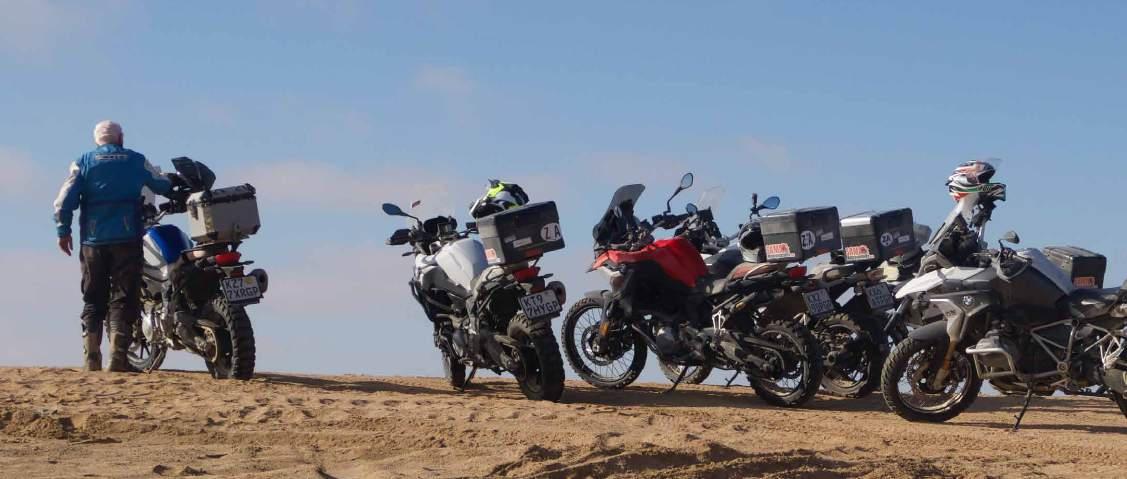
Rangers for a squirt when the group paused at Cederberg Oasis café come Eco-tent lodgings.
Quite simply the Cederberg is a magnificent part of South Africa nomatter how it’s sliced. The Clanwilliam cedar trees against cliffs and overhangs at altitudes of more than 1500m above sea level, and rock art that’s been dated to be more than 28,000 years. A peak named Sneeuberg, highest at 2027m above sea level towering 700m above a plain, where flightless adult ostrich stand 2.75m tall with almost half that height being neck. These roam with dassies, baboons, klipspringers and the wilderness’s largest but shy predator the leopard. Coloured by snow Protea on the highest peaks and some sixteen snake species, there’s no doubting the Cederberg area is a ‘not for sissies’ area.
Day Four: The final leg of the day’s ride into Clanwilliam, known for its leather footwear manufacturing. Of all things, a
sign marked ‘Algeria’ defined a directional change that rose along a twisting passage on the eastern side of Olifants River. For tail enders this meant eyefuls of distractive glare as the sun fell to the horizon making it almost impossible to pick many soft sandy patches along its passage into the township nestled beside Clanwilliam Dam. In contrast to rider Mappo’s innocent belief that he was off-the-pace and lagging, he astonishingly found himself amongst the earliest thanks to a fortunate navigational error that allowed him to savour a time saving brisk twenty-fivekilometre paved run on the western side of Olifants River into Clanwilliam’s overnight. Much to Mick’s amazement and that of the group who thought they’re lost Mappo!
Day Five: The group embraced more expansive northern frontiers by way of some spectacular paved touring that brought into conversation a very special story around a remote grave’s
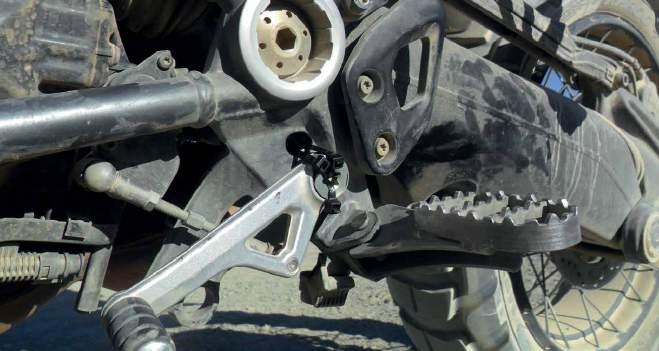
location to honour an English soldier who died during the Boer War. Back to dirt before proceedings onto a superb overnight farm-stay at Papkuilsfontein Homestead that has been in the same family for six generations and flanks Oorlogskloof Canyon. A relaxed, enjoyable evening by the fire side enjoying homemade pumpkin soup and vegetable main with Lamb shanks served upon bone chinaware with silverware cutlery. Sumptuous.
Day Six: Away from Papkuilsfontein Homestead the adventure moved toward Nieuwoudtville, to a motorcycle collection that has to be witnessed to be believed. Hidden behind the tin walls signed ‘Protea Motors’ that appears upon first sight to be nothing more impressive than an almost disused motor garage, we found a dust covered collection of motorcycles representing just about every motor bike incarnation that’s graced mother earth. Its owner, allowing us in, only because we’ve PAID to refuel ‘all’, showed his ‘retirement collection’ of no less than 420 complete motorcycles press parked against each other. Including what its owner believes the only complete 1951 JAP motorcycle to be in existence. In short, a totally jaw dropping, priceless assembly of bikes. Away from Protea Motors, Van Rhynsdorp Pass and more heavily gravelled passages presented, before joining freeway pavement into an over-
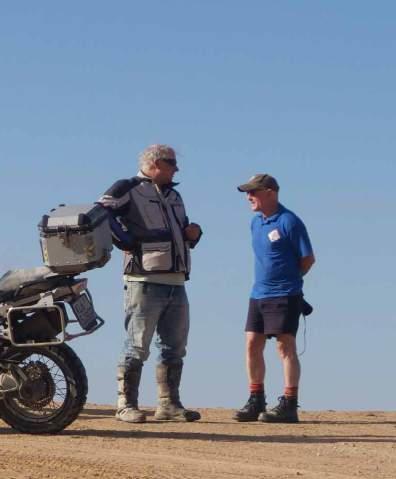
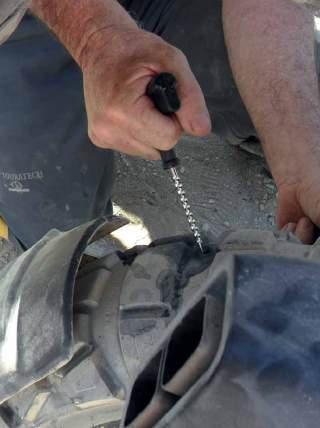
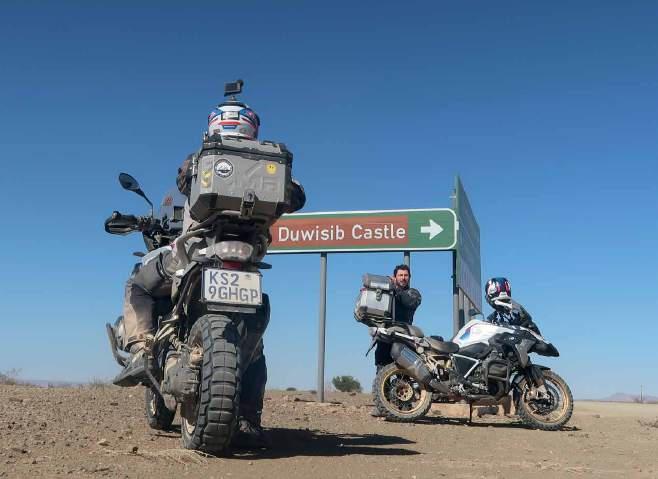
night stay and dinner within a mysterious Bar in central Springbok.
Day 7: Was a harrowing time especially for tour leader Mick, who’d completed more border crossing than most when he was told that he, together with his colleagues, were refused entry because of a technicality related to document misunderstandings. This was an issue that threatened group separation in anticipation all would reunite somewhere later in Namibia. Dauntingly real – the prospect was finally averted when Mick managed to make contact with a connection of a connection who was able to quell a situation that had become a robust communication about documentation correctness.
Although the delay significantly scuttled travel time, the ensuing riding was utterly spectacular through the vast desert landscape of southern Namibia to an overnight stop at an amazing if not truly bizarre Gondwana ‘Canyon’
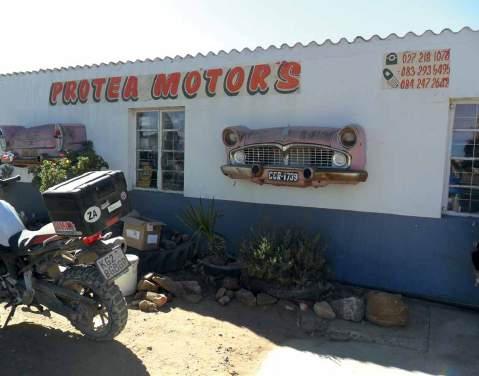
Roadhouse, some forty five minutes or thereabouts adrift of the mighty Fish River Canyon. Arguably one of the planet’s deepest canyons, its dimensions sit comfortably alongside Grand Canyon in Arizona, USA, the Great Canyon of Yarling Tsangpo River in the Himalayas and Copper Canyon in Mexico. Its measurements are impressive being 161kms long, 27kms wide and up to 550m deep. Its towering rock faces and deep ravines were formed by water erosion and the collapse of the valley due to movements in the earth’s crust over 500 million years ago. Fish River extends some 800 kilometres to be the longest river of Namibia and the Canyon’s reveal in the stillness of dawn is a sight to behold.
Day 8: Roughly 290kms of the loose gravel mixed with 100kms of paved running through more stunning desert vistas passing of all things a massive Date palm farm and oddly also a vineyard,
u

before a cement causeway below a massive dam retaining wall. We reached the remote Burgsdorf Goat Farm’s gateway entrance, which presented a deep sand ride of 5kms into the massive conservation farm run by the Rossouw family that challenged most. including force full 850 rider Andrew Cornford to greater or lesser degrees. The day’s end into Burgsdorf conservation farm offered us a close and personal encounter with some magnificent rhinos and cheetahs, before another wonderful night of true Namibian hospitality around a dining setting that almost overshadowed the rhinos: such was the magnificence of the setting’s peace and serenity.
Day 9 and 10: We ascended to over 1500m westward through the oldest desert on earth enroute to Sesreim, on the edge of the Namib’s stunning presence with its many dark sand dunes and rocky outcrops in stark contrast to the sands of the desert. We observed oryx seeking shelter under occasional acacia trees - a sight to be seen to be believed. It was hot. Dry heat that lets you know about its 30+ degree presence late morning and that doesn’t leave until late afternoon. In the saddle it amounted to a demanding 220kms of gravel intermixed with short sections of sand with tall heaves of gravel in the centre. The last 30kms into Sesreim washeavily corrugated to Dead Valley Lodge situated inside the Namib-Naukluft Park, the fourth largest National Park on the planet and a welcome sight for two nights and a chance to reflect upon experiences. Situated along the Atlantic coast, the park borders Dorob Park to the north, the restricted Diamond area in the south, and shares the border with the private NamibRand Nature Reserve to the east. In the northeast, the Naukluft Mountains form part of the park as well. Sossusvlei and Sesreim are the main attractions. Sossusvlei is a salt clay pan surrounded by dunes that’s approximately 60kms away from Sesreim and another of our memorable sunrise experiences. This time

a dune climb that rewarded 360-degree views across a sea of towering dunes glowing bright orange including the biggest of them all - ‘Big Daddy’ - and a further opportunity to visit the Deadvlei, a sight that photographically makes it into every tourist brochure of Namibia.
Day 11: Our day commenced with a level of quiet optimism that road graders were in the area so there was a chance some of the day’s gravel riding would be above average. However, the only fly in that optimism was that it wasn’t abundantly obvious where the lesser of the rough corrugations faded and re-appeared amongst the day’s 350kms of gravel through Gaub Pass before the granite rocks of the Spitzoppe and highest point Brandberg Mountain.
We did have a paved run toward the heavily industrialized port of Walvis Bay through to Swakopmund. This is a city built around the mouth of the Swakop River, at the southern edge of the skeleton coast sandwiched between the Atlantic coast and the dunes of the Namib Desert. Its name translates from the GermanMouth of the Swakop. Along the way we crossed the Tropic of Capricorn and stopped at Solitaire Road House to refuel and savour some food and hydration. We visited Solitaire’s bakery which offered the best and broadest selection of
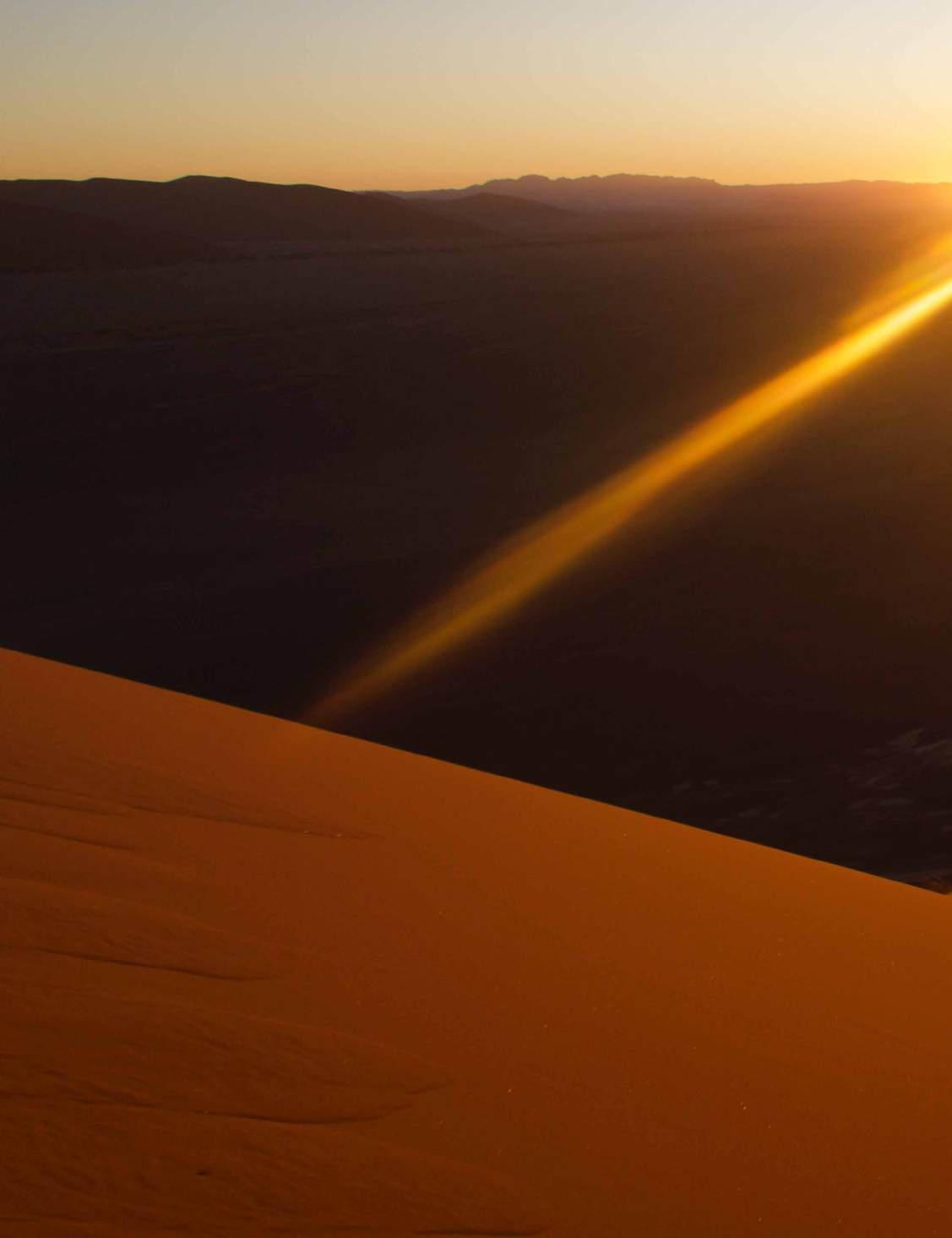
pastries imaginable and we had a chance to understand a little about the bakery’s creator Moose McGregor, whose grave lies within the broader precinct that is Solitaire. The day concluded with a well earnt meal and drinks at the ‘TUG’, a restaurant banged together with an assortment of what was once tugboat hull cabins jammed onto the shoreline. In all, a rather bizarre setting that didn’t disappoint.
Day 12: Revived and acutely aware the ride was now running down its final kilometres, the push progresses northward along the Skelton Coast visiting Cape Cross before turning east cross country onto Omaruru Game Lodge. This was a journey that allowed ample opportunity to absorb the vast scale of these parts of Namibia together with its mineral and diamond mining activities as well as introducing us to the Herero and Himba tribes. Our group was again reminded of the softer, gentler spoken personality that’s typical of the Namibian people’s disposition. Omaruru Game Lodge at the end of a solid day’s gravel riding that was, in comparative terms, a straightforward blast that didn’t disappoint upon arrival when riders found themselves moving between numbers of zebras who weren’t the least interested in their space invaders to the absolute

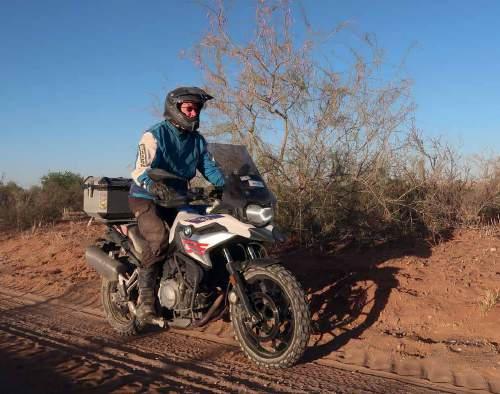


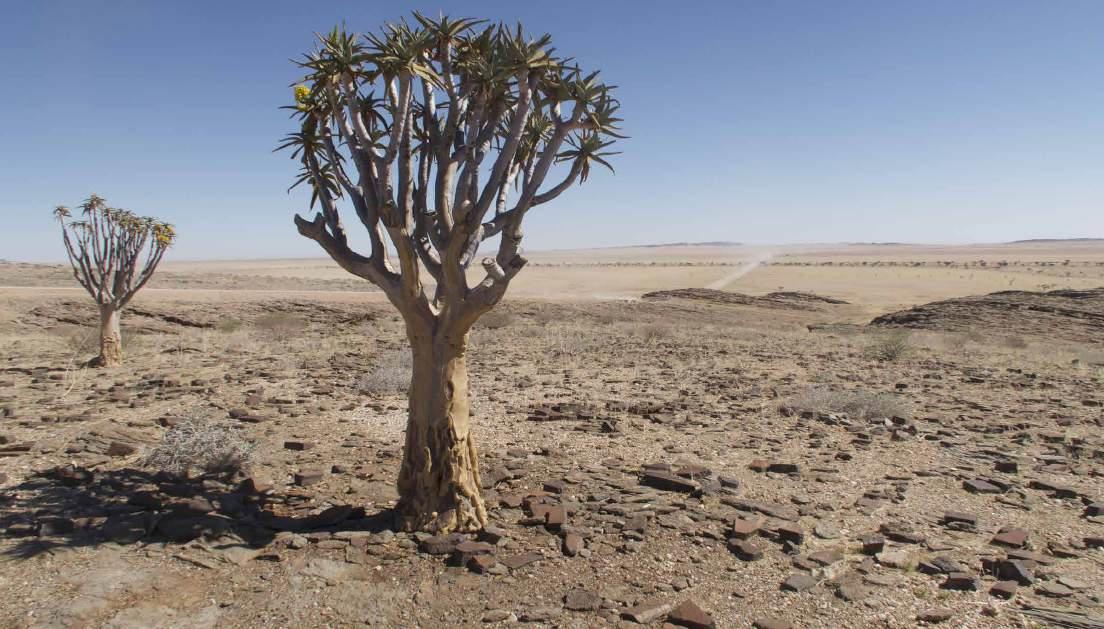
surprise of us all. Plus, a thrilling forerunner to pre-dinner drinks within an arm’s length of inquisitive giraffes, wildebeest, rhinos and more.
Day 13 and 14: Note our power ranger riders also included Rob Bent, Byron and James Bassett, USA motor-crosser Robert Highfill, Ken Armstead, John Mcled, Canadian TJ and forceful 850 rider Andrew Cornford. The last of the ride’s gravel, and what a hoot it turned out to be! Inclusive of a refuel stop came a lunch break during which Ken Armstead decided he’d activate Namibia’s only joy-riding service. The aim? To give any number of eager Namibian woman a circuit ride around the petrol station’s massive apron area much to the delight of increasing numbers keen to enjoy his joy-ride service. However, it was the final hard packed dirt run that will stick in many memories because it allowed opportunity to crack open throttles much to the enjoyment of riders Rob Bent, Byron and James Bassett, USA motor-crosser Robert Highfill, Ken Armstead, John Mcleod, Canadian TJ, Damien King, Mappo, Beak and Cameron Coles at speed.
We also experienced what is described as one of the world’s greatest game viewing venue. Etosha National Park. Another day off the bikes to experience and absorb the sights that distinguish
Africa’s greatest ‘wild’ roaming animal national park destinations.
Revived via the final run, a touch short of 500kms southward to the capital of Namibia, Windhoek. This became both a blast and fitting conclusion for Mick McDonald’s last ride as a tour leader. And also a sustained opportunity to enjoy riding at Namibian 120kph freeway pace. Needless to say those kilometres from Etosha via Tsumeb, Otjiwarongo, and Okahandja and eventually into Windhoek very definitely rolled past at a pace that
Above: You never tire of the stunning views.
Below: New Zealander ‘Allan’ checks-in with ‘Tail-End Charley’ – Dave ‘Beak’ Murray.
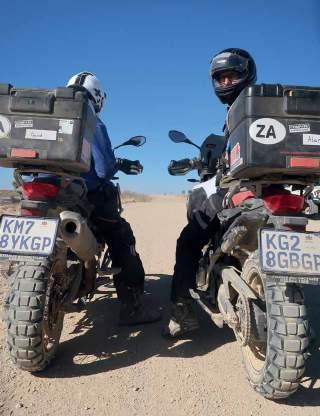
knocked both distance and time in saddle out of the park.
At the end of it all, it had been a remarkable adventure, irrespective of whether one decided to stay on to chill an/ or visit Heroes Acre. This is an official war memorial monument, complete with marble obelisk and a bronze statue of the Unknown Soldier at its centre. Heroes Acre site contains a parade ground and a grandstand for 5000 people while the burial site contains 174 tombs, not all of which are occupied. Heroes was created to foster a spirit of patriotism and nationalism and to pass this onto the future generations of Namibia.
Upon reflection, I think it would be fair to say it was a most illuminating and revealing travel experience. The camaraderie, exceptional wildlife encounters, breathtaking wild landscapes intermixed with ancient cultures. An experience that got under your skin and fed the soul. Can there possibly be no greater experience? I’m sure Mick understands more than most about the unique freedom that unfolds as one journeys. It can be Epic! So maybe if you seek a motorcycle adventure that can shape who you are, may I suggest you’d be hard pressed to match what Compass Expedition’s offers and what Mick McDonald has been a significant part of establishing for those who enjoy motorcycle travel.

Bikes: YAMAHA DT175, URAL SIDE CAR OUTFIT, R1 YAMAHA, GS500 SUZUKI
Best ride ever and why:
Outback ride from Silverton White Cliffs with Husband and Kids on 3 bikes and Camping under the stars.
How would you define “ adventure riding”: Love what’s around the corner. Love the changing landscapes and just being out bush. Most unusual thing you have seen when adventure riding:
When in the outback all we could see at one point was just sand, rocks and the horizon, and no-one for miles - AND the Bright stars at night. Something a non-bike has said or asked about your adventure riding or bike: Wow! You ride a bike at your age. Go girl! Your favourite piece of gear and why: Good riding protection, as once I was run off the road and my gear saved me. Hatchet or saw: Hatchet. Easier to chop wood! Your most embarrassing adventure ride moment:
When my husband took me up a steep rutted mountain and being stubborn and new to riding, I fell off heaps of times trying to get back down the stoney rutted mountain. I was just using the front brake and must have fallen off 4 times! I finally used both brakes together and mastered the downhill mountain.
What have you learned about yourself through adventure riding:
That riding in the outback sand is to keep your speed up! To enjoy the country we live in and that we are very lucky here in Australia for Adventure riding. The thrill of motorcycle riding is well worth the risk.
What is top of your bucket list: More outback rides and Cape York. Anything you like to add?
I love the thrill of riding adventure riding and also road riding.
Also just love following Norley (Itchy Boots} on YouTube and her amazing motorcycling adventures.


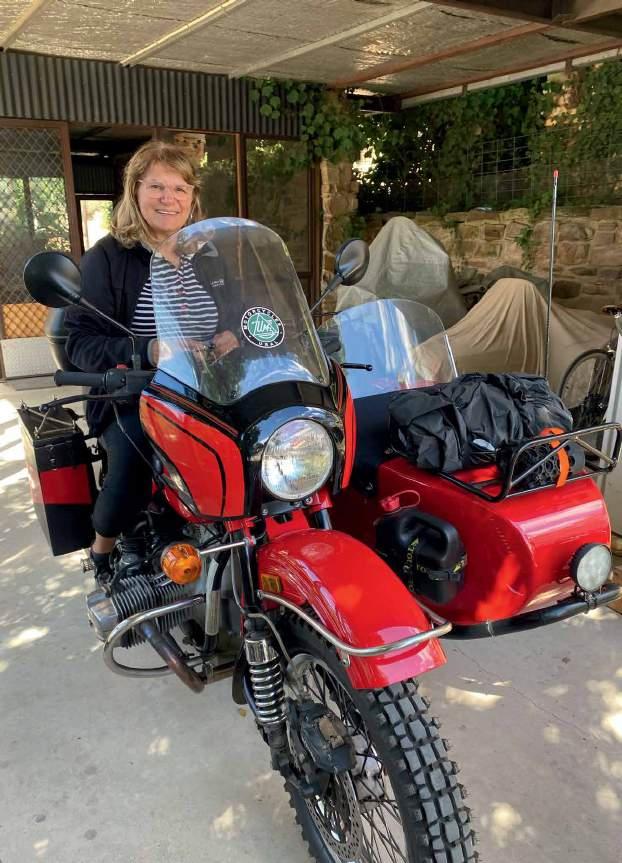
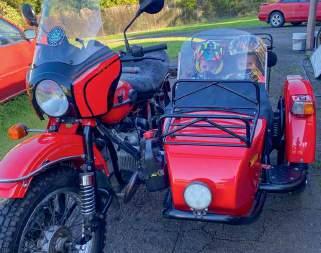
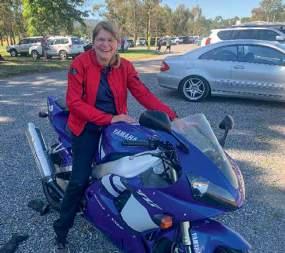



Morocco’s (Maghreb al Aksa) proximity to mainland Europe and oriental traditions makes it a unique blend and perhaps the perfect first landing on the shores of Africa for many motorcyclists. Situated in North Africa (called the Maghreb), officially known as the Kingdom of Morocco, this beautiful nation is a true traveler’s heaven.
With the gorgeous Atlas Mountains rippling through the mainland forming the dorsal spine of the country, one side fades off into the Sahara Desert, while the other is flanked by the Atlantic Ocean and the Mediterranean Sea. The geography, thus, is largely mountainous with an incidence of arid regions and coastal plains. It also occupies an important vantage point along the Strait of Gibraltar.
The climate, too, varies from semi-arid in the desert regions, to Mediterranean along the sea, to continental and alpine in and around the mountains. The best time to visit Morocco is during spring (mid-March to May) or autumn (September to October) to avoid scorching heat and peak winter.
with narrow lanes and blue and white houses. Motorcycles aren’t allowed beyond a certain limit, and one will have to walk, but that adds to its charm. It offers native handicrafts as well as woven blankets and wool garments. Its goat cheese is also famous. Nearby is the Kef Toghobeit Cave, one of the deepest caves in Africa. The nearby Rif Mountains are also known for the production of Kief (a drug) so do not wander off as the locals do not like unwanted visitors.
Rabat, the capital city, houses the country’s most important museum, the Royal Palace, and the Mausoleum of Mohammed V, as well as several historical attractions. The Hassan Tower, carved with beautifully intricate motifs, is all that remains of ruler Yacoub al-Mansour’s grand vision of a mosque on this site. Rabat’s Kasbah district is also a top-rated attraction which is home to the Kasbah Mosque, Rabat’s oldest, and offers stellar views over Salé and the Atlantic Ocean. Its colourful medina is home to some spectacular mosques that definitely deserve a visit.
“ The climate, varies from semi-arid in the desert regions, to Mediterranean along the sea, to continental and alpine in and around the mountains. ”
An important thing to keep in mind is that your trip may be affected by the Islamic festival of Ramadan, so plan accordingly.
Riding in Morocco is a heck of an experience. While most of the regions have good-quality roads and the riding is generally smooth, some country roads provide you with some off-roading fun as well. The Atlas Mountains region deserves a special mention. For a lot of riders, Spiti and Ladakh in India are the epitome of riding. The region surrounding the Atlas mountains has a very similar feel. Rugged and vast.
Chefchaouen, a mountain village situated in the Rif Mountains, has a small medina
Casablanca, located nearby, is Morocco’s largest city. For all the movie buffs out there, it is a household name. And although the actual movie wasn’t shot here, the city does have its own rendition of the famous “Rick’s Café Américain”. Its main attraction is the Hassan II Mosque, the second largest in the world, with the world’s tallest minaret. It also has beautiful seaside districts like Oualidia and Mohammedia, along with the historically rich and lesser-known Azemmour.
The abundance of big bikes in Morocco is noteworthy. You see quite a few of them plying on the roads. One of the biggest reasons for that is Morocco’s proximity

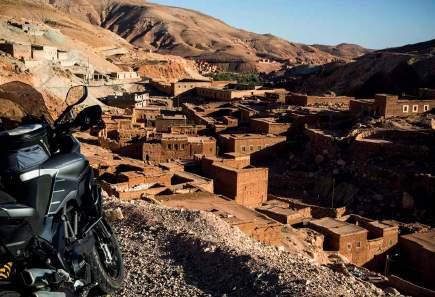


Country name: Morocco
Capital: Rabat
Language: Arabic, French (second language for many)
Currency: Moroccan Dirham
Road Length: ~60,000 km
Flag:

Roadtrip name: Multistrading in Morocco
Distance: ~3,000 km
Route: Ceuta, Spain > crossed over to Tetouan, Morocco > Chefchaouen > Ouezzane > Moulay Bousselham > Rabat > Casablanca > Marrakech > Ouarzazate > Tinerhir > Erfoud > Midelt > Fes > Ouezzane > Chefchaouen > Tetouan > crossed over to Ceuta, Spain

Ride on: Right side
Metric System: Speed is in KM/H and temperature in Degree Celsius. Fuel or gasoline is measured in litres
Best Weather: Spring (mid-March to May) or Autumn (September to October)
Machine: Ducati Multistrada: 1198.4cc | 150 bhp | 119 Nm | 220 kg (kerb)
Left main: Riding in Morocco with a group was a surreal experience. Doing it solo would be heavenly. Top: Often hamlets and villages camouflage into the landscape. Middle: Morocco can be a very colorful country too,. Above: Sometimes the only roads you will see re made by the tyre tracks of previous vehicles, but this is when you are looking for adventure. The road quality is mostly good.
to Europe and the unique riding experience it provides. A lot of touring companies frequently arrange rides to Morocco. And so, big bikes are a common sight. They still turn quite a few heads though.
Marrakech is a bustling town with a must-visit medina (UNESCO World Heritage Center) and some other surprises like a restaurant where a James Bond movie was shot. It is the fourth largest city and is the capital of the mid-southwestern economic region. From the central square of Djemma El-Fna to the El Badi Palace, and the busy souks or bazaars, this city is a sociocultural hub and the ideal place for shopping!
The Atlas Mountains, forming a dividing line to the Sahara, are almost uninhabited. The mountain roads are a pleasure to ride on and provide some great views of natural beauty. One may find roadside stalls selling artefacts made of salt and natural rocks. It also has several traditional Berber villages for those looking for a more cultural experience. Another must-visit for motorcyclists is the Dades Valley or the Dadès Gorges which has some of the most

incredible rock formations.
Ouarzazate, nicknamed as ‘the Door of the Desert’ is at an elevation of 1,160 metres and located in the middle of a bare plateau, south of the Atlas Mountains. To the south of the town is the desert. Ouarzazi Wood is the nickname given to the Atlas Studios here, one of the largest in the world. Films like Lawrence of Arabia (1962), The Last Temptation of Christ (1988), The Mummy (1999), and The Gladiator (2000) were shot here.
The final leg of the trip saw us riding into Erfoud, known as the ‘Gate of Sahara Desert’. The dunes of Erg Chebbi, which have characteristic orange-coloured sand, can be accessed from here relatively easily. One can hire ATVs, 4x4s, and motocross bikes here to ride in the sand. Or, if you have a motorcycle that you feel can take the heat, you can try that too. We did. The Multistrada can take the heat… to some extent.
From here, we went to Fes which is the third-largest city in Morocco. It has two medinas, the larger of which, Fes el Bali, is listed as a UNESCO World Heritage Site and is believed to be one of the largest u



Top: Beautiful carpets can be bought from most cities. Some have amazing showrooms. Middle: Nothing to see, just a big apple in the middle of nowhere. Bottom: Fes has colorful buildings that can be quite charming.

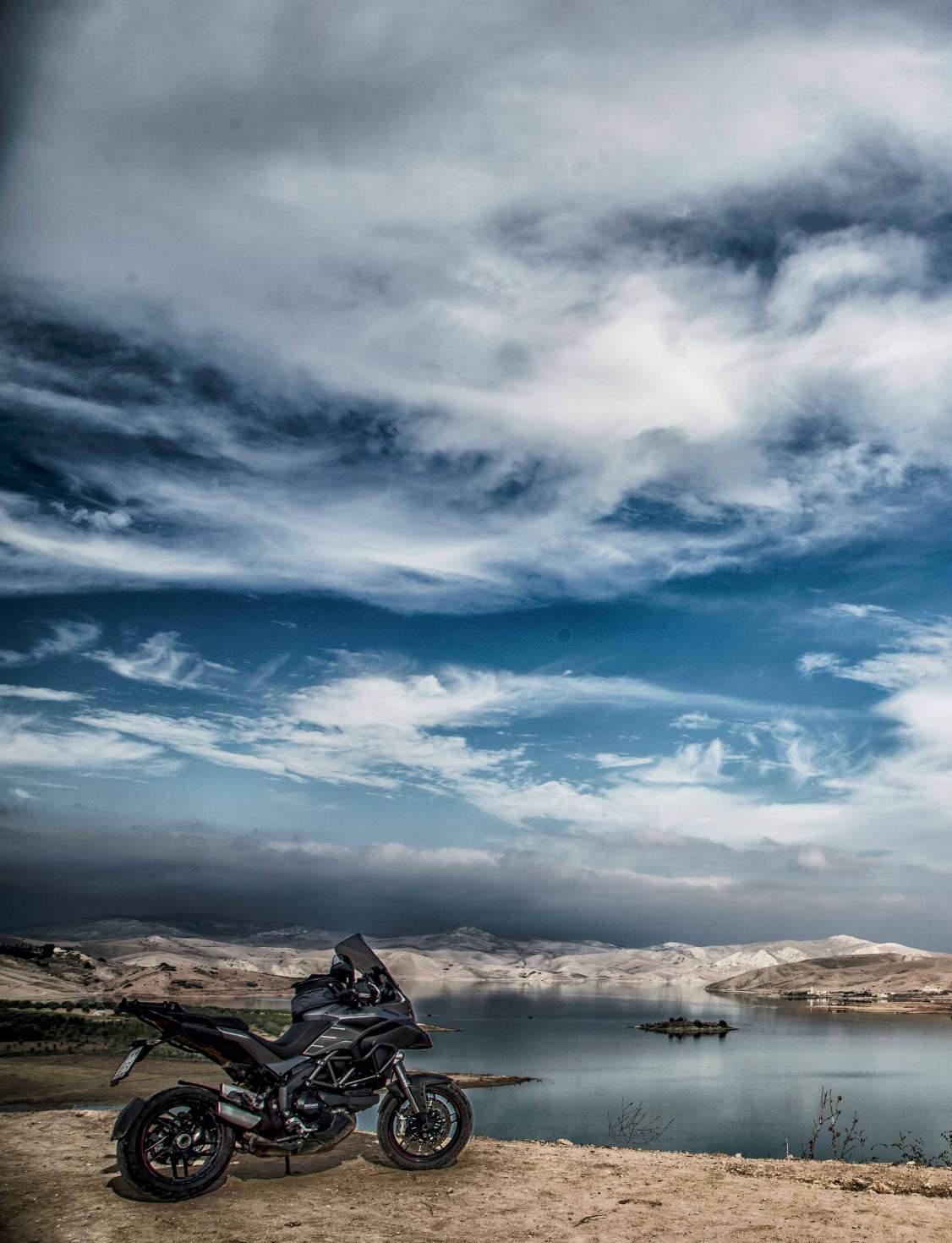
car-free urban areas. Al-Qarawiyyin, founded in AD 859, is considered to be the oldest continuously functioning ‘madrasa’ in the world. The city of Fes has been called the ‘Mecca of the West’, and the ‘Athens of Africa’.
The roads are generally well-kept although one should be on the lookout for the odd few missing drain covers and the animal traffic (including strays as well as horse/donkey carts). Morocco has a good motorway network with an extensive system of toll roads on a pay-per-use basis which is quite inexpensive.
You ride on the right side of the road and the legal driving age is 18 although hire car companies generally expect you to be 25 and with at least two years of driving experience. Speed limits are pretty lenient on mountain roads and highways, however, there are a lot of speed traps and police near and in big cities.
The traffic can be slow, and roads are prone to jams in the cities. The Moroccans do enjoy a good honking symphony and almost use it to communicate with fellow drivers. It can be a mere greeting, a show of gratitude for letting them pass, or just the substitute for cussing. While they mostly follow the road etiquette, you should be cautious in your own regard as some of them, especially the taxi drivers, can be particularly brash when it comes to road regulations. You may have problems with people driving in the middle of the road and the bigger cars refusing to give way.
There are also a number of police checkpoints and when someone flashes their lights at you, you should slow down as it usually means there’s one up ahead. Do not worry as long as you’re following the traffic rules, since they’re not usually after the tourists. When it comes to parking, ensure that it is secure. There are designated parking lots with an attendant, and they charge you only a few dirhams. Parking is not allowed at kerbsides painted in red-and-white stripes. The parking attendants also have the authority to ticket illegally parked vehicles and have them towed away.
Fuel is mostly of good quality (from our first-hand experience, since the Ducati MTS didn’t have any issues).
Most of the places you will find 95 Octane as well. The country is welldotted with petrol stations and in most of the towns, you’ll find garages with good mechanics as well.
You will also be quite surprised to find a number of Mercedes cars on the roads.
Coming to accommodation, Morocco offers conventional hotels which are cheap and quite easy to find and are of two types - classified and unclassified. The former is your typical western-style hotels found abundantly in the more urban areas. The latter, in the older part of the cities, are the cheaper options. They’re usually centrally located although you may have a problem with some modern amenities which the classified hotels offer.
There are also Riads (called Maison u


Morocco is a country of contrasting colors and rich traditions. On a motorcycle you can truly experience the vastness of its landscapes. And as everywhere, people will be more warm to you if you are a two wheeler. Just make sure you take permission before clicking any person’s photo.


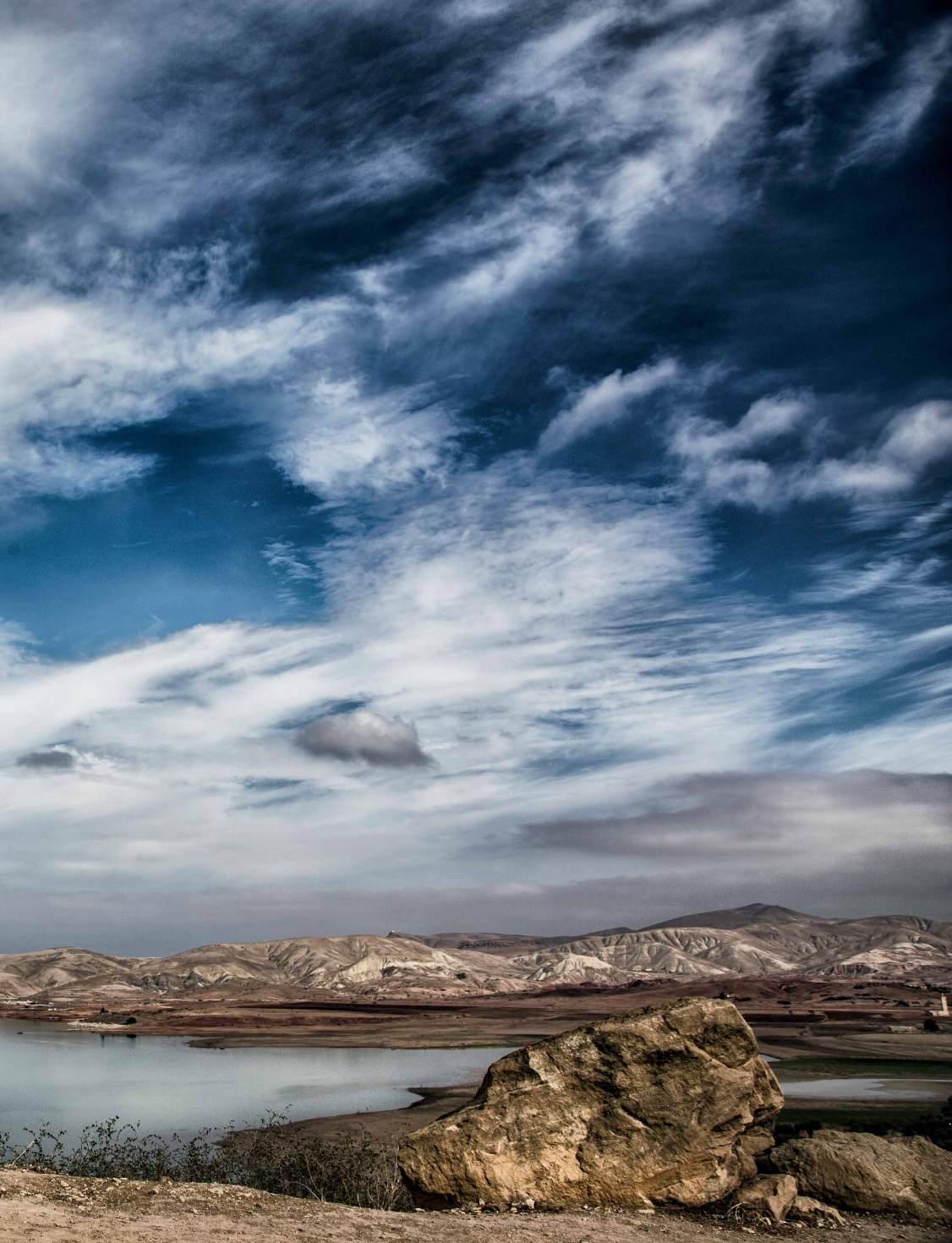
The Multistrada is a unique motorcycle. The 2013 Multistrada 1200 was powered by the 1198 Superbike Testastretta engine, with a revised valve overlap angle of 11 degrees (from the original 41 degrees in the superbike engine). It produced a massive 150 bhp of power and 119 Nm of torque.
Electronics include Traction Control and ride-by-wire but perhaps the niftiest feature (back in 2013) was the ability to change the character of the bike on the fly by simply pressing a button, even while riding. The four modes, listed below, change the Power and torque delivery, suspension settings (in case of the 1200S), and traction control.
Fitted as standard equipment on all versions, the electronic ride-by-wire system administers three different engine mappings to change the character of the engine, while Ducati Traction Control (DTC) uses eight levels of system interaction to enhance control. For the ’S’ version, Ducati Electronic Suspension (DES) instantly configures the suspension setup.
Just to understand how advanced the modes are, in comparison, the Suzuki Drive Mode Selector System (S-DMS) of that time had three modes, which the rider can select, but it stops at changing the engine mappings. The Ducati system actually transformed multiple characteristics that helped it achieve different personalities.
Maneuvering the MTS was easier than expected. The turning radius was surprisingly small, but the height of the motorcycle could be a factor that can cause trouble for the

ones who aren’t very gifted vertically. But the weight made things easier. It looked massive but weighed a mere 189 kg… it was a marvel.
That also provides the motorcycle with an awesome power-to-weight ratio, making the bike a nimble one. It can deal with corners with almost superbike-like confidence. There’s not a lot to complain when it comes to the Multistrada 1200. Whole lot of grunt, amazing road mannerisms, comfortable ride, and the ability to deal with light offroading.
Morocco was an amazing road trip, but quite a bit of it can be attributed to the Multistrada as well, which lived up to the faith of the Bologna brand which went so far as to name it ManyRoads.

d’hôte) which are slight variations of a guesthouse type of stay and seem to be the more popular choice. They’re usually Medina townhouses, bought and redecorated by Europeans or the richer Moroccans. Riads can actually be more expensive than hotels but, in most cases, much classier as well.
Other than these, you have hostels, and if you’re feeling particularly hippie, you can also opt for desert/nomadic camps. They do lack a bit on the facilities front but make up for it on the adventure one. Another cool feature of the Moroccan lifestyle is the number of hammams which are steam baths and the Turkish equivalent of a spa. You will likely need to be led to one since they’re difficult to find as they are unmarked. But once you do, beware you may not feel like stepping out at all!
Moroccan meals begin with at least seven cooked vegetable salads to scoop up with bread. The cuisine has some unmissable gems like couscous, tagine (vegetable and meat stew), B’sarra (rich broad bean soup), harira (a lentil soup, usually used to break the fast at sunset each day during Ramadan), and Makouda (deep-fried potato balls).
You will face no shortage of street food either which ranges from kebabs, calamari and grilled sardines to the more unusual stuff like snails cooked in a spicy broth. So, when you’re going for that authentic Moroccan experience, you know what to order off the menu. One thing to keep in mind is that most of the Moroccan food is entirely eaten by hand (the right one). Instead of using a spoon or a fork, Moroccans use a slice of bread instead.
Moroccans, like their food, are warm and comforting, and smell of hospitality. You are likely to come across two
different kinds of Moroccans - those who tend to live in the past and those who are a lot more progressive. Regardless, most of the people you come across, although they may seem unapproachable at first, will end up inviting you to their house for a home-cooked meal within one genuine conversation.
Moroccans comprise of two main ethnic groups - the Arabs, and the Berbers. As a result, while Arabic is the primary language, Berber is also still in use especially in the deeper parts of the mountains. They also speak French and English. On the whole, you shouldn’t have too much trouble going around with just English, although it would be advisable to learn a few basic phrases in Arabic and French.
As an added bonus, you may want to plan your trips around certain festivals like the Moulay Idriss Festival, the Festival of World Sacred Music in Fez, and the Timitar Music Festival.
For our ride, we relied on Edelweiss, a motorcycling touring company based out of Austria but operating tours across the world. In these tours, a bunch of riders explore the country together as a group, with a tailing van which carries the suitcases and spares. The trip was meticulously planned, and everything was taken care of. More than anything, it covered all the important points and made sure that the entire Moroccan experience was served to us on a two-wheeled platter.
For first time riders who have just begun their road-tripping journey, Edelweiss provides a fantastic opportunity to experience the freedom and thrill of exploring a country by means of a motorcycle while also giving one the comfort of a riding community.


Above: Shops like these seem like you are walking into a fantasy movie where you could find Aladdin’s lamp.
Nelow: Camel rides at sunset can be a great way to explore the sand dunes, even though I just posed!

v The best bet would be to hire a bike in Spain and ride to Algeciras port and take a ferry to Ceuta on the African mainland. Ceuta is a Spanish enclave in Morocco. The ferry is an hour or so.
v Stay overnight in Ceuta, and the next morning, go to the MoroccoCeuta (Spain) border that is around 5 km and then hope for the best. They tie your passport to the registration of your bike and give you a unique entry number and some papers. It is like marrying the bike. If you lose the papers then you will have the toughest time leaving the country.
v Once you enter Morocco, it’s relatively smooth sailing. People have much better etiquette on the road; however, they are not as clinical as in most European countries.
v Do not take photos of women, especially in Kasbahs. Don’t even point a camera at them.
v Do not go without a map. People understand French, but do take a translator on your phone or a small pocketbook. You will also find ATMs in all the big and small towns. Not all places accept cards. Also take Euros from Spain and exchange them at a bank or currency exchange in Morocco.



Getting into Adventure riding was always going to happen. As I child I spent my time herniating tyre tubes and fracturing push bike frames, riding through the bush, and ramp-jumped everything in sight. All the while pretending I was on a motorcycle.
In my late 20s, I saw a couple on a big BMW GS riding off and I felt a huge pang. I was in awe, but life was not going in that direction. At the age of 38, I had an opportunity to get my motorcycle license. It was the seed of a whole new life. The day I turned 40 I sent off my application to join Ulysses. It was soon clear that motorcycling, Ulysses, and travel were a big part of my soul. A year later riding across the Nullarbor on my own.
Watching Ewan McGregor and Charlie Boorman’s stories re-lit an inner ache to get adventurous eventually becoming too strong to ignore. Finally at the age of 53 despite all my old injuries, aches, and advice against it, I decided if I died one
of my regrets would be that I never tried adventure riding. The urge to go and experience places more remote and challenge me and my bike was too strong. It was time to get serious.
It wasn’t a straightforward transition. In the beginning, I hurt myself when I rode ill-prepared into a sandy patch. I continued riding 1800km for 3 days with a painful injury that took 6 months to recover. My bike and riding gear were inappropriate for adventure, I needed to make significant changes. About 6 months later after finding a potential bike, my mate Brian Lacey came along with me to test ride a 2021 BMW F750GS. Its specifications suited my 168cm height, Brian confirmed it was a good ergonomic fit and mechanically sound. Initially, I thought getting the new bike would automatically make adventure riding easier. I was so wrong. As soon as I got onto the gravel and anything resembling a grain of sand set off
flashbacks, I was way out of my comfort zone. I lost my confidence to the point I was feeling sick and fighting back tears. It was a different bike from what I was used to, and with strong memories of injury, I was scared.
Over the next few months, I reviewed what was making me uncomfortable. I was leaning too far forward so risers were added. Whilst standing on the pegs, reaching the foot brake was impossible so a small metal step was welded to the pedal and changed the road-style pegs to a gripper pivot pair. An assessment of tires had me change from road-biased adventure tires to a more off-road combination such as the Pirelli Scorpion STRs or a combo of TCK 80 front and TCK 70 Rocks rear. I bought adventure boots to protect me from further injuring my ankles. My road helmet felt suffocating. It was heavy, didn’t have the field of vision I needed, and it would heat up as I worked hard at slow speeds, so I went for a
It doesn’t happen overnight, but it can happen.

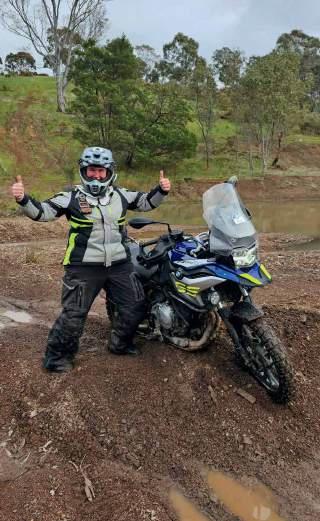
lightweight adventure helmet. It took over 6 months to find what suited me, but I purchased good-fitting riding pants with knee pads and a quality jacket that was unrestrictive.
An important factor was practice, practice, practice. Adventure is not only muscle memory but incredibly psychological; my mental attitude was inhibiting. Again, my mate Brian (a very, very patient man) stepped in. As we rode, with a good comms system, he was able to talk me through my fears, explaining and demonstrating how and why to manage situations. Careful to find the balance to push me when needed but not get me into something I was not ready for. It was all about confidence building. Did I mention practice, practice, practice?
Early on I was still struggling with fear, so I found a dirt road near home. Every few days, I’d head out for 20 minutes. Brian had said to learn to dance with the bike. At this point, when going over a

Left: The Barry Way in southern NSW. Above: I looove my bike. A loving moment in the Flinders ranges.
Bottom left: I bottomed it out over a stony hump, at Broadford, while doing the GS Expert course. The bike was standing up all by itself
stone, I’d panic and stiffen up. To change my inner voice, I would ride, talking out loud, telling myself the bike moving about is what I want, just let it move. I’d even sing it to convince my mind it was fun not something to fear and try to relax my muscles. Initially, I’d stick to the car wheel marks, then move from side to side over the stony middle section, to finally keep the bike on the loose stones in the middle.
Then one day, Brian found a long thick patch of large railway ballast and had me riding over that. It all started to come together, my confidence in the bike, myself, and the dance I now call the Tango. Next, he had me crossing a stony river. First stalling, getting my feet wet, but stubborn determination had me riding it back and forth without putting my foot down. The inner child’s voice was saying “I- can-do-it!”
I need goals. Dangling a carrot, we decided to plan 10 days in the Flinders Ranges. It was going to be a do-or-die trip. Needing to ramp up my training, I booked into the BMW GS Offroad Training course at the Broadford Motorcycle Centre.
What a good decision. It was a 2-day course designed to get the basics right.
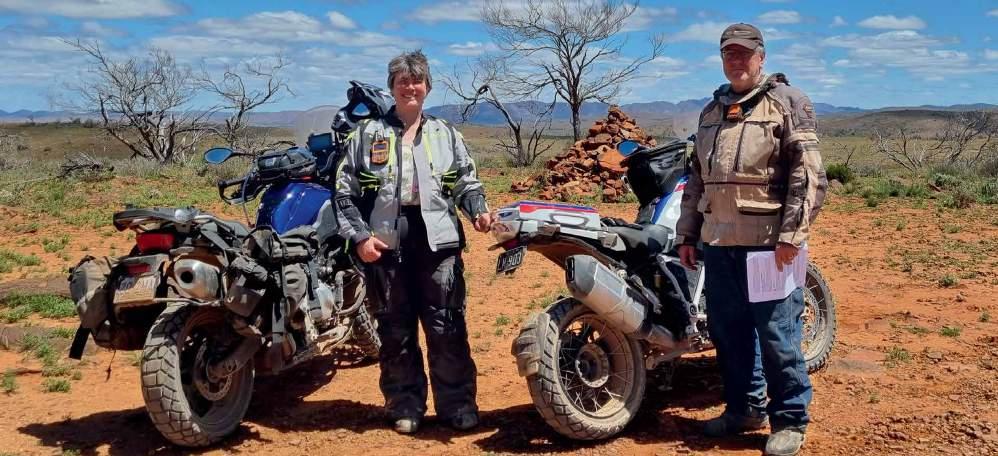
Courses cram a lot of skills into 2 days but the GS one continually emphasized the true basics of balance and posture. Covering skills such as bike position, breaking, slow riding, tight turning, hill riding, different terrain, etc… I was certainly challenged but the support from Miles Davis, Craig Bernard, and Shaun (Turbo) Terblanche made the tasks doable. You can’t become proficient over two days, but the information and feedback gave me the skills to go home and yes, practice, practice, practice. The best way to describe what it did for me, was as I rode home, I realised the bike felt smaller and lighter.
Back at home, I found a variety of tracks to train on and practiced pushing my bike around the garage to keep the bike from feeling heavy again and build on the skills taught.
I am happy to report the Flinders Ranges trip was a do-rather-than-die experience. Fate on arrival made conditions difficult for big adventure bikes not to get bogged so the manager of the station we stayed at offered us his AG bikes until the ground dried a bit. Instead of learning to ride the rough conditions on the big GS, I had a lighter bike. Within 5 mins I dropped the thing on the side of a stony hill, it didn’t hurt. I learned dropping the bike didn’t always mean injury. Over the next 2 days, I was throwing that thing over a variety of situations including soft, hard, and rocky, and the steepest of tracks, dancing the tango without fear. Those AG bikes just
keep going no matter what you ask them.
Back on the GS for the remaining 8 days, I rode over every type of gravel, rocky, and stony 4 WD drive-only roads, and riverbeds the Flinders Ranges had on offer, with only one small section of a sandy riverbed. The level of difficulty built each day until we finished off by riding
Above: Flinders Ranges Skytrek track
Below: My second river crossing. Glenelg River at Harrow. I stalled halfway first time. Riding away after failure was not an option, so rode successfully through it twice before leaving.
Top right: My bike decided it needed a nap near Silverton.

the 80km unlocked section of the Skytrek track on the Willow Springs Station. There was no section to just sit back and ride, you had to constantly think about what you were doing. It was thrilling with scenery to match. It is worth a Google to find some YouTube videos of this track; it is quite spectacular.
For inspiration and to gain skills in managing heavy adventure bikes, with a small stature, I watched you tubes by Jocelyn Snow and Kandi Spangler, both short women who have competed internationally and provided training on R1250 GS bikes. All of this came in handy as I needed to borrow a R1250GS over two weekends and I found the bike despite its height a total delight to manage.
My confidence and skills continued to improve, travelling around the Grampians, and on Gippsland’s Grand Ridge Rd, Barry Way, and Mckillops Bridge. In NSW travelling the Bridle Track, and Old Grafton/Glen Innes Road.
The time had come to up the ante and book into the BMW GS Offroad Expert Course. The preparation had me regularly down the local footy ground car park practising slow riding and tight turning. Taking videos with my phone, trying to lean and lock the handlebars more and more. Gawd, my muscles hated me, and my physio and masseuse loved my wallet. Courses are not cheap so I like to practice the basics beforehand to get to the level I can achieve myself. This is so I can concentrate, under the guidance of the teachers, on fine-tuning those
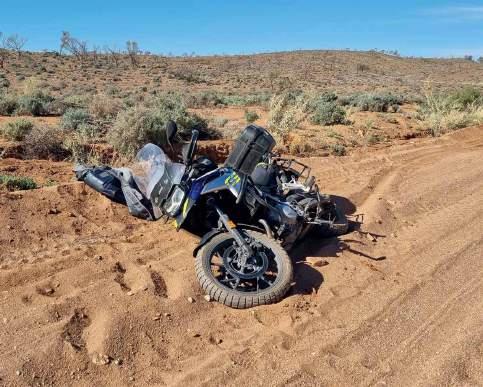
skills and learning new ones, making the most out of my time at the course.
It was a blast, starting again with the basics of posture. The group then was challenged to a slow-riding race. The practice I had done paid off, guess who won all the rounds? After that the real work began, riding around the complex up mounds, tight turning in-between trees and buildings all on uneven ground, breaking, riding sloppy, muddy, wet thick grassed steep hills. New skills for me were power slides, riding over logs, and following through water-filled creeks, slow riding along the side of steep grassy/rocky hills and mounds instead of riding up and down them. I can’t forget to mention Miles’s favourite skill to teach is the “brruuuppp”, the quick twist and release of the throttle. Some of the steep and high obstacles that I had seen other more experienced riders tackle last year when I was there, suddenly seemed small, achievable, and fun. Last year, I thought I would never be able to do that.


My advice to anyone undertaking any adventure course that is 2 days or more is to pace yourself, rest, and eat well. It is exhausting both physically and mentally. I was not in the best health and fatigued greatly on the second day, I started dropping the bike in places I would not have the day before and didn’t get my full potential out of it. In the afternoon needing to pick and choose what I did and what I just watched and listened to. I do intend to return. One guy on our first day had completed the basic 2-day course going straight into this course, he left after lunch as it was pushing beyond his limits. In saying that, one other guy we nicknamed “Ironman”, booked back-to-back both courses and on his fourth day completed a challenge that only Miles and Turbo would try. He then rode for 4 hours home. We are all different, be aware of your level of fitness, capabilities, which can change with conditions, and know when to take it easy or stop for the day.
Am I there yet? Am I an accomplished expert adventure rider? No way, not even close! Like most things in life, as you achieve goals and realize you still have lots to learn. Next is, yes, more practice, practice, practice of what I just learned. Sand riding, which creates nausea and tears just thinking about it, is the next nemesis to overcome. Wish me luck.
If you have that niggle for adventure, I can recommend it. You will get out of it whatever you put in.

GRIP IT AND RIP IT WITH BARKBUSTERS NEW OPEN-END GRIPS @BARKBUSTERSHANDGUARDS Created using a
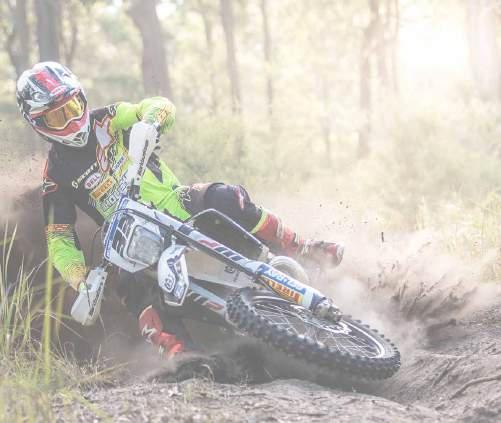
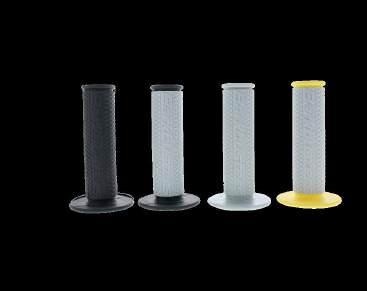
üCompatible with Barkbusters products


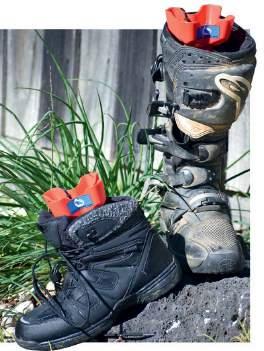
Adjust to dry all types of boots & shoes l Portable usage anywhere USB powered efficient



rider training experience
“Plenty of trail time with track side tips and techniques”. (Ducati Aus/NZ – Nick Selleck)

It’s mid-May 2023, my mobile rings “Hey Aron … its Nick .. Nick Selleck … so tell me what do you want to get from the DRE this weekend? ….” Holy crap! Lock that phone call away into the memory bank! To me this phone call was something special, but in reality it was Nick doing what he does. For those of you that don’t know, Nick Selleck runs Maschine with his wife Trudie. Maschine is an adventure rider training and tour company based in port Macquarie NSW. I first met Nick on the Ducati Adventure tour back in 2019. Move on 4 years from DAT # 1 and Ducati is strengthening their position in the adventure bike market, the long term Multistrada range are evolving into distinct touring and adventure models, the
popular scrambler range keeps its Desert Sled, and Ducati brings two new “adventure” bikes to the market, the long-awaited Desert X and the V4 Multistrada “Rally”. Ducati has backed up its adventure bike range and taken Nick Selleck into their fold for product development and rider training. The “Ducati Rider Experience” aka DRE being one of the offerings from Ducati, run in conjunction with Maschine. Nick’s official role with Ducati is “product genius”, whilst this may be a catchy role title coined by marketing and HR, it loosely translates to someone who “knows their s#*t”. Speaking of those that know their ... Nick was joined by Paul Bray of Safe2Ride for the DRE that I attended in the Hunter Valley of NSW.
u

Come Saturday prior to the DRE and I’m up early to head to the Hunter Valley. Usually a left turn and 1.5 hours would see me in the excellent riding areas of the Southern Highlands or South Coast of NSW. However I turn right and 1.5 hours later I’m only in Berowra. God bless metro Sydney roads and traffic. Up the old Pac and George downs drive to Jerrys café for a coffee and the start of my personal DRE experience.
Into the Watagan State Forest via Walkers Ridge Rd, a few k’s in and a left turn onto Murry’s Run Rd. Murrays Run Rd provides a good side detour to the Great North Rd. Unfortunately the tar seal is in a horrid state. When it eventually gets to dirt it’s an enjoyable but short stint before heading back onto the Great North Road at Laguna. A short tar run then left turn onto Yango Creek Rd and follow it right (at
Upper Yango Creek Rd) towards Wollombi.
OK these are NOT “adventure” roads. All are gravel back roads perfectly suited to introduce those new to adventure riding and I’ll definitely lock them way for later. There’s nothing overly difficult about my morning route, however it gets me to Wollombi Tavern sans the boy racers and police presence that comes with them on the Great North Rd. The end of my day one ride from Wollombi to Voco is easy, with some dirt thrown in via Mt View Rd, nothing overly stressful.
Upon arrival at Voco, first thoughts, this
Above: The Old Pac at Brooklyn - Morning sunlight across the Hawkesbury attempting to warm the day.
is definitely an event by a premium brand at a venue that reflects that. I park my trusty steed pride of place near the Ducati banner and stroll into main reception, ADV gear, dirty boots, Beatnik top and cap, dusty face with a grin from ear to ear. “Hello sir, you must be here for the Ducati event” … wonder what gave it away?
Early morning on the official first day of the DRE and a meet up at the big red tent for the obligatory signing of various waivers, one of which I’m sure had in its fine print the signing away of your 1st born male child to the Bologna based Ducaisti. And then we’re into it …. The classroom that is!
The DRE wasn’t just about getting onto a bike and doing “whatever”. Nick’s phone call to myself (and others) was about seeing what “we” as owners of Ducati adventure bikes wanted. There was
Below: NPWS headquarters at Bucketty and the start of some dirt in the Watagan State Forest for my first day of the DRE. u
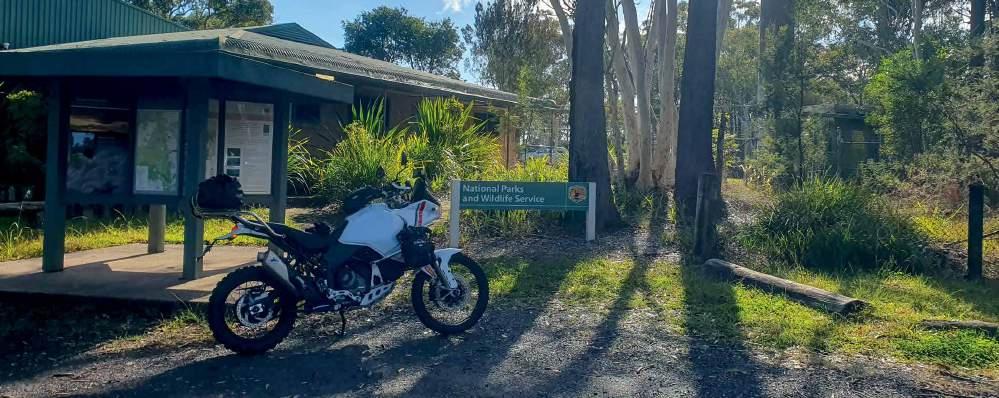
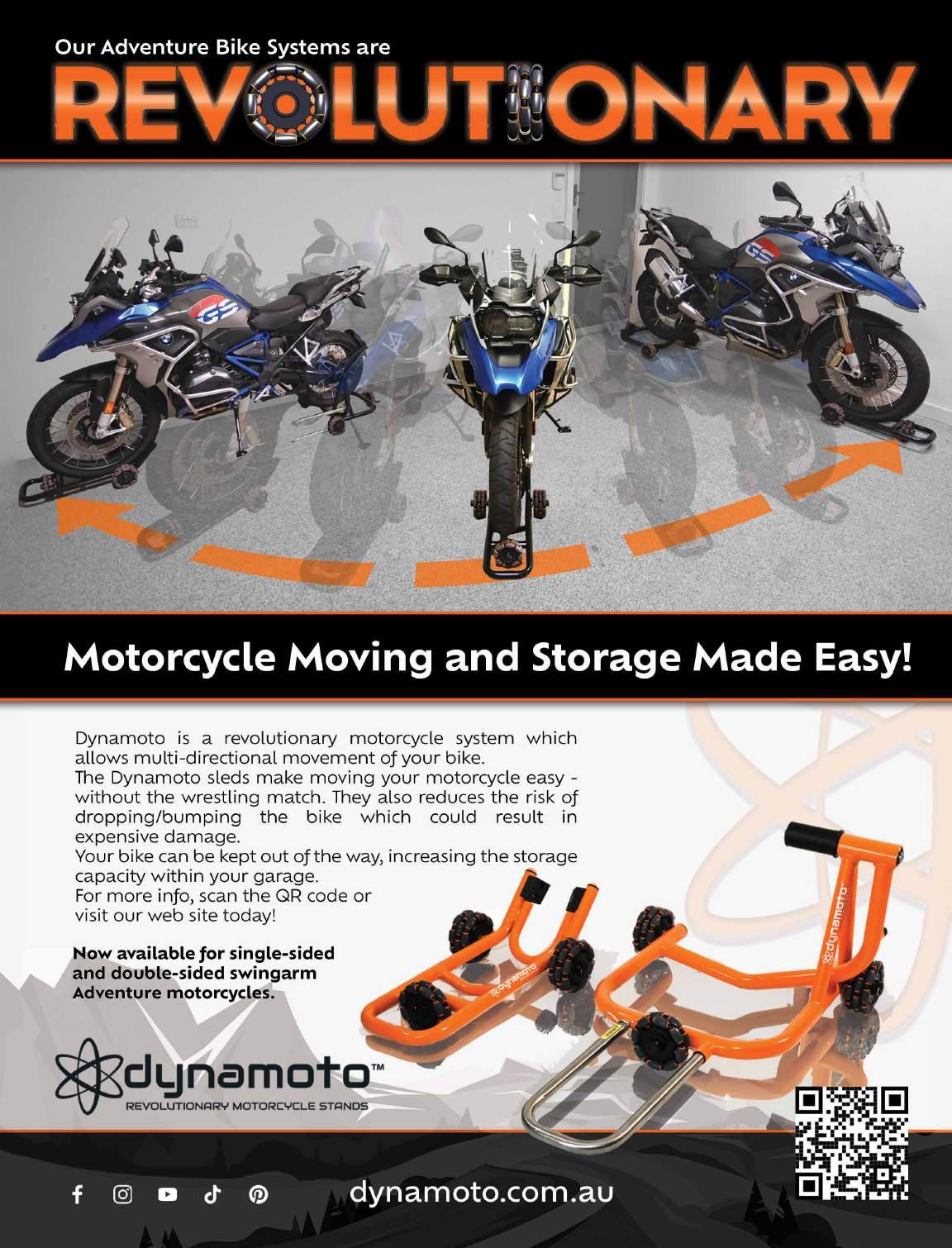

Above: Yango Creek Rd.
Top right: Early Mornings at the Hunter have an element of mystery about them. Like where can I get fuel at 5am, and did my open Termi wake up anyone?
Below: Whomever convinced Voco that letting us gentleman scholars “let rip” on their back paddock was a good idea, deserves a promotion.

the obligatory meet and tell us about yourself. Very evident during this was the undeniable experience of both Nick and Paul.
The wealth of knowledge of Nick and Paul is almost beyond comprehension and whilst Nick may hold the official title of “product genius” they could both hold PHDs in “ADVology”. Over the two days of the DRE they shared their knowledge n a way that helped all riders to obtain skills and “Trail Tools”. Some showed advanced learning immediately. For the rest of us mere mortals the split was probably 50/50 “road based background coming to dirt” versus “MX as a kid”. All of us wanting to get better as “falling off hurts”. The overarching theme wanting more experience so as to not “soil ones pants” whilst off-road.
As the training evolved it became apparent that Nick and Paul listened very
carefully to what was said in the meet and greet what “we wanted” from the DRE. This wasn’t the average ok now we do this and then onto that training “schedule”. As owners of the Ducati product we were getting targeted training focussed around the bikes we owned.
Nick and Paul showed the key facets of adventure riding, heads up, look forward, the importance of body position, weighting and unweighting of pegs, clutch and throttle balance to improve slow speed controlled approach to obstacles and manoeuvring, feet up u-turns, controlled yet “aggressive” braking (ok maybe less than controlled braking at times), how to pick up a 220kg + adventure bike when dropped (intentionally demonstrated or otherwise). During breaks between techniques, Nick and Paul didn’t stop they’d individually come to us, review our ride position,

give a quick tip, look at our controls and ergonomics and tweaked either ourselves or our set up to improve our experience. We were all learning or improving and doing so in a safe, effective and evolving manner. Nothing felt forced or out of place. I can honestly say that Nick and Paul seemed to be getting as much of a buzz from seeing us improve our ability
techniques, and I’m sure they caught me doing the same.
Segments also focussed on the rider aides the new range of Ducati ADV bikes have. The time spent regarding ride modes, the effects of (subtle and not so subtle) was invaluable. In real world situations on-the-trail, the various modes are significantly different even if the
as we did by improving.
The DRE wasn’t only about improving our technical or trail skills, time was put into exploring wider aspects of adventure riding often overlooked, for example the need for appropriate warm up or stretching pre ride. Personally I’ve never done this. Did I possibly feel “a bit silly” about doing this? Initially yes. Will I do it in the future? ABSOLUTELY. What was interesting as the day and training went on was that I caught glimpses of my fellow “classmates” having a quick stretch or limber up between practicing our
changes (as displayed by numbers on a screen) seem subtle. Modern adventure bikes and modern rider aides have come a very long way. The old adage of “turn off ABS and traction control on dirt” is clearly not the case anymore. Hard to explain in words, visual real world demonstration is the best way to comprehend. The impact of what seems to be minor changes was significant, something those of us on the DRE got to witness and experience. Suffice to say if you have a modern ADV bike with multiple ride modes go get some training, or go have a play in a safe place




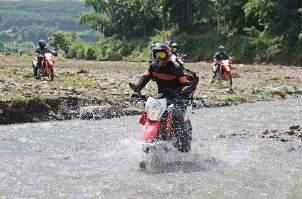

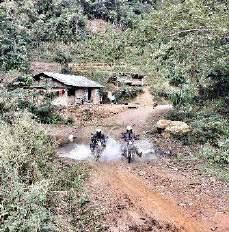



on a favourite trail and see how the bike behaves in the different settings. Nope, I rescind that go get the training!
Day 2 sees the group ready to put our newfound skills to the test. A quick refresh of techniques as a warm up including stretching has us ready to hit the road – figuratively of course. For those of us with a GPS Nick uploaded a GPX file of the planned route and we were ready to go.
Nick had set out a testing but not overly so route. A loop around Voco sees us onto Broken back trail & Cedar Creek Rd to Wollombi then Laguna for lunch. The afternoon sees the “trail tools” really put to the test in Yango NP and ultimately Howes Trail.
Nick and Paul gave all riders 1 on 1 trail time, watched our riding and gave feedback and tips to enhance our application of the first days “theory” and “controlled” learning/practical sessions. Thinking I’m doing ok and leading the pack I hear the boom of a derestricted Termignoni. Out my right ear, flying past comes the modern day equivalent of storm trooper pointing at their bum and going right with exaggerated arse out left, going left with exaggerated arse out right. Once I got over the initial amusement of this sight I realised it was Nick visually showing me more outer peg weighting and to be more active with my body positioning. Promptly kicking it down a gear said storm trooper disappears

Top left: From the classroom sessions to demonstrations nothing felt forced or out of place. Nick and Paul seemed to be getting as much of a buzz from seeing us improve our ability as we did by improving! (Ducati Aus/ NZ - Damien Ashenhurst)
Above: Does this make me a “certified” adventure rider? Wonder if this counts toward continued professional development?
Top right: This wasn’t the average ‘ok now we do this and then onto that training schedule’. As owners of the Ducati product we were getting targeted training focussed around the bikes we owned!
Below: The imposing clouds held off their rain and a fantastic day 2 of DRE out on the trail was had by all. (Ducati Aus/NZ – Nick Selleck)


off uphill on the rear wheel, leaving me a mere mortal amongst the gods.
As day two progressed so did the “eagerness” of the group. Gradient humps became mini jumps and the “whoop” “scrape” soundtrack became a familiar one as those on the Desert X started to explore the stock suspension limitations, some more so than others. If you weren’t having fun at this point then time to go back to your Dr and review your prescription.
That said I’d like to take a moment and give a shout out to Paul for the guidance when what I consider to be a “snotty downhill” took me back to bad habits. As if almost by divine intervention I got some personalised tutorial time whilst on the bike (and in motion), regarding “how to not s#*t oneself”. More accurately, body position, effective trail braking, looking forward not at the obstacle, when to dab the brake (rear) and when to let off and have momentum carry you around the corner by changing your peg weighting and body position. Won’t say I’ll be “attacking” such hills in the future, but I won’t be petrified of them either.
In summing up my DRE, Voco was an excellent venue, definitely up to the standard one expects from a premium brand such as Ducati. The fact Ducati Aus/NZ or Maschine or whomever was able to convince Voco that having a group of gentleman scholars tear up their grass and a back paddock was a good idea deserves a promotion. The food as provided was fantastic. Yes memories of this part of the experience locked away. However the greatest impression upon myself were the “trail tools” that I’ve now added to my tool kit.
Ducati Aus/NZ should be commended for putting on an event series such as DRE, and getting the expertise of individuals such as Nick and Paul was a very astute decision. If you have the opportunity to ride with either of them do not hesitate to take it up. The DRE is by far the best “accessory” for my Desert X I’ve ever bought and rider training should be in every modern ADV bike accessory catalogue as an option at time of sale.


It’s all
The boys were on their way to Phillip Island. They seem rather accident prone and JimBob has just been thrown off his bike by the ‘whack’ of a tree branch.
Words and images: Greg dunn

ou alright Jimbob?’ ‘
‘Yeah’, came the gritted response.
‘You sure?’ I ask again. ‘Yeah, but can you get this bike off me?’
I help Jimbob out from under the bike and we get the mighty DR upright. Now this is Jimbob’s first big ride and first stack to boot. It’s fair to say he’s a bit dishevelled at this point. Not hurt, but let’s say in a bit-of-a-spin. He gets the bike going and scoots off, I follow, he takes the right instead of the left fork which clearly has the tire tracks on it. I beep my horn and he turns around, then goes bush to find a tree to straighten his steering on.
I stop him in the middle of the road and say, ‘Settle down. Have a drink. We’ll go find the boys.’
We only got a few K’s down the road and Rush Rush and The KTM Kid came heading back our way. We stopped and gave Jimbob a minute to relax and chill out. The KTM Kid suggested, ‘Send that camping gear home and that bike will seem like a whole new bike.’
The Wee Jasper Road dropped us out at Tumut where we fuelled up and grabbed some lunch. Jimbob did a quick repack and sent home his camping equipment. 22kg off the back of his DR 650. Yep, like a whole new bike.
After lunch at Tumut, we headed for Gilmore with the plan of doing some exploring up through Bago State Forest towards Blowering Dam. We finally did
get to the dam, but only after being turned around several times and back tracking because there were gates locked on what were proper roads and tracks; that was annoying. We stopped up the top and took a few pictures of the view and Jimbob informed us the DR 650 performed so much better now with no weight on the back rack.
We rolled down the hill and made our way to Batlow for our nights’ accommodation, The Batlow Pub. As we rode around the back, the DR boys were just pulling up to the gate as well. Perfect timing. We parked up and chatted about our day. A new battery at Crookwell for the King got his DR running smooth again. Ozzie required some welding to his pannier racks. Then we told of Jimbob’s tree tackling skills. Good laughs were had, along with a beer or two. Then hot showers and a Carbonara that was top notch. We chatted to the publican about bikes and such but didn’t kick-on too late.
Tuesday morning we were all pretty chipper, we headed straight for the hills. Bargo Forest Way changed names several times and showed off beautiful views of
lovely green valleys, along with top riding. Onto Powerline Road which dropped us out on Elliot Way. We regrouped and everyone was smiling and laughing. We were going to do a bit of freestyling today because it was only a short day for us to get to Mitta Mitta and our nights’ accommodation. A right on to Elliot Way sent us to Tumbarumba where The KTM Kid and I grabbed a splash of fuel while our ‘walking GPS’ Rush Rush went over the map trying to find a loop to kill some time between here and Jingellic, our lunch stop. Rush Rush found us a loop just out of town on Mount Garland Trail. Following along we found ourselves on Watleela Road and back on the main drag to Jingellic. We still had time up our sleeve, so we took a left onto Munderoo-Ournie road and followed it all the way to the River Road.
The scenery along the way to the River Road was spectacular and I wanted to pull the camera out but pushed on. We regrouped at the start of the River Road and I said I was going to duck back up the road and snap a photo or two. When I arrived back at the turn the boys had

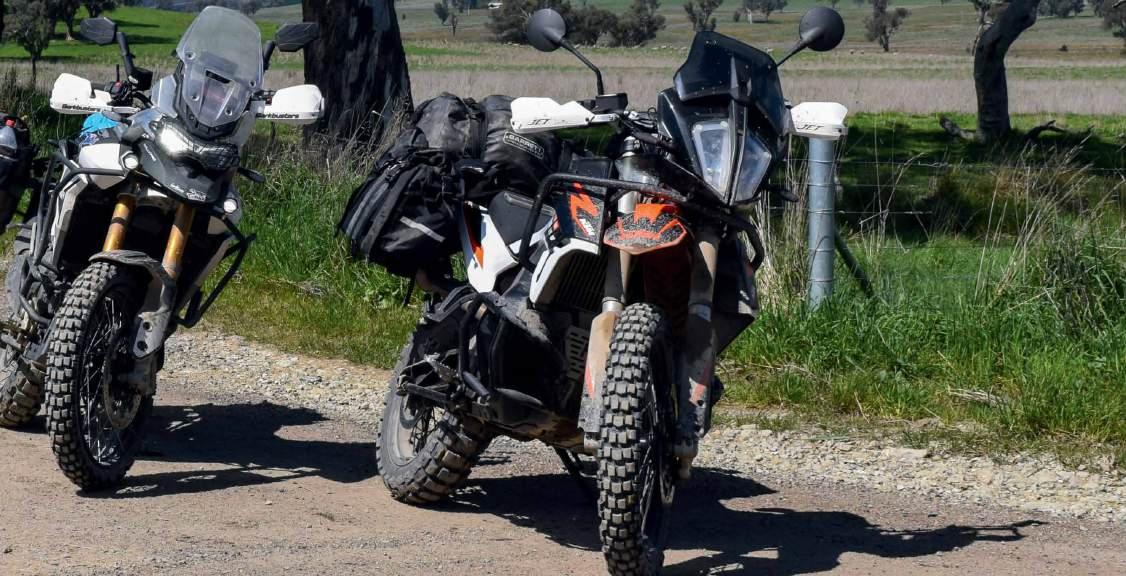
rolled on to Jingellic pub. So, I pinned the ears back and headed for the pub. That River Road is open, fast and so much fun. Burgers were the order of the day and I grabbed the last stubbie cooler off the shelf, much to Jimbob’s displeasure. It’s beautiful countryside and a beautiful place for a pub, but we can’t sit around drinking all day, after lunch we followed the River Road up to Wymah and caught the ferry across Lake Hume and into Victoria. It’s 60K’s to Wymah but it’s great fast riding with beautiful scenery and the ferry always reminds me of The Outlaw Josey Wales.
Off the ferry it was straight into Tallangatta for fuel. This is where Hodgey the 2nd noticed his rear tire had run out of air, or as Rush Rush put it, ‘That’s flat mate.’ A flat rear on the DR 650. But we were outside a tyre shop so it was a quick fix. We were back in action in around 20 minutes. Once on the road we just ran the tar to Mitta Mitta and enjoyed the beautiful views all the way in.
Mitta Mitta is a great place to stay, it backs onto the river and is a great place to enjoy an afternoon of bench racing. But it’s not all beer and scenic views when travelling, these bikes need some love too. Jimbob, The KTM Kid and I did our air pre-filters. I gave my 900 a look over, only to discover my tool tube had broken a bracket. Nothing a few zip ties wouldn’t hold till I got home. Jim also realised he’d lost a bolt from his luggage racks but luckily, he had spares. So, we settled in
for the evening all quite content and full of merriment.
Wednesday Moring was crisp again but clear. We went straight into the forest and over to Tawonga to get the heart rate up. More bloody great riding, more fantastic views, plus I did get the camera out along this stretch to snap a few pictures of the boys. Once at Tawonga we rode the tar, Tawonga Gap Road over
“ Watching Jimbob’s back wheel trying to overtake him at every opportunity in the slippery conditions was quite entertaining. ”
to Bright for fuel and breakfast, boy was it a great ride even on the knobbly tires. It could be said that some sports bikes were found wanting, as a couple of dust covered ADV bikes strolled past on off road tires, but I’m sure they don’t want their mates to know. Bright for fuel and a Guinness & Steak pie which I have to say, was bloody fantastic.
Straight out of Bright we rode along the Goldie Spur Track and then to the Rose River Road, and wow! Talk about views, Last time we rode this track it was
foggy, damp and you couldn’t really experience it. But this time the weather really turned it on for us. Clear skies with a few fluffy white clouds. I don’t want to repeat myself but, more great riding. I caught up to Jimbob who was almost stopped and asked if he was ok? He was fine just enjoying the view. We rode side by side at near walking pace talking and pointing at things. It really was a special moment in time. I did the same with Rush Rush, however we just stopped and stared out at the vista in front of us grinning like idiots as I snapped a few pictures. We spotted Jimbob working on the DR’s windshield at the bottom of Goldie Spur. More DR gremlins.
By the time we’d hit the turn off to Lake Cobbler, the weather had closed in on us, robbing us of the views and the dust. The DR boys continued along Rose River Road headed for Mansfield and our nights’ accommodation. While The KTM Kid, Jimbob, Rush Rush and I decided to head for Lake Cobbler Road with the aim of doing Speculation Road and Circuit Road which would eventually drop us onto Mt Buller Road and Mansfield. However, the gate at the top of Lake Cobbler Road was locked so we turned around and strolled back down the hill. Watching Jimbob’s back wheel trying to overtake him at every opportunity in the slippery conditions was quite entertaining. We made our way back to Rose River Road in what had now become heavy rain and white out fog.

Halfway down the hill we came up to a stationary Rush Rush with his hands held out offering a snake lolly for each of us. A nice little sugar hit. Further on our way back down the hill we caught up to The KTM Kid who’d pulled up on a bend, reminiscing about last time we were here, and I went off the edge. Luckily with no damage to me or my Tiger. Remember this turn Bones he asked while grinning at me.
Once back to Rose River Road we only had about a 90K run into Mansfield. We’re all big believers in riding at one’s own pace, regardless of what anyone else is doing. So, I rode back in with Jimbob while Rush Rush and The KTM Kid pushed on at a quicker pace. When we got to Mansfield, we were soaked through and I took us straight to the pub and met the DR boys. But The KTM Kid and Rush Rush had not appeared. I was just about to head back out when they pulled up asking if we had gotten fuel. I had to reply no, I’d broken our rule of always fuelling up in the arvo. And like the good blokes they are, they let me know about it. Mansfield for hot showers and a royal feed on Wednesday night.
Thursday It was predicted to bucket down. When we woke it was already raining, and roads were being closed. It was pretty wild weather, so we planned to just jump on the highway and make tracks to Phillip Island and our digs for the weekend. Everyone geared up, this was not going to be fun day on the bikes. We made it maybe 1 kilometre out of town when Rush Rush pulled over. As he stopped, I could see steam and knew we were in a bother. We found somewhere with cover. And Rush Rush set about removing the side plastics, Goodness gracious me, the screws! It was twelve screws I think just to peel the side panel off and get to the radiator. We, or should I say, they inspected the radiator. I took photos. We decided the stop leak added
in Yass may have failed overnight so another dose was added. Rush Rush then went for a quick lap and soon returned shaking his head. The BMW was not looking clever. We returned to town, The KTM Kid and Rush Rush went looking for a radiator shop while the four DR boys, Jimbob and I hung around generally looking dodgy. We spoke to the local info centre and the roads situation was worsening by the hour. We were actually running out of roads to head south on.
About 45 minutes had past when The KTM Kid rolled up on his 890 shaking his head. Shortly followed by Rush Rush.
Now we travel together a lot, we are basically professional piss-takers and we all know to leave our feelings at home. But as Rush Rush climbed out of his rented Subaru forester no one had a dig because before us stood a broken man. With our newly acquired support vehicle we headed towards Benalla and the Hume highway south. Me, oh my, What a mess. There were lanes closed due to water over the road. Traffic control everywhere due to trees down over the road. Potholes that were tearing tyres from rims by the dozen. We must have seen at least 25 cars stopped on the side of the road with flat tires, some with several flat tires. The four-hour ride was a true test of concentration as we took on the Melbourne traffic and terrible weather conditions. Around mid-afternoon we pulled into the driveway of our digs, parked the bikes in the shed, and started to cycle through the warm shower and claim beds. Beers were brought and passed around. Photos of Stoner Corner three feet deep in water were shared around. Thursday was absolute bloody chaos. But we had survived the trip down, and for the most part intact.
The Moto GP circus had returned to Australia.
The next three days were spent immersed in Moto GP. We all made a
B-line for Remy Gardner and Jack Miller merch. There was an unhealthy amount of beer and food consumed and we all yelled out in horror when Alex Marquez knocked Jack off and out of the race at turn four. Monday morning saw a slight split in the group as The KTM Kid had to hi-tail it home for work reasons. The three DR boys would stay another night at the house and take their ease riding home. That left Jimbob and I to head for Mansfield with Rush Rush and hopefully action a fix on the BMW 800 GSA. We threw our luggage in the car and hit the road mid-morning. It was a nice day and we headed north through Healesville and the Black Spur to Merton and across to Mansfield. Riding through the forest along the Black Spur was another awesome casual ride just soaking in the land around us. We arrived at Mansfield in the early afternoon and did our best to stay out of the pub before a reasonable hour. Tuesday morning, we were up and packed early, Rush Rush jumped on the back of my Tiger and the three of us headed for the bike shop to see if we could remove the thermostat and hopefully get the BMW in a state where it could be ridden home. Now, at some point there was a miscommunication and Rush Rush thought the bike shop would be open Tuesday. Turns out it would not be open till Wednesday. So back to town to strip our bike gear off and wait for another day. Rush Rush was pretty quiet which was understandable, but we made him laugh a bit through the day. Had pizza for dinner then kept the bar staff company till around 2100. Wednesday morning was a direct copy of Tuesday morning with the difference being the bike shop was open this time. So off come the twelve bloody screws. Off with the radiator cap and, after a bit of mucking around, out with the thermostat. With a bit of guidance and advice from the mechanic we got the radiator back together minus the
thermostat and fired the BMW up. All seemed ok and Rush Rush headed off for a test run. He returned a short time later and everything seemed fine, we sent him out for another lap but as he turned out the driveway, he pulled a U turn and came straight back shaking his head. “Non-printable expletives!” is the best way I can describe the next few moments. That was followed by long silences.
Jimbob and I would ride home as a pair while Rush Rush would have to arrange a rescue mission for himself and his BMW. Jimbob and I discussed the plan and decided two, four-hundred-kilometre, days on the highway wouldn’t be too bad and we would still be home as planned. It was a quiet and sombre farewell to Rush Rush as we headed off. Out of Mansfield and north the highway rolled under us with ease, we pulled into Chiltern for a splash of fuel and a bite to eat, a beautiful village that time forgot. We chatted with some locals as we ate, and I suggested to Jimbob that we return here and have a proper look around. As we left, The KTM Kid called to say he was home safe, good news. The only negative from our little lunch stop was the quality of their fuel.
I normally get 340 – 390km from a tank of fuel but on this fuel, I didn’t even get 300km, to make matters worse Jimbob had been riding with one of his fuel taps on reserve. He was surprised when the DR just stopped all together. My predictor was saying 15km left and Jimbob kept having to stop and tip his DR over to get fuel moving around his tank. We were about forty kilometres from Yass when my GPS said there was fuel at Binalong, so I took the turn and headed that way on a whim and a prayer. I stopped to ask a farmer about the servo at Binalong and he informed me they were closed, no fuel to be had there. “Oh Bother!” or something to that effect.
But in true Aussie spirit the farmer gave me a jerry can with about ten litres of fuel. I offered money or beer, but he wouldn’t have it. He just said it will come back around to him in the future. Michael you’re a champion and we salute you. So, with Go-juice in the tanks we rode into Yass, topped the fuel tanks to the brim, and headed for the pub. After a few cold beers sitting outside our room, Chinese was on the menu and it was pretty good. We were in bed pretty early on
Wednesday night.
Thursday Morning looked like, and felt like, rain was coming. We chatted to the cruiser riders from the room next to us as we packed, then geared up and rode out headed north on the Hume again. We slowly came upon the Sydney traffic and just before we got into it proper, we stopped had a breather and I settled my nerves down. I hate riding in city traffic as it almost cost me the ultimate price a few years back.
It was the M7, the M2 and through the new North Connex tunnel before hitting the F3. Once on the F3 the heavens opened up in spectacular fashion all the way to the twin servos where we pulled in and said our farewell. It was a bit of a whimper ending to the trip. But we’d been gone for 10 days and had 2 dead motorbikes. A rider and his bike still some 900km’s from home. Three DR’s still riding home. We’d passed through some of the craziest weather to hit the east coast in years. It was a proper crazy time. As I said ride safe, Jimbob just smiled and said he’d had the best time. I said I know mate, that’s why we do it. And that’s why we do it with the people we do.

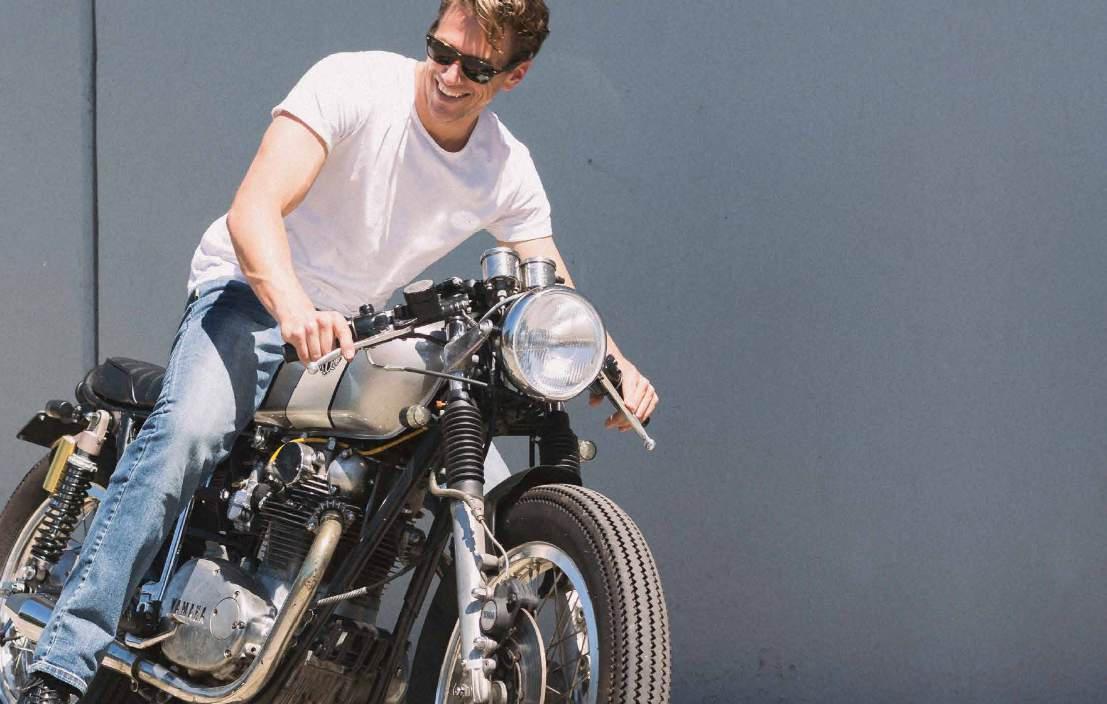

Pump up your tyre the easy way
There are two reasons for carrying a tyre pump. First, and probably most often, to return tyres to road pressure after you’ve lowered it for off-road conditions and second if you’ve just fixed a flat. I put the off-road use first because we very rarely get flat tyres now we have modern tubeless hoops. Oh, all right, three reasons: if you sleep on an inflatable mattress (or have an inflatable tent!) when you’re camping.
Tubeless tyres have also made the job of fixing flats much easier, and there are several convenient methods of patching the hole; the choice is yours. When it’s patched, however, the tyre still needs to be refilled. While you can use a hand pump (strenuous) or CO2 cylinders (fiddly) I prefer an electric pump. Until recently, I carried a MotoPressor Pocket Pump from Rocky Creek Designs, but that has been retired in favour of this new item from the same supplier.
The MotoPressor Pocket Pump V2 does not look like the original version, which was kind of basic. The V2 has a slick housing instead, and while it is
smaller and lighter it is just as powerful. It still pumps over 130psi and will inflate a 150/70 R18 tyre from zero to 31psi in three minutes. All with a weight of 345g and size of 100x74x35mm. It has a cooling fan and comes complete with an inflation hose and a two-metre power cord fitted with an SAE connector. There’s also an SAE-equipped set of alligator clips if you don’t have an SAE connector on the bike. All this fits in a neat zipped and padded pouch.
One thing the V2 pump does not have is a pressure gauge. Instead, there is a pressure checking valve. Just attach your tyre pressure gauge (you do carry one, don’t you?) to this to, er, check the pressure. The pump kit has

This premium jump starter pack offers power anywhere, anytime, ensuring that you are never left stranded. An important piece of emergency kit, it can start motorcycles, watercraft, ATV/UTV and petrol car engines up to 5.0L. In addition, it can charge your phone or tablet, providing essential functionality when you need it most.
The complete kit weighs 715g and packs neatly into a carry case (184x140x70mm). Boasting a battery capacity of 10,000mAh and a starting current of 500A, this jump starter pack is the perfect tool for any road-trip.
RRP $198.95
Available from Rocky Creek Designs and their Distributor, Pro Accessories www.rockycreekdesigns.com.au

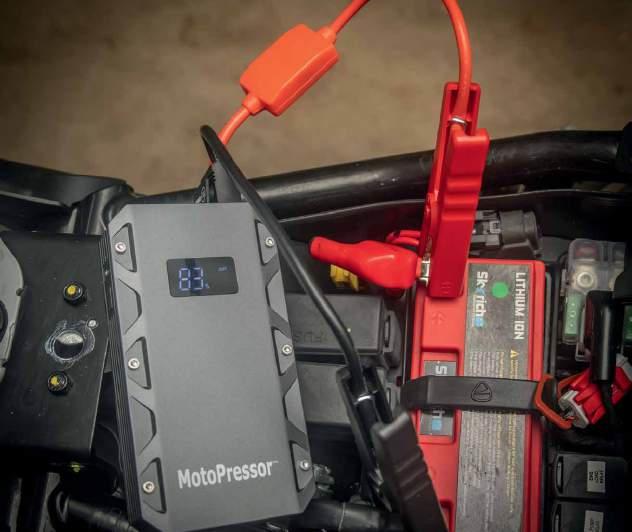


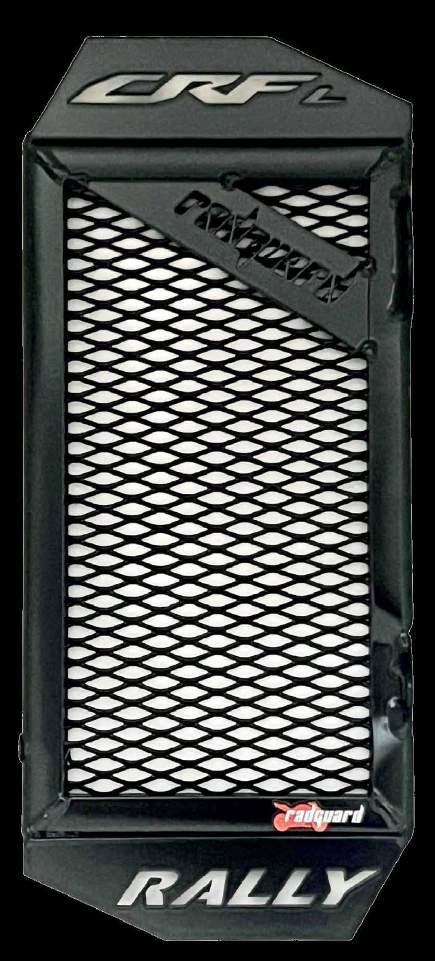
An essential aftermarket part
R For the hardcore adventure rider
R Easy to fit
R Fitting instructions provided
R Lightweight and doesn’t restrict airflow
R Made from 6060 T1 – T5 aluminium
R Available in Black and Polished Aluminium
R Three-year worldwide warranty
R Australian made
RRP: $245
On sale for: $195
Available from: Rad Guard Australia
P: (02) 6658 0060
www.radguard.com.au
• Heavy Duty
• Ultra-compact
• Fast inflation
• Weighs only 345g and measures 100 x 74 x 37mm
• Pumps over 100psi




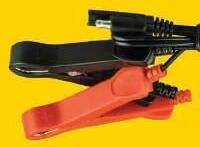









• Ideal for inflating motorcycle, ATV, UTV, car and bicycle tyres. Pumps from 0 to 130PSI and will inflate a 150/70 R18 tyre from 0 to 36psi in under 5 minutes.
• Lightweight and portable, simply connect it to a 12 volt power source, attach the filler hose to your tyre, switch ON and let the pocket pump do the work for you.
• There is a built-in “Pressure Checking Valve” on the pump. Attach your personal pressure gauge to the valve and check the tyre pressure at any time. Continue pumping to add more air OR depress the valve core to release air.
is part of the joy I

Whether it’s around the world or a quick overnighter to the land of sticky carpets and Parmies, putting the plot together is always exciting. Decisions around where to go are often misunderstood by them-as-don’t-ride. We get asked “Where are you going?” … We shrug and reply something similar to - “Dunno, don’t care”. We may wave our arms vaguely toward a particular point of the compass, indicating a general direction we are headed in. Checking the weather and maps (and fettling a Get Lost Box for those who can cope with them), sorting through the choices of what camping gear to use or clobber to wear. Preparing the bike, shoring up Frequent Father Points and the
domestic credit account, all build the feeling. For many of us it also involves putting in a few more hours at the Salt-Mine to get T’s dotted and I’s crossed so we can do a bunk.
Add a nice slice of quality shed-time, with a couple of neck oils and phone calls to set the ‘ground-rules’ builds that delicious anticipation. If we do it frequently enough, we have a set ‘pack’. Variables come into play as we make provisions for camping, hard accommodation, single night or multiple bundles, Winter or Summer, alone or in a group.
I often find that the longer I have to get ready, the bigger the mound of gear gets piled onto my shed table. Might need item after might possibly need items seem to convince me that they should come along. Over-thinking is another trap… playing one ‘what if’ scenario after another through the shrivelled grey matter only makes the pile grow. The trap for the new
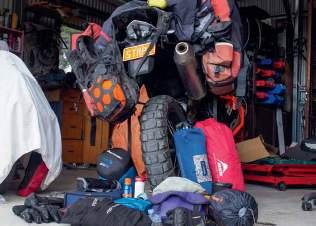
player is that they eventually end up with a small microwave and an inverter to power it. Heavy adventure bikes = sweat + fatigue.
Nutting out where each item of gear is best dealt with early – the old adage ‘a place for everything and everything in it’s place” rings true. Digging about in a bag looking for a regularly used item grows tedious very quickly.
One great rule I learnt years ago was that if an item doesn’t do two jobs, it don’t
come. Wheel nut spanners with tyre levers built in are one great example. Naturally, lightweight outdoor kit helps trim the volume and weight. Zip-off hike pants rather than jeans and a pair of shorts, natural fibres (I’m a big Merino fan – no, I have no Kiwi blood) stink less so you need fewer spares and often pack smaller. Many’s the time I’ve bought a T-shirt and consigned one to the tool kit. I get a souvenir, a good rag and a clean shirt in one move.
Whether it’s a stress relieving one night escape, a fortnight’s trek into the boonies or a trans-continental expedition, immersing ourselves in the process of getting ready to go is something to be savoured.
And… I’ve stopped making the mistake of carefully closing my bags the night before I leave. It always ends in swearing as I realise I’ve missed something important.






